A silence louder than words

TAYLOR MOORE 14
ByHow allegations of sexual abuse exposed cracks in the foundation of Chicago’s spoken word community



TAYLOR MOORE 14
ByHow allegations of sexual abuse exposed cracks in the foundation of Chicago’s spoken word community

Our Parks wants to put the brakes on the Obama Center groundbreaking.
26 Circus of Life Teatro ZinZanni reopens its downtown spectacle.
28 Center Stage Sea storm at Cabinet of Curiosity
29 Reid | Review The Tempest on a trash heap
42 Chicagoans of Note Justice Hill, producer, keyboardist, and songwriter
44 Early Warnings Rescheduled concerts and other updated listings
04 Sightseeing Dr. Cyrus Teed’s cult-like religion attracted death threats and broke up marriages in late 19th-century Chicago.
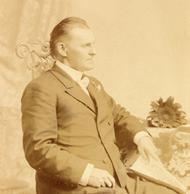
06 Rhodes | Sex WFH Several have made the leap into adult entertainment using websites like OnlyFans.
14 Investigation How allegations of sexual abuse exposed cracks in the foundation of Young Chicago Authors, Free Write Arts & Literacy, and the city’s spoken word community


22 Reading New and upcoming book releases from Chicago authors and publishers

08 Sula | Review Habrae Cafe has your good luck Thai sweets.
10 Joravsky | Politics Aldermen kick-start the backstabbing process of ward reapportionment.
12 Isaacs | Culture Protect
A CHARISMATIC PERSON somehow emanates levity, intimacy, and self-assuredness, all at once. Charisma is talked about like it’s an inborn quality—but I think it’s something that’s summoned. My story this week is born, in part, from a desire to understand what charismatic people are like when they’re not being watched—and who gets hurt when image supersedes reality.
In this case, two progressive arts organizations serving Black and Brown youth—Young Chicago Authors and Free Write Arts & Literacy—are reeling over allegations of sexual abuse by a former employee. Among many themes, like misogyny and the cult of celebrity, I wanted to look at the many, varied attempts at accountability and transformative justice, both the good and the bad. I did this not to challenge
30 Movies of Note Mama Weed is a compelling romp, Pig is an emotional journey, and Roadrunner: A Film About Anthony Bourdain is a heartfelt and heartbreaking portrait.
44 Gossip Wolf Fundraisers help music writer Scott Morrow recover from a gunshot, Lorna Donley and David Thomas’s post-Da band, the Veil, posthumously release several 1980s recordings, and rapperproducer SolarFive drops an album of burly underground hip-hop.
TO CONTACT ANY READER EMPLOYEE, E-MAIL: (FIRST INITIAL)(LAST NAME) @CHICAGOREADER.COM
PUBLISHER AND PRESIDENT TRACY BAIM PUBLISHER AND EDITOR IN CHIEF KAREN HAWKINS EDITOR IN CHIEF SUJAY KUMAR
MANAGING EDITOR BRIANNA WELLEN PRODUCTION MANAGER KIRK WILLIAMSON GRAPHIC DESIGNER AMBER HUFF MUSIC EDITOR PHILIP MONTORO THEATER AND DANCE EDITOR KERRY REID INTERIM CULTURE EDITOR SALEM COLLO-JULIN ASSOCIATE EDITOR JAMIE LUDWIG SENIOR WRITERS MAYA DUKMASOVA, LEOR GALIL, DEANNA ISAACS, BEN JORAVSKY, MIKE SULA STAFF WRITER ADAM M. RHODES EDITORIAL ASSOCIATE TARYN ALLEN
DIRECTOR OF DIGITAL JOHN DUNLEVY SOCIAL MEDIA COORDINATOR JANAYA GREENE
STRATEGIC INNOVATION DIRECTOR MARIAH NEUROTH DEVELOPMENT AND MARKETING ASSOCIATE CHINYERE FARR-DOUGLAS MEDIA PARTNERSHIPS COORDINATOR YAZMIN DOMINGUEZ EXECUTIVE ASSISTANT SANDRA L. KLEIN MEDIA PARTNERSHIPS AND DEVELOPMENT ADVISOR ABHIMANYU CHANDRA
ADVERTISING
312-392-2970, ADS@CHICAGOREADER.COM
32 Feature Lovesliescrushing make shoegaze for a parallel universe.

36 Book Excerpt Punks in Peoria: Making a Scene in the American Heartland takes us back to central Illinois in the 1970s.
38 Shows and Records of Note Previews of concerts including Wynonna Judd & Cactus Moser, Drama, and Bitchin Bajas, plus reviews of releases by G Herbo, DJ Manny, King Woman, and more
46 Savage Love Dan Savage responds to a letter with too many “unwilling cuckold fantasy” tropes.
52 Jobs
53 Apartments & Spaces
53 Marketplace
CLASSIFIEDS:
CLASSIFIED-ADS@CHICAGOREADER.COM
VICE PRESIDENT OF SALES AMY MATHENY SALES DIRECTOR AMBER NETTLES SENIOR ACCOUNT REPRESENTATIVES LENI MANAA-HOPPENWORTH, TED PIEKARZ, WILL ROGERS, LISA SOLOMON
NATIONAL ADVERTISING VOICE MEDIA GROUP 1-888-278-9866 VMGADVERTISING.COM
JOE LARKIN AND SUE BELAIR
WORK, GO TO WESLEYH.COM.
the value of community-based healing—you will notice that “cancel culture” does not appear anywhere in my story—but to document how messy and surprising and nonlinear it can be.
A question I raise in the piece (“What happens when abusers and enablers use this process to their advantage?”) is something I grapple with. There are many people who have been thinking about these questions longer than me, and I won’t pretend to be an expert. In the story, I did my best to examine the harm that occurs when language is warped, vulnerability is exploited, and real people are treated as collateral damage in the quest to protect institutions. In the same way the organizations I covered are trying not to look away, I also tried not to look away. —TAYLOR MOORE
DISTRIBUTION CONCERNS distributionissues@chicagoreader.com

312-392-2970
CHICAGO READER L3C BOARD PRESIDENT DOROTHY R. LEAVELL TREASURER EILEEN RHODES AT-LARGE SLADJANA VUCKOVIC
READER INSTITUTE FOR COMMUNITY JOURNALISM, INC.
CHAIRWOMAN EILEEN RHODES
TREASURER CAROL BELL DIRECTORS ALISON CUDDY, VANESSA FERNANDEZ, KIM L. HUNT, JACKIE KAPLAN-PERKINS, DOROTHY R. LEAVELL, SLADJANA VUCKOVIC
READER (ISSN 1096-6919) IS PUBLISHED BIWEEKLY BY CHICAGO READER L3C 2930 S. MICHIGAN, SUITE 102 CHICAGO, IL 60616 312-392-2934, CHICAGOREADER.COM
COPYRIGHT © 2021 CHICAGO READER PERIODICAL POSTAGE PAID AT CHICAGO, IL ALL RIGHTS RESERVED. CHICAGO READER, READER, AND REVERSED R: REGISTERED TRADEMARKS ®




COURTESY THE STATE LIBRARY AND ARCHIVES OF FLORIDA
Dr. Cyrus Teed’s cult-like religion attracted death threats and broke up marriages in 19th century Chicago.
 By JEFF NICHOLS
By JEFF NICHOLS
On May 18, 1892, a lawyer addressed a packed Englewood auditorium. The issue was whether to form a mob to remove their new neighbor, Dr. Cyrus R. Teed, or to let the law take its course. “Let us say that there is one spot in the State of Illinois where such a devil cannot exist,” E.S. Metcalf told the crowd. “Don’t talk about tar and feathers tonight; they will come later.” Speakers told stories of how wives had abandoned their families and turned over all their assets to Teed. Admitting his past desire to shoot Teed, another ex-husband told the approving crowd that “No jury would have held me accountable for his death.”
Teed had taken an unusual path in his journey of becoming one of the most gleefully reviled Chicagoans of the late 19th century. Perhaps if he had lived today, the Internet would have provided a more comfortable
outlet for his unusual scientific and religious beliefs. Born in 1839 in Teedville, New York, a village founded by a well-o ancestor, Cyrus left school at eleven to work on the Erie Canal. After serving in the Union Army, he studied to become a doctor of eclectic medicine, a new medical field which emphasized botanical and other noninvasive remedies.
Teed, like many eclectic doctors, also believed in alchemy. He later claimed he discovered his life’s mission while tinkering in his laboratory in Utica. Discovering the secret of transforming base metals into gold, he fell into a rapturous trance. Teed was visited by “the Divine Mother.” “I have nurtured thee through countless embodiments,” the spirit explained.
“Offspring of Osiris and Iris, behold the [revealing] of thy Mother.”
Preaching across New York, Teed made a futile attempt to build a religious movement
based on his revelations and idiosyncratic medical theories. In 1886, one of his few admirers o ered to pay his way to a convocation of “mental healers” in Chicago. Held in a deconsecrated church that also housed a candy factory, the convention of the Mental Science National Association was so enamored of the rumpled but supremely confident doctor that it elected Teed its new president. Abandoning his invalid wife back in New York, Teed founded his own school, the World’s College of Life, and his own religion.
Calling himself by the name of Koresh, Teed taught that the body could heal itself through a “scientific” reading of a hodgepodge of ancient texts. In February 1888, Teed’s reputation as a kooky doctor took a dark turn with the death of Fletcher Benedict, the husband of a devoted follower. Benedict, who had believed Teed’s ideas were “humbug,” didn’t respond to Teed’s treatment for pneumonia, which consisted solely of prayers. “What if he does die?” Teed told Benedict’s distraught landlord. “I have been dead a dozen times.” At the coroner’s inquest, Teed claimed “Koreshan science” could cure “cancer, consumption—anything.”
Teed’s prosecution for practicing medicine without an Illinois license didn’t deter his core disciples, most of whom were women. The former child laborer spoke out against capitalist exploitation and materialism. His message of communal life o ered a radical break from the confines of traditional households. Teed consistently preached a message of gender equality. “Woman, the world over, is born disfranchised,” commented Teed’s paper, The Flaming Sword. Man “makes all her laws and she has no rights that he does not provide and control.”
Teed rejected not only patriarchy, but all forms of sexual desire. The Koreshans would achieve immortality through a prophesized “conflagration of males and females,” emerging as neuter superbeings. Teed hated established Christian churches because they sanctified heterosexual marriages, which only perpetuated the cycle of reproduction and death. Churches also had refused to accept Teed’s reading of the Bible and other sacred texts, which showed that a man exactly like Teed would become God’s final prophet.
Shortly before Teed’s sect moved to a mansion in Washington Heights and into a block
FOR MORE ON DR. CYRUS TEED: Read The Allure of Immortality by Lyn Millner (University Press of Florida, 2015) and American Messiahs by Adam Morris (Liveright, 2019).
of flats in Englewood, Teed predicted that he would be killed by the angry husbands of his female followers, but would become, in his words, “theocrasized,” which would allow him to lead his flock in astral form. A boy found a bomb near Teed’s mansion. While his new neighbors feared how the Koreshans would bring down property values, they ultimately chose not to risk jail time to remove Teed.
By 1893, there were about 160 believers in Koreshanity in Illinois. Teed crisscrossed the country, attempting to win new converts to bring back to Chicago, where they would be treated like deranged cult members. Despite an avalanche of negative national press, Teed remained candid in his ambition to build a worldwide theocracy. Koresh created a new calendar, the first year being his birth year.
“The Universology of KORESH is the genuine science of all truth, the solution of all problems, the explanation of all phenomena,” the Flaming Sword exclaimed.
If Teed’s odd theology wasn’t enough, a key element of his evangelism was the goal to prove that humanity lived inside the Earth. According to Teed, the Earth was hollow, with the sun, powered by precious metals of the earth’s crust, sitting at its center. Nighttime could be explained by the fact that the rotating sun was black on one side. The moon was an “x-ray picture” of the earth’s surface projected on the atmosphere, while the stars were “focal points of light.” The appearance of ships disappearing on the horizon was only an optical illusion, gravity explained by the existence of “gravic rays.” The Koreshans dutifully ran their own experiments, including one involving telescopes mounted on rowboats floating in the Old Illinois Drainage Canal.
After 17 years of surviving Chicago, Teed was unsuccessful in convincing his adopted hometown to abandon a Copernican worldview, give up sex, and accept Koresh as their personal savior. The Koreshans left wicked Chicago for undeveloped Estero, Florida, where Teed envisioned building a holy city with a population of 10 million. When Teed died in 1908, his followers propped him up in a bathtub. Days into waiting for Koresh’s resurrection, the county health o cer insisted the great prophet be interred. Even after a storm blew away Teed’s crypt in 1921, his church soldiered on. The last Koreshan passed away 11 years after men landed on the Moon, an event that some today believe is but a sinister hoax.
When Koreshan science invaded the south side


























Several Chicagoans have made the leap into adult entertainment using websites like OnlyFans.
By ADAM M. RHODESSome people found new hobbies during the pandemic, like making bread or crafting. Some took the time to work on themselves, and are now sporting new clothes, piercings, tattoos, or identities. Some did some spring, winter, fall, and summer cleaning. And some made the leap into the exploding world of online sex work.
More than just a Beyoncé lyric, OnlyFans is a massively popular fan site that gained prom-
inence hosting adult content. It’s now reportedly worth more than $1 billion. And with the popularity of the platform and other sites like it have come a proliferation of everyday folks making creator accounts. It’s a phenomenon that turns some assumptions about sex work on their head: work once taken out of desperation has become an increasingly popular side hustle.
Local creator Jamie Wolf (a performing
name, as are the names of the other content creators mentioned in this story) tells the Reader that he created his OnlyFans in May 2020, soon after COVID-19 lockdowns went into e ect across the country, but after he was “well into” making adult entertainment as an amateur performer. Wolf uses the platform and others like it to supplement his income and says he likes the flexibility and anonymity that can come with having agency as an amateur adult performer. He says his other employer doesn’t know about his account, but is confident he wouldn’t face any consequences if they found out.


“I don’t think I would have signed with a studio or gone the traditional professional route,” says Wolf. “I enjoy my privacy as an amateur performer. And not out of fear of exposure. I literally enjoy exercising my right to privacy.”
The COVID-19 pandemic and its disastrous economic impacts for many also created a perfect storm of sorts for fan sites, giving people a way to make some money amid record-high rates of unemployment. But even absent a pandemic, the platforms can be an important outlet for performers who want more control over their work.
Chicago-based adult performer Griffin Barrows says unlike studio work, which often entails signing contracts with studios that have enormous control over the adult film productions, platforms like OnlyFans give the performers themselves a previously almost unheard-of level of agency over their own content.
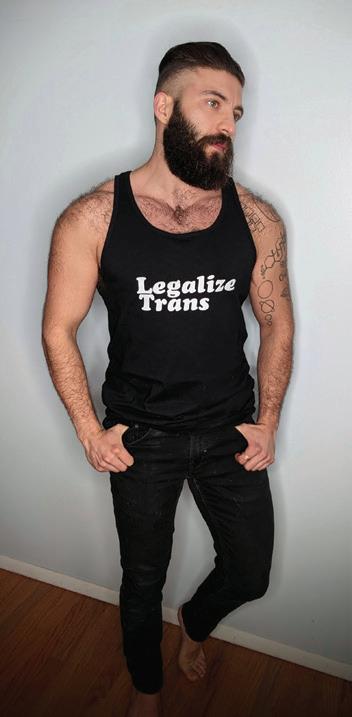
Barrows, who boasts more than 675,000 Twitter followers, has more than 500 videos


100%

on his OnlyFans page and is arguably one of its most recognizable gay male creators.
“Many performers brag on social media about doing nearly nothing except some flashes of erogenous body zones, and thereby propagate the idea that producing content is hardly work at all,” Barrows says. “In reality, lots of time and effort is spent in this sexy career.”

In addition to allowing for more creative control by their users, the platforms have been a particular boon to people who don’t fit the mold that most studios seek to promote.
Trip Richards, a trans man, says OnlyFans and platforms like it have allowed adult entertainers from historically excluded backgrounds in particular to thrive in the industry without being forced to endure fetishization or outright exclusion from popular studios.
“[The platforms are] putting the power back with us as individual performers, and what that ends up meaning is that the performers are more diverse and more equitable than ever,” Richards says. “This also addresses many of the concerns about coercion that have been leveled against the adult industry.”
Misconceptions abound about doing sex work via OnlyFans and other platforms. But many creators, from amateurs like Wolf to industry mainstays like Barrows, say the biggest misconceptions about these platforms go hand in hand: the earning potential and the level of work it takes to make those earnings.


“While OnlyFans does allow me a slight bit more financial mobility, it does not at all fulfill my monetary needs in totality, especially with how the earnings are released, which isn’t very accommodating if you’re not already

of Profits go toward Homelessness prevention and assistance programs in Illinois.
financially secure and are relying on this kind of sex work to survive,” Wolf says.
Barrows also points to another common misconception: that there are droves of creators raking in exorbitant profits every month.
“A handful of people did make fortunes in months, but it really was a mere handful,” Barrows says. “It often takes months to make a livable income, and years to make a solid one.”
And the platform itself isn’t without its problems. The interface can be clunky and hard to navigate as a user. The site also takes a 20 percent cut of creators’ earnings and has a list of sex acts it won’t allow creators to perform on the platform—like “sadomasochistic abuse or hardcore bondage” and “urine,” common kinks themselves. Those prohibitions are included in legal standards that prevent users from publishing outright violence like torture and rape on the platform.
The site has also been called exploitative by many in the adult industry, particularly after actress Bella Thorne reportedly pocketed millions from the site in a week after she made an account.
Many agree that OnlyFans and sites like it have certainly democratized sex work, giving more people access to an industry known previously for “casting couch” auditions and restrictive contracts.
But popularity of the platforms aside, Barrows and Wolf also agree that even “legal” sex work is still not a truly accepted and destigmatized form of work or even hobby—yet.
“There are plenty of stories of people facing undue consequences after being outed as OnlyFans creators,” Wolf says. “I think it is important to recognize that the only thing that will help protect and value sex workers is sex-worker-positive legislation.”
And Richards is quick to point out that those consequences disproportionately affect the marginalized groups that have been able to engage in safer forms of sex work on fan sites.
“Any legislation or criminalization or loss of platforms or anything that a ects sex workers does not a ect everyone, it really specifically is a ecting disproportionately marginalized groups, like people of color, people with disabilities,” he says.
Alongside those concerns is the news that London-based OnlyFans, which is owned by technology company Fenix International Limited, is also rumored to be distancing itself

from adult content.
But the platform’s biggest competitor, JustForFans, is owned and operated by adult entertainers and there are no plans to change that, says its founder Dominic Ford. Ford has a 13-year-long career in the gay adult entertainment industry and founded JustForFans roughly a year and a half after OnlyFans was founded in 2016. Unlike OnlyFans, Ford readily and proudly describes JustForFans as a “porn site.”
In that vein, Ford says the site is staffed entirely by people either doing on-camera or behind-the-scenes work in the adult industry. He says that makes his site much friendlier and more holistic than OnlyFans, because he and his sta all have personal experience with the needs of not only performers, but also commonly forgotten but still crucial industry professionals like producers, directors, and agents.
As a creator, Richards lauded the site for having fewer content restrictions than OnlyFans, and the payment processors to which they are beholden.
Also unlike OnlyFans, and in what Ford says is a first for the adult industry, JustForFans allows creators on the site to donate a percentage of their earnings to charity. According to the JustForFans website, creators have donated more than $75,000 to causes and organizations including Black Lives Matter, Trans Lifeline, The HIV League, Sex Workers Outreach Project-USA, and the Free Speech Coalition. Ford says that’s just another part of the community-focused ethos of the platform.
But even as Ford tries to set JustForFans apart, he seems almost surprisingly eager to hear the news that OnlyFans is abandoning its roots in favor of more mainstream success. It’s a phenomenon he says the adult industry is more than used to, but one he says will just help JustForFans and other loyal platforms thrive.
“We, as adult industry performers and business people, are sick and tired of (but used to) technology companies starting up, cutting their teeth on adult [content], making money, ironing out their bugs, and then leaving us once they don’t need us anymore,” Ford says. “OnlyFans is not the first, it will not be the last.” v @byadamrhodes
lather languish in our open arms. we feed each other shame say same !! and scream if there is language, let it aim towards the juice, invitation over blame or flight, we stay in this marsh of how and pray—oh feast, oh, nervous unblossoming: again again—hurtle me towards re-bodying. Somewhere along the line, I stopped grasping for what I wanted, and now we game
systems of control: wanting and consumption, famine and abundance, how they suck on each other’s frames
grasping for the pots of each other’s pleasure, thumbing into the vein for a hitch or ranging scream if there is terror,
let it be touched; look and lick it soft if there are gods, let them leave room for shame say same, and my name; my name.
Tara, if there’s a release to resist I’ll keep what’s mine, sleep curled around my bodies bright with shame.
Tara Jayakar is the founder of Raptor Editing & Press. Their work has been published in The Shoreline Review, Yes Poetry, and Hobart, among others. A poet and editor, she lives in Brooklyn.
Poem curated by Xandria Phillips: Xandria Phillips is the author of HULL (Nightboat Books, 2019), and the recipient of a Whiting Award. They have received fellowships from Brown University, Oberlin College, and The Wisconsin Institute for Creative Writing, and are the 20212023 Poetry Fellow at the Center For African American Poetry and Poetics.
A biweekly series curated by the Chicago Reader and sponsored by the Poetry Foundation.





A couple introduce Forest Park to Thai desserts, old and new.

 By MIKE SULA
By MIKE SULA
When Ussanee “Au” Sanmueangchin moved to Berwyn nine years ago to study English, she missed the taste of sticky rice and black beans in sweet coconut milk. She grew up eating this dessert in Bangkok, but in Chicago khao niao thua dam was nowhere to be found. She asked her mother for help, and found some recipes online, but it just wasn’t the same.
“She tried so hard to get the taste she was used to,” says her husband, Jumpol “Jump” Prasitporn, who was working as an IT con-
sultant when they began dating. After Au (pronounced “oo”) finished her studies and returned home to Bangkok, they maintained a long-distance relationship while her Chicago dessert privation ignited a passion. She began taking short courses at Bangkok’s UFM Baking & Cooking School (an operation backed by the trade group U.S. Wheat Associates to convince Thais to use more flour).
Sanmueangchin studied both classic French and Thai pastry techniques and recipes, particularly the large category of egg-based
sweets that arose in Thailand at the start of the 18th century during the tenure of Maria Guyomar de Pinha, a Japanese-Portuguese-Bengali woman enslaved in the palace of Siamese King Phetracha. De Pinha, who rose from cook to the head of the king’s kitchens, introduced the royal sweet tooth to eggs and refined cane sugar, among other new ingredients and methods.
“Prior to that, it was just rice and rice flour, coconut, and sugar, cooked mainly by steaming, boiling, or stirring for hours in a brass pan
into a thick pudding,” according to food writer Leela Punyaratabandhu.
De Pinha developed a number of now classic desserts based on Portuguese antecedents, such as khanom mo kaeng, an eggy coconut milk and wheat flour custard topped with crispy fried shallots; and foi thong: golden threads of yolk boiled in syrup, one of nine “auspicious” sweets served on special occasions. Many of these yellow-colored eggy desserts form a branching family of variants frequently designated with the prefix thong,
meaning golden.
Sanmueangchin started a baking business with a friend, but when she and Prasitporn got married in 2018 she settled in with him in Berwyn. In the U.S. plenty of home cooks make and sell khanom (desserts or snacks) to other Thais informally, and their work often shows up on the shelves of the city’s Thai groceries, though supply can be inconsistent. Uptown’s Thai Pastry has carved out a niche in khanom in addition to its sprawling lunch and dinner menu.
Sanmueangchin and Prasitporn started planning a shop fully dedicated to Thai sweets and snacks in the near western suburbs. Originally they tried to rent a place but instead decided to buy a former Mexican joint on downtown Forest Park’s busy Madison Street bar and restaurant row. They closed on it March 30, 2020, two weeks after Illinois’s first restaurant shutdown.

That added a full year to their July opening date but left plenty of time to design the space to resemble a traditional wooden-walled Thai kitchen adorned with bamboo threshers and baskets. Earlier this month, they soft-opened Habrae—meaning a street hawker and also the basket she carries—with a collection of around 14 Thai sweets, many debuting in the midwest for the first time. Sanmueangchin says she has some 50 sweets and snacks in her repertoire and plans to introduce more of them gradually, along with some savory dishes here and there.
For now there’s a trio of strikingly colored puddings, each topped with a thick layer of coconut cream: green, fragrant pandan; purple ube; and a Stygian khanom piak pun kathi sot, made with charcoal, a more spoonable version of a dessert traditionally made with burnt coconut husks for smoky flavor. Another rarity in the case is khanom thuai, a jiggly disk of smooth coconut pudding floating in a reservoir of cool, pandan-scented coconut milk, lightly sweetened with palm sugar.
“Some of these are very old-fashioned desserts that are rare in the U.S. and becoming rarer in Thailand too,” says Punyaratabandhu. “They can be found more easily at fresh markets in rural areas. In a city like Bangkok, you have to zero in on a few stores that specialize in traditional Thai desserts. It’s a dying art.”
These and other sweets underscore the
importance of snacking onsite at Habrae. According to Prasitporn, the khanom thuai should be served at room temperature or slightly warmed, but he prefers the other puddings just below room temperature to fully appreciate their flavors. If you want to take home a more aromatic khanom pang-sangkhaya set, the couple will tell you how to rewarm the sweet chunks of steamed brioche-like bread to dip in pandan and sweet tea-flavored custards. Pop soft, steamed salapao—cousins of baozi they’ve dubbed “buddy buns”—in the microwave for 20 seconds and it will render their sweet salted egg filling like lava. But they’d prefer to do that for you while you linger over iced co ee, creamy milk tea, or maybe a royal-purple butterfly pea flower lemonade.
A few sweets illustrate the Thai facility for making foreign dishes entirely their own, such as a flakey croissant filled with salted egg yolk custard, and Khanom Tokyo, a thin crepe rolled around pandan custard that’s a take on Japanese bean paste-stu ed dorayaki. (In Thailand these are also commonly sold on the street filled with minced pork, quail eggs, and cocktail weenies).
Sanmueangchin’s light chi on cake topped with taro root custard is another of those indirect descendants of de Pinha’s custardy khanom mo kaeng, which is also expressed at Habrae as a simple, soothing taro root custard; or khanom mo kaeng phueak, the first part of both names indicating “‘a dessert made in a curry pot’—most likely the only baking vessel available in 17th century Siam,” according to Punyaratabandhu.
The heart of the menu really is these older, rarer desserts, like a version of the popular coconut sticky rice with mango, but instead topped with crispy dried tuna flakes, shallots, and sugar; or the “siblings,” as they call them, fudgy-textured, coconut, rice flour-and-palmsugar steamed cakes flavored with ube, kabocha, or banana.
Maybe the most labor-intensive sweet on the menu at Habrae is the khanom chan, blossom-shaped steamed cakes ideally built in nine layers of alternating colors. It’s one of those nine auspicious desserts, and it’s particular fun for kids to pull apart layer by layer, according to Prasitporn. At Habrae Cafe, he says they really only have time to make khanom chan with three layers, but with proper ordering you can make the math lucky:
“If you have three pieces it’s nine layers, you know.”
@MikeSulaJumpol “Jump” Prasitporn and Ussanee “Au” Sanmueangchin are offering sweets both auspicious and rare. SANDY NOTO FOR CHICAGO READER
Also thanks to redistricting, the Second Ward now contains most of the near north side’s aging industrial properties, which are on the verge of being redeveloped as high-end residential and commercial.
Thus in one fell swoop, the City Council punished Fioretti and made some developers even more fabulously wealthy than they already were. As making rich people even richer is what makes Chicago’s world go round.
As practical as it sounds, there are drawbacks to having computers blindly redraw the wards. For one, it cuts out the aldermen from having a say. Which is not really a problem to anyone other than the aldermen. But still.
Which, now that I think about it, is pretty much the point.
Also, over time I’ve come to the conclusion that the concept that one race will only vote for itself is outdated.
It’s never really been true when it comes to Black residents, who have always been far more tolerant and open-minded than their white counterparts.
With the City Council-led process known as reapportionment ready to begin, the time has come for me to o er my guide to ward mapping.
Take notes—it’s on the test . . .
The constitution’s equal protection clause requires that no political district has significantly more residents than another because that would be unfair, and would violate the sacred principle of one man, one vote.
It’s a sacred principle that’s ignored in presidential elections, as the 600,000 people of Wyoming have much more influence when it comes to electing a president than the 39.5 million residents of California.
So we care more about sacred principles when it comes to electing Chicago aldermen than presidents. I can’t justify our system— only try to explain it.
To guarantee equal representation, we reapportion the city’s wards every ten years after the census tells us roughly how many people currently live in the wards as they were redrawn ten years ago.
The census just ended. So get ready for the council vote on a new map later this fall—with,
no doubt, lawsuits to follow. More on those in a later column.
Chicago has roughly 2.7 million residents and 50 wards. So we have to draw a map in which each ward has about 54,000 people. We could simply program a computer to divide the city into 50 similarly structured, square-shaped wards created without regard to class, race, ethnic, or corporate considerations.
Or we could put 50 aldermen in a back room and let them do their thing.
And that means looking out for number one by cutting deals in which they get to keep the precincts that vote for them and dump those that don’t, resulting in wards that look like amoebas. And occasionally stabbing one another in the back.
Like what happened in 2011, when they punished former Second Ward alderman Robert Fioretti for, among other things, the high crime of making them look bad with showboating rhetoric.
By the time they were done redrawing Fioretti’s Second Ward, he no longer lived in it. That’ll teach you, Fioretti!
For another, it does away with the concept of wards drawn to guarantee the election of Black or Latino aldermen by creating supermajorities of Black and Latino residents.
This requires another one of my famous history lessons. So here goes . . .
Traditionally, white people in Chicago would never vote for a Black person for alderman on the grounds that they, the white people, were super prejudiced against Black people. Not sure how else to put it.
To make sure that some Black aldermen were elected—and that Black residents would not have to be subjected to white aldermen who were hostile to Black people—the courts demanded that the council make sure there were at least some wards that were majority Black. And that the percentage of Black aldermen in the City Council more or less equaled the percentage of Black people in Chicago.

As a result, Chicago has had about 20 Black aldermen—though how that’s helped any Chicagoan, Black or white, over the last 30 years is hard to say.
When it comes to citywide council issues, there’s not much difference between how white and Black aldermen vote. With a handful of exceptions, they generally voted however Mayors Daley or Rahm instructed.
In fact, going back to the days of old man Daley (that’s Richard J.), the Black aldermen were rather ignobly known as the Silent Six, in that there were six of them who rarely spoke unless it was to praise Mayor Daley. Then they couldn’t stop speaking.
So when you think about it, what has anyone in Chicago gotten from segregating the races other than, you know, segregating the races?
Black voters in the Fifth Ward consistently voted for white aldermen like Leon Despres and Larry Bloom over Black challengers. Also, Black voters in the 18th Ward elected Thomas Murphy, a white man, even after their ward was redrawn in part to help a Black candidate get elected.
But white people voting for Black candidates over white candidates? That’s a relatively new phenomenon. First time I noticed it was in 2010 when Toni Preckwinkle won the Democratic nomination for Cook County board president in a race in which she was one of three Black candidates running against one white guy, Terrence O’Brien, who had an Irish name to boot.
OK, that’s not an aldermanic election, but, yes, some things have changed.
Would there be less council subservience to the mayor if we went to a computer-drawn map? Well, it’s hard for the council to be more subservient unless we officially change to a monarchy.
For instance, in 2011 the City Council unanimously voted for Mayor Rahm’s wretched budget. That’s the one that closed mental health clinics in high-crime neighborhoods, thus contributing to the madness and carnage that has followed.
The aldermen voted for the budget in part because they didn’t want Mayor Rahm working to eradicate them in the reapportionment that followed the budget vote. You might say they didn’t want to be Fiorettied.
As you can see, it’s challenging to defend our current mapmaking process. On the other hand, it’s entertaining—especially for someone who hosts a podcast about Chicago politics.
If I can’t save Chicago from itself, I might as well be entertained.
Let the mapmaking begin . . . v
@bennyjshow
Believe it or not, it is better to let the folks who occupy these seats draw ward maps than a computer. RAED MANSOUR / FLICKR
In a sprawling metropolis like Chicago, it can be all too easy to become disconnected from nature, and more specifically where our food comes from. But for more than a century, a community of Chicagoans has gathered at the Rainbow Beach Victory Garden to put their green thumbs to work feeding their families and neighbors, and forging connections across generations, genders, and ethnicities.
Event info: Community Gardens as Neighborhood Resources


Rainbow Beach Park Fieldhouse
Saturday, July 24, 2021
10:30 AM - 1:00 PM CST

This Program is part of CHF’s Neighborhood Initiative.

The term “victory garden” is associated with World War I and World War II, when the United States government and their allies encouraged their citizens to grow fruits, vegetables, and herbs in public parks and private spaces to supplement their wartime rations and increase homefront morale. The original garden on the south side was created in 1917 and was tended to by members of the thriving steel community, primarily by European and Latinx immigrant workers and their families.
“Very much like how vacant land is being turned into community gardens now, people used to use property that was owned by a company that encouraged community among its workers,” says Olga Arias, who began gardening at Rainbow Beach 15 years ago. In 1942, the garden was purchased by the city, which made it part of the south side’s Rainbow Beach Park and gave it its present name.
As the oldest and largest of Chicago’s 80 community gardens, Rainbow Beach Victory Garden is still going strong. It’s seen renewed interest as the local foods movement has gained steam, and more recently when the COVID-19 pandemic hit the U.S. “[Victory gardens] actually became very trendy again last year during COVID-19,” Arias says. “You heard it on the news, ‘People are starting victory gardens,’ but a victory garden shouldn’t exist only during a tough time.”
Due to limited space and resources, Rainbow Beach Victory Garden is currently limited to 58 members, though they keep a waiting list of applicants. The average membership is 20 years, and some of the most experienced gardeners are octogenarians who have come back every season for more than four decades. Among the newer members is a second-generation Rainbow Beach Victory Gardener—his father and uncle brought him to the garden as a small child, and now he does the same with his kids.
The tight-knit group reflects the ethnic diversity of Chicago’s south-side neighborhoods (though a few gardeners travel from as far as northwest Indiana), and members embrace their cultural differences as much as their shared passion for gardening. They swap gardening tips and family recipes, and host events, such as cooking demonstrations to teach each other how to use ingredients some might be unfamiliar with. “We did a salsa recipe festival a few years ago, because that’s across ethnic groups in our garden. Everybody loves salsa, but everybody makes it differently,” Arias says.
Rainbow Beach Victory Garden is generally restricted to members only, but they’re known to give tours to friends or passersby. “People are always impressed the first time they walk into the Rainbow Beach garden because of its size, the meticulous maintenance of our plots, and the beauty—you’re just surrounded by beautiful flowers and trees and fruit trees,” Arias says.
On July 24, Rainbow Beach Victory Garden will participate in the Chicago Humanities Festival with a program called Community Gardens as Neighborhood Resources. The event will include a panel discussion about the importance of community gardening on the south side, guided tours, demonstrations, and more.


“I think this event is going to show people how connected and how engaged our communities are, and how that happens in the garden,” Arias says. “And what do you get in the garden? You get food, and where does food go? It goes on a table. So, we think of our gardens as this metaphor for a table where we sit around and talk about concerns and our cares. I think people will be surprised by what’s happening on the south side.”

POP wants to put the brakes on groundbreaking.
By DEANNA ISAACSPinch me: The nonprofit group Protect
Our Parks was back in court this week attempting to keep the Obama Presidential Center out of Jackson Park.
POP’s attorneys are asking for a preliminary injunction to prevent roadwork, tree-clearing, and other “groundbreaking” activity scheduled to begin as soon as next month.
The situation is urgent, they say, “Because these groundbreaking activities will cause permanent and irreparable harm.”
In a Groundhog Day scenario, this is playing out in the same court where they began arguing against the Jackson Park site in 2018, before the same federal district judge, John Robert Blakey.
Judge Blakey dismissed their lawsuit in 2019, and when POP appealed that decision, a judicial panel that included soon-to-be-Supreme Court Justice Amy Coney Barrett threw their case out of federal court, citing a lack of standing. By the federal court’s more stringent (than state court) standards, the plaintiffs would have to show specific personal injury, Barrett wrote. This could be hard to do if, for example, the plainti s didn’t live on the south side and were not frequent users of the park. But that was then.
“This is a whole new ballgame,” legal scholar, professor (NYU; University of Chicago emeritus), and POP attorney Richard A. Epstein says about the motion for injunction and a new federal lawsuit, filed in April.
What’s different? The list of plaintiffs, for
one thing: Protect Our Parks has been joined by a half-dozen new plaintiffs, all bona fide south-siders. They include the Nichols Park Advisory Council; author, critic, and University of Chicago professor W.J.T. Mitchell; and journalist Jamie Kalven.
You read that right: the widely respected human rights activist and investigative reporter responsible for bringing the Laquan McDonald video to light is among those suing in hopes of getting the OPC to pick a di erent south-side location.
The list of defendants has also grown, expanding from the city of Chicago and the Chicago Park District, to include former presidential candidate Pete Buttigieg, in his current role as secretary of transportation, along with top administrators from the Department of the Interior, Federal Highway Administration, National Park Service, and Army Corps of Engineers, along with the Obama Foundation itself.
POP attorneys Epstein and cocounsel Michael Rachlis want to block any OPC construction activity until the new lawsuit, which seeks a redo of federal reviews that ostensibly cleared the way for a groundbreaking, is resolved.
According to POP, the federal reviews had two fundamental flaws: first, they treated the OPC itself as a local matter, outside their purview (separating it from the roadwork it’ll necessitate); and then they failed in their duty to consider alternatives to the Jackson Park
site that could be less harmful.
POP is also relodging the complaint that was at the heart of its original lawsuit, charging (as they described it in a statement issued when they filed) that by “giving away nearly 20 prime acres of publicly-owned green space to a private entity for $10,” the city has “engaged in a breach of its public trust obligations.”
Not sure what the city’s public trust obligations are? No worries: in a stroke of great timing, just as this murky courtroom contest gears up again, a new history of Chicago’s lakefront that illuminates the legal issues and puts them in deep context has arrived. Lakefront: Public Trust and Private Rights in Chicago , published in May by Cornell University Press, is the culmination of a 20-year labor of love by two other eminent legal scholars with Chicago roots: Marquette University Law School dean Joseph D. Kearney and Columbia University professor Thomas W. Merrill.
In a phone interview last week Merrill said his interest in Chicago’s uniquely clear and spectacular lakefront goes back to a property class in his law school days at the University of Chicago in the 1970s. “I had a professor who liked to tell stories; he spent three classes on the Chicago lakefront.” Merrill said he was “mesmerized” by those stories, but confused, and when he started looking into it himself a few years later, he got hooked: “It was like a big jigsaw puzzle. I ran into Joe [Kearney; both were then at the Sidley Austin law firm] and mentioned this project and he was very enthusiastic. So we started doing the research. That was 22 years ago. It became a sort of summer project—coming back to Chicago, digging into the archives, piecing it together bit by bit.”
Their book—destined to be a go-to text for Chicago history courses—reaches back to the city’s origins as a potential port. It covers Aaron Montgomery Ward’s obsession with protecting his (and others’) lakefront views; George Wellington Streeter’s squatter tactics on the former lake bed that became Streeterville; the astounding reversal of the Chicago River; and the bargains made with riparian owners to build Lake Shore Drive. It begins with an account of how the smoky, sooty, noisy, and opportunistic Illinois Central Railroad managed to dominate the downtown lakefront for more than a century.

When the city was new, Lake Michigan lapped up much closer to Michigan Avenue than it does now. Downtown buildings regularly flooded; a breakwater was urgently needed. The city couldn’t a ord this massive project, but the Illinois Central could. In return, in an agreement made in 1852, the railroad got the right to build its tracks (with a 300-foot right of way) along the shore from 22nd Street to 12th, continuing from there to Randolph Street on a trestle to be built in the lake itself. Then, in 1869, in spite of vociferous public protest, the IC wrangled passage of a state law that gave it ownership of “over a thousand acres” of land stretching a mile into the lake, where it planned to build a large outer harbor.
The state legislature repealed this very unpopular “giveaway” four years later, leading to a legal battle that ended with an 1892 U.S. Supreme Court ruling that submerged (or formerly submerged) land is held by the state in trust for public use, and that the government cannot abdicate general control of it.
The public trust doctrine has been invoked to keep the U.S. Steel South Works plant from expanding into Lake Michigan (in 1973), and to prevent Loyola University from doing the same for an arguably more worthy project (in the 1980s). It was also the main legal weapon in the case that stymied the Lucas Museum long enough for George Lucas to give up on Chicago. Merrill says that since the latter 20th century, there’s been a reinterpretation of the doctrine, attempting to apply it not only to submerged or formerly submerged land, but to “any transfer of public resources to private uses.” Ergo, POP’s employment of the public trust in the OPC case, although (Merrill says) the Jackson Park site doesn’t qualify as formerly underwater.
In documents filed with the court last week, the Obama Foundation says an injunction that delays the Center will increase costs by “at least $2.2 million per month,” and will likely have a negative impact on fundraising. According to the same documents, the fundraisers have a long way to go: the foundation has so far raised “over $200 million in donations and pledges for the center’s development,” but will need $700 million. v
@DeannaIsaacsFOR OUR Program featuring Chicago Reader senior writers






Wed., July 28, 2021
Ben Joravsky and Maya Dukmasova
and remarks by special guest Cook County State’s Attorney Kim Foxx
Hors d’oeuvres, wine, beer, soft drinks included Courtesy of City Winery and Haymarket Beer Company
5:30 - 7:30 pm, with program at 6 pm City Winery - West Loop (1200 W. Randolph)
THANK YOU TO OUR HOSTS:
Tracy Baim
Jim Bennett & Terry
Vanden Hoek
Greg Cameron
Joseph & Bessie Feinberg Foundation
Leonard C. Goodman
Venu Gupta
Christie Hefner
Kim L. Hunt
THANK YOU TO OUR CO-HOSTS:
Lou Bernstein
Judge Tom Chiola (Ret.)
Steven Cohen

David Daskal
Jan Dee & Janet Gutrich
Judge Julian Frazin (Ret.)
Georges & Synowiecki
Brenda Grauer
David Hiller
David Hoffman
Mark Ishaug
Johnson, Jones, Snelling & Gilbert, P.C.
Brian C. Johnson
Katten Muchin Rosenman LLP




Nancy Katz & Paul Hanover
Charles Katzenmeyer
Michael Kreloff
Law Offices of Marvin Husby Loevy & Loevy
Fritz & Rebecca Kaegi
Jackie & Ann KaplanPerkins
Lopp Mathias Law
Michael Leppen
Eileen Rhodes
Jane M. Saks & Emma Ruby-Sachs
Alex Sims
Joseph Loundy
Ed Mogul
Gail H. Morse & Lauren Verdich
Commissioner Larry R. Rogers, Jr.
Hadley Rue
Brendan Shiller
Coco Soodek
Scott Turow
George A. Zelcs
THANK YOU TO OUR ORGANIZATIONAL SUPPORTERS:
American Constitution Society - Chicago Lawyer Chapter
Chicago Lawyers’ Committee for Civil Rights
All funds raised will benefit the Reader’s recently established 501(c)(3) nonprofit: Reader Institute for Community Journalism.



Donations can be made online here: https://tinyurl.com/ReaderLegal or via check made payable to Reader Institute for Community Journalism and mailed to: Chicago Reader, Attn: Chinyere Farr, 2930 S. Michigan Avenue, Suite 102, Chicago, Illinois 60616
Minimum donation: $250 per ticket
Questions? Email tbaim@chicagoreader.com
How allegations of sexual abuse exposed cracks in the foundation of Young Chicago Authors, Free Write Arts & Literacy, and the city’s spoken word community
 By TAYLOR MOORE
By TAYLOR MOORE
Warning: This story contains brief descriptions of alleged rape and sexual assault.
Roger Bonair-Agard was intelligent, mischievous, and even adored. One of the most well-known slam poets of his generation, people enjoyed the Trinidadian artist’s sense of humor and his work delving into race, colonialism, and sexuality. But Itunu noticed that he was always the loudest person in the room—and frequently pushing the bounds of what was considered acceptable in a professional setting.
Since 2018, Itunu, who asked that her last name be withheld for privacy reasons, had been working as a sound technician and program coordinator for Free Write Sound & Vision, a workforce development initiative that provides audio equipment and DJ services for events. Sound & Vision is a subsidiary of Free Write Arts & Literacy, a nonprofit that hosts workshops on creative writing, visual art, and audio recording for youth, with a focus on young people incarcerated at the Cook County Juvenile Temporary Detention Center.
Bonair-Agard’s list of accomplishments is long: program director at Free Write; cofound-
er of the louderARTS Project in New York; two-time National Poetry Slam champion; performer on HBO’s Def Poetry Jam ; author of multiple poetry collections, including Bury My Clothes , which was longlisted for the National Book Award in 2013. He’d previously worked at Young Chicago Authors (YCA) as a “poet-in-residence,” a position created specially for him by the organization’s artistic director, Kevin Coval.
To many—enamored by his charisma and his knack for working with vulnerable youth— Bonair-Agard was a hero.
In August 2020, a woman came forward with allegations that Malcolm London, a renowned poet, rapper, and activist who came up through and previously worked at YCA, had raped her in 2018. Previously accused of assault in 2015, London had participated in a lengthy community accountability process initiated by the survivor and those a ected in Black Youth Project 100, the activist organization that both were members of. The process— which took place over 15 months, in a public manner, with high-profile people—was seen as a model for how survivors and perpetrators of sexual violence can heal without involving the police or courts. London declined to speak for this story “out of respect for survivors, my own accountability and to avoid creating unnecessary harm to [the] community by participating,” he wrote in an e-mail.
Mariame Kaba, the grassroots organizer and abolitionist who served as facilitator for the transformative justice process, wrote in August 2020, “I am deeply disappointed and angry that Malcolm hasn’t taken accountability for his violent behavior and actually done the promised work to change it.”
When Itunu heard about the allegations, she started reading posts on Twitter that mentioned London. That’s when she came across a tweet referencing allegations of sexual abuse by Bonair-Agard.
“My heart dropped to the bottom of my feet,” Itunu said. She did not work closely with Bonair-Agard, but she had an intimate relationship with his family. She babysat the children he had with his partner, Mathilda de Dios, and was frequently in their home. In her two years at Free Write, Itunu had never been
informed of any rape allegations against her colleague.
After combing through old web pages, she found a poem published on Bonair-Agard’s personal website on April 2, 2010, entitled “entreaty.” The poem describes, in first person, a man raping a woman. In this excerpt, Bonair-Agard wrote:
Father, when I was 18, I held a woman down, in the front seat of my mother’s Datsun, and when she fi nally relented, I told myself it was because I wanted her to stay. I pushed myself into her and called myself a man for certain. I did not think it rape until almost 20 years later, and while I am not alone in this specifi c way of men I wonder how the lie of your returning again and again—how the lie of my forever staying, my body blooming chest and wrinkle into your spitting image would have molded me more a man, more capable of the love I swear I feel in my stomach but can never seem to deliver to the women I call Beloved.
“Once I read the poem, I thought, ‘I can’t deny this, I have to quit,’” Itunu said. She e-mailed her concerns and the poem to Ryan Keesling, founder and executive director of Free Write. Over the phone, she said Keesling defended Bonair-Agard, saying the alleged assault occurred in 2014 and that he’d undergone an accountability process with the person. A week later when he was picking up Free Write equipment from her, Keesling apologized. The poem, along with other revelations about Bonair-Agard, “showed me just how much of a fool I was for working with him and elevating him to a position of leadership within the organization,” he told me via e-mail. (Bonair-Agard has since removed the poem from his website.)
In October, Free Write launched an accountability process, which required hard conversations with and between sta about harm that occurred in the workplace. The first public statement, published by the sta on December 21, 2020, acknowledged Free Write’s “toxic organizational culture” that led to its continued employment of “known abuser” Bonair-Agard. In 2013, Bonair-Agard was accused of rape by a colleague at Young Chicago Authors, where he was employed until August that year.
In an e-mail, Bonair-Agard declined a request for comment for this story “out of respect for survivors’ healing, and my own ongoing process of accountability and healing.”
(Restorative justice facilitator McKensie Mack, in an interview with me, clarified that the requested accountability process is focused on Free Write as an organization—not on Bonair-Agard, who isn’t involved.)
The statement named Chelsea Ross, a former Free Write contractor, as someone who’d been demanding accountability for Bonair-Agard since 2014. “I have strongly, loudly, aggressively resisted Ryan and Free Write’s protection of Roger since day one,” Ross, who is married to Keesling, told me. According to Ross, who said she never had control or input over personnel decisions, Free Write was never told how severe the allegations against Bonair-Agard were.
In a statement dated 2016 (written as a four-page open letter), Bonair-Agard framed allegations against himself as “sexual misconduct and coercion”—not rape—and that he was undergoing an accountability process with one of the two people. “There was only so much information available and it allowed Roger to craft his narrative,” Ross said.
Ross said she had encouraged Keesling to initiate the accountability process after three events occurred in 2020: Itunu’s discovery of the poem and her resignation; scrutiny over Bonair-Agard by a potential funder who had contacted board members with concerns; and Bonair-Agard’s attempt to hire Malcolm London as a teaching artist, without permission or notice by Keesling or the board.
“For six years, we chose not to stand in solidarity with survivors of harm and instead protected an abuser,” the sta wrote of Bonair-Agard, whose employment was terminated in December, in the first public statement. “We told ourselves that the internal work we were doing to design policy and structures to account for the harm was ‘transformative’ when really it was insu cient and cowardly, with no public accountability o ered to the community.”
On February 17, 2021, Free Write published an additional statement, which explained that Bonair-Agard’s experience with incarcerated youth and the built-in supervision at the juvenile detention center were the reasons why the organization chose to maintain his employment. As a result, there were people and organizations who refused to work with Free Write, or with Bonair-Agard at Free Write. “Having learned over time how serious the
harm he caused was and how little accountability he had taken, I have since apologized to many of those colleagues for protecting and prioritizing him in those moments and in general,” Keesling wrote to me in an e-mail.
Meanwhile, Itunu was furious at the inadequacy of the statement. “I thought they were still repeating Roger’s lies,” she told me. Two days after the statement was released, she tweeted that Free Write did nothing to protect its employees from Bonair-Agard and was being cagey about the process since they did not share the statements on social media.
A week later, on February 24, a woman came forward. “When Free Write issued their statement regarding Roger Bonair-Agard, I felt myself sink deep into the hole of my own unlanguaging,” she wrote in a public statement shared by thousands on social media.
“The statement that Free Write wrote is both about, and not about, me. It is deeply painful to see my body, my story, my life, so distorted and manipulated by others’ projections and misinformation.”
She alleged that she was raped by Bonair-Agard when she was 23 years old and he was about 45 years old, while both were employed by Young Chicago Authors. According to her statement, they participated in two private, mediated conversations afterward, but she had to stop the process because he wouldn’t take responsibility. “He signed an agreement in front of me that he wasn’t going to talk about our process to people. That Roger used our private healing process to prove he was doing accountability ‘work’ to either YCA or Free Write or any other teaching organization is a further transgression of my being, body and psyche.”
In 2013, she began a campaign to get local and national poetry organizations, including YCA, to acknowledge the rape that Bonair-Agard had allegedly committed. (Bonair-Agard was fired from YCA that year, amid multiple allegations of sexual abuse.) Many did not believe her, according to the statement, as they could not fathom he was capable of violent sexual abuse. She blames YCA and Free Write for not taking responsibility.
A day after her statement was published, YCA executive director Rebecca Hunter and artistic director Kevin Coval, who for years had been the face of the organization, released their own statement apologizing for past inaction and pledging “avenues of support for survivor-centered resources when harm occurs.”
YCA leadership went on to state, “Although we severed professional ties with Roger
continued from 15
Bonair-Agard in 2013, informed partners and collaborators of this fact, and undertook an internal investigation into our own hiring and personnel policies, we acknowledge our response was not enough.”
But this statement—construed as defensive and vague—triggered a backlash from those familiar with Coval’s reputation. On March 3, Sam Van Cook, president and founder of Button Poetry, released a statement describing a 2015 meeting in which Coval “showed disinterest” and was “dismissive” when presented with concerns about Bonair-Agard’s inclusion in Coval’s 2015 The BreakBeat Poets anthology.
“I believe that Kevin Coval’s leadership at YCA is a clear and present danger to the thousands of young people served through YCA and [its slam poetry tournament] Louder Than a Bomb (LTAB),” Van Cook wrote.
The next day, the YCA board of directors announced that Hunter had resigned from her executive director role ahead of her previously announced departure in June 2021, and Coval’s employment “has been ended.”
“I accept accountability and responsibility for not doing enough,” Hunter told me the day after she left YCA. She had been executive director of the organization since 2011. “I respect 100 percent the request of the sta [for me to] resign.” Demetrius Amparan, previously YCA’s donor relations manager and director of publications and communications—and a YCA alum himself—was to be the organization’s interim executive director.
That same week, Chicago Public Schools suspended its partnership with YCA (CPS invited YCA teaching artists into classrooms) to investigate “whether any CPS students were a ected or harmed by alleged misconduct in YCA programs, as well to ensure that any allegations of sexual misconduct or abuse were appropriately reported,” the CPS inspector general told the Sun-Times. Amparan told me that the CPS investigation had been triggered by “misinformation” printed in an earlier SunTimes article and in a CPS e-mail that went to students and parents. He said both communications said a young person had been harmed when, to his knowledge, no youth have reported harm by a YCA sta er at either YCA or CPS. Chicago Public Schools did not respond to a request for comment on the status of the investigation, but Amparan said YCA has fully cooperated and hopes the partnership will continue.
Meanwhile, Free Write’s board of directors
voted to dissolve as an organization, e ective March 31, as a result of its own accountability process. Keesling stepped down as executive director and agreed to continue with the process in a volunteer capacity. “Dissolution is not the end of Free Write’s accountability,” the sta statement read.
The terminations of Coval and Bonair-Agard were met with both relief and frustration that they did not occur earlier. This series of events has revived years-long conversations about restorative justice in abolitionist spaces where people do not want to call the police in response to sexual violence. Some, including survivors and whistleblowers, have felt their opposition to carceral solutions was twisted to exonerate and welcome abusers back into their communities. Many said the terminations do not fix underlying issues that contributed to a culture that sidelined and abused women, adultified youth, and catapulted some men into celebrity status.
I spoke to more than 40 people about their experiences in the Chicago poetry scene, including current and former employees, collaborators, board members, and students of Young Chicago Authors and Free Write Arts & Literacy; poets who have organized around justice for survivors and had their careers ruined from speaking out; and people who say they’ve experienced abuse by those in these organizations. Many sent me documents and e-mails to corroborate their experiences.
People felt more comfortable speaking to me about their experiences with YCA and
in the poetry scene after Coval’s exit was announced. Even so, many still requested anonymity or agreed to only speak o the record because Coval has a reputation for silencing critics and wielding his power as a gatekeeper in art, music, and activist spaces. Coval did not respond to texts, phone calls, and e-mails asking for an interview.
“I’m afraid of him,” one ex-employee of YCA admitted. “I don’t work in youth poetry anymore because of him.”
Before Young Chicago Authors was a destination for spoken word and hip-hop, it was an intensive creative writing program. The organization was founded in 1991 by Robert “Bob” Boone, an educator who taught in Highland Park and Glencoe. Its main o ering was the Saturday Writing Program, which recruited 20 high school sophomores a year into a three-year creative writing curriculum that rewarded them with college scholarships at the end. “We weren’t looking for young talented writers,” Boone said. “We wanted young people who wanted to write.”
YCA was housed at 2049 W. Division, on the second floor of a Wicker Park greystone. The splashy mural in YCA’s current space—the organization’s name written in a colorful gra ti style on a brick wall—was originally painted on the exterior of the apartment. Bedrooms of the two units were converted into o ces, and the living rooms had couches arranged to seat up to 30 people. Local artwork lined the walls, and staffers used their own money to
buy books for a shared library.
“[Kevin Coval] and I had gone to his aunt’s resale shop and we carried the furniture up ourselves,” said Anna West, an early employee who now works as executive director of the Baton Rouge youth nonprofit, Humanities Amped. It was cozy—“not unlike someone’s apartment when you’re in your 20s.”
In 1997, West had been teaching creative writing workshops at Neon Street, a drop-in shelter for homeless youth based in Uptown. At the end of her AmeriCorps VISTA program, she started working as a contracted teaching artist and program coordinator for YCA. Then, in a fateful event, West met Coval at the Guild Complex, a performing arts space in Wicker Park. West and Coval bonded over their shared interest in teaching young people and wanted to form a group that would study pedagogy to improve their practices. She convinced Boone to hire her and Coval as part-time sta to jumpstart the Writing Teachers Collective (WTC) through YCA in 1999. Though unorganized at times, it was exciting to build a creative community from the ground up, and sta at YCA considered each other family.
At one WTC meeting, Peter Kahn, a teacher at Oak Park and River Forest High School, floated the idea of a poetry slam. Poetry slams were on the rise, the most well known—and one of the first in the country—being Marc Smith’s Uptown Poetry Slam at the Green Mill. The proposal was met with some hesitation, as few in the group were in the slam poetry scene, but they moved forward with the idea
“When adults aren’t responsible about establishing clear boundaries—boundaries that are not ageist or disempowering, but that make the space safer—there are people who take advantage of that.”
—Eve Ewing
under YCA in 2000.
The Chicago Youth Poetry Slam differed from its counterparts. Rather than competing as just individuals, the slam was partially structured to accommodate teams who would represent their schools and perform as a group. To West, who came up with the idea, this would foster a “writing culture” in schools and position the slam as a “place of exchange” for students. “As organizers, we were thinking, ‘How do we build a movement and not just a program?’” West said.
The first tournament, which hosted eight teams and culminated at the Guild Complex, was “riveting,” West said. During finals night, “the room was packed. We were definitely over fire code. It was wall to wall, standing room only.” The slam grew exponentially—16 teams the next year, 32 the year after. It soon became the nation’s largest youth poetry slam.
In 2001, after two tournaments, the Chicago Youth Poetry Slam was renamed Louder Than A Bomb (LTAB) after a lyric in a Public Enemy song. At the time, Black and Brown youth were being targeted by anti-gang loitering laws sparked by tough-on-crime fervor and 9/11, and the name change was meant to be empowering.
“As an English teacher for 23 years, you say the word ‘poetry’ and two-thirds of your class just crumbles, like they want nothing to do with it,” said Nora Flanagan, who coached LTAB teams from 2002 to 2017. But this style of poetry was different. “It was from artists they respected and admired and trusted and felt more authentic to them than a Norton poetry anthology from 150 years ago. I have never seen anything engage students with poetry more than Louder Than A Bomb.”
Spoken word poetry was deeply personal, too. Students, many of whom lived in disinvested neighborhoods across the city, often reckoned with heavy topics, such as gun violence and poverty, in their performances. Being on the slam team required vulnerability from its participants, but it also allowed teens to find community in their schools and across the city.
“The cultural practices within the poetry slam become a way for many people to meet the needs that are not being met in their own biological families,” writes Javon Johnson in his 2017 book, Killing Poetry: Blackness and the Making of Slam and Spoken Word Communities.
In 2010, LTAB entered the national spotlight with the release of Louder Than A Bomb , a
documentary that followed teenagers from four Chicago-area high schools as they competed in the 2008 slam. Roger Ebert named it one of the ten best documentaries of 2011.
As artistic director, Kevin Coval had become the face of YCA by the time the documentary was filmed. To West, Coval’s narration in the film “became this kind of public super-memory overriding so much of what came before that.” YCA was in the middle of an identity crisis, caught between a maturing slam poetry focus and the ideals of the original Saturday Writing Program. West said that Coval considered leaving YCA and taking LTAB with him.
Meanwhile the organization grew unevenly and experienced financial precarity and high turnover in leadership, particularly between 2004 and 2011. “I remember their accounting being literally, like, a shoebox of receipts,” said Nikki Patin, who started at YCA as a teaching artist in 2001. “Largely, because you had a bunch of early- to mid-20-somethings trying to pull o and organize this amazing and wonderful programming, but without a lot of the administrative know-how.”
Early YCA employees describe a toxic, misogynistic culture that rewarded male talent, sidelined young women, and blurred the lines between student and teacher.
Author and University of Chicago Poet for the People Practitioner Fellow Tara Betts worked at YCA early in her poetry career. While teaching at the Saturday Writing Program, coaching LTAB teams, and running other YCA programs, Betts lived with Anna West for two years, in walking distance from the original YCA o ce on Division. “We were young teaching artists functioning as a makeshift family,” she said. But before Betts left in 2004, she noticed a disturbing trend. “People were starting to party more with kids and hang out with them like they were adults.”
In the early 2000s, it was discovered that a 30-year-old male teaching artist at YCA was sending inappropriate e-mails to a 17-year-old female student. “The student’s mother came to YCA and said, ‘Why is my child getting these messages? Are you going to do something?’” Betts recalled. The teaching artist was fired.
Soon after, a schoolteacher approached YCA and said one of their students, who attended YCA programs, had been raped by a teaching artist on the YCA premises a year prior. In response, YCA fired the teaching artist.
Betts still felt that the story was “swept under the rug” because the employee had been
a friend of Coval’s. West, who had become the organization’s de facto executive director, noticed the same behavior. “Kevin always maintained that because [the survivor] didn’t press charges, ‘it was her word against his,’” West wrote in an e-mail to YCA executive director Rebecca Hunter in 2013.
In 2005, a teenage student came to Patin and told her that a teaching artist had an inappropriate relationship with her. Patin suggested to YCA leadership that they contact the organization Rape Victim Advocates (now known as Resilience) for trainings or consultations around consent and mandated reporting, but nothing came out of that. “To not be able to protect [my student] or help them do anything was really di cult for me,” said Patin, who left YCA to work at RVA because of this incident.
West said that she and avery r. young, with assistance from Betts, drafted the organization’s first “safe space” agreement, which outlined rules and expectations for teaching artists. For example, teaching artists were not to smoke or drink alcohol during YCA programs and events or make sexually suggestive jokes. West and Krista Franklin also came up with a writing and collage project to accompany the new policy.
As this was happening, Patin and Betts were struggling with an organizational culture that resisted change. Soon there was an exodus of about ten teaching artists, particularly women.
“I feel a lot of regret about how we handled things in 2004,” West told me. “Kevin and Bob [Boone] wanted to treat what happened as an isolated incident, avoid legal repercussions, and not open any further dialogue about it. I felt extremely uneasy, but struggled to name my discomfort.” Boone felt that YCA acted decisively when it became known that a teaching artist was sending inappropriate e-mails to a student—“that was the only time that happened,” he told me—and he wasn’t familiar with the sta ’s work around safe spaces. “We were very responsible as far as how we treated kids and each other. I don’t remember anything like that.”
As Betts became more vocal about her concerns about the line between student and teacher, “all of a sudden, there was no room for me to teach a class, like, ‘Oh we didn’t have room to put you on the schedule.’ But then Kevin’s friends are on the schedule.” Reluctantly, she left YCA and moved away from the city in 2004. “I felt like I needed to leave if I was ever going to get an opportunity as a
writer.” When she returned to Chicago in 2015, people were surprised to hear she’d worked at YCA. By that time, she had been erased from the organization’s history.
Betts remembered catching flak at YCA for saying that the organization should be invested in kids graduating high school and getting into college. “I told Kevin, ‘We are doing a disservice to young people if we think they can be a rock star poet and make a living from that. You can’t stay in that phase forever.’”
YCA occupied a special place in the youth arts world because of how welcoming and progressive—even radical—it was. Young people’s creativity and ambitions were taken seriously by adults. But this organizational ethos may have also contributed to their adultification.
That’s one of the reasons why David Stovall, a professor of Black studies and criminology at the University of Illinois at Chicago, left YCA’s board of directors in 2014. “Young folks seemed to be romanticized as opposed to engaged critically,” Stovall said. “There’s this age-old trope in the arts community where young folks—Black folks in particular—are paraded as new talent but very little is done to support them, in terms of mental and physical health or emotional well-being. I saw YCA, at that time, continuing that trend. ”
University of Chicago professor and poet Eve Ewing, who attended YCA programs from 2001 to 2005 as a youth, said she’s spent a lot of time thinking about predatory behavior in youth poetry organizations. One possible reason, she told me, is that “in the name of youth empowerment, often these spaces have much blurrier boundaries between adults and young people than you might find in an organization like a school.”
“When adults aren’t responsible about establishing clear boundaries—boundaries that are not ageist or disempowering, but that make the space safer—there are people who take advantage of that.”
From the age of 13 through college, Melissa—whose real name has been concealed for fear of retaliation—attended a poetry boot camp every summer. Coval and Bonair-Agard were its most high-profile instructors, and she came to respect Bonair-Agard as a personal mentor.
Bonair-Agard was known to be a womanizer—charming and sexually forward—but some question if his move from New York in 2009 was an escape from allegations of
sexual misconduct. Rebecca Hunter told me she received statements in 2013 from women who said they’d been sexually harmed by Bonair-Agard in New York.
“His tone with me and his female students was always flirtatious, but I never took it seriously,” Melissa said. “It felt like his way of treating us as artistic peers.”
But according to Melissa, that flirtation escalated. Years later, she said that one night, he pressured her into drinking while she was underage (he was more than twice her age) and into engaging in sexual activity in his home. “I told him very clearly I wasn’t interested and he didn’t even pause in his advances. I felt completely trapped.”
Distraught, Melissa kept her experience secret for years. In 2013, she learned that a woman had been allegedly raped by Bonair-Agard, so Melissa started speaking publicly about him to friends and family, and on social media. “I felt that by naming him and how he had acted toward me, I was sticking up for the women who were not comfortable coming forward, and protecting future women and girls who he might target.”
When she told people about her experience, she said no one seemed surprised. “It was an open secret then, too. It really made me feel that I had been hung out to dry,” she said. “It became clear that he was using his youth poetry workshops, and up-and-coming poets in general, as a sex and dating pool.”
In August 2013, Melissa told YCA about that traumatic night with Bonair-Agard, and she provided Coval with an “exhaustive” document of her interactions with Bonair-Agard. That same month, Rebecca Hunter said she received Melissa’s statement and statements from two other people with allegations of sexual violence and harassment against Bonair-Agard. YCA fired Bonair-Agard, who was employed as a poet-in-residence, that August. Melissa later spoke with a third-party investigator YCA brought in to investigate the matter.
“As far as I know, at one point Roger and Kevin were putting around the story that everything between us was fully consensual, and I just regretted it later,” said Melissa.
The high of performing at Louder Than A Bomb is like no other. For Kush Thompson, then a student at Orr Academy High School on the west side, the feeling was intoxicating. “I remember vividly after one bout, Kevin Coval came up to me, and he said, ‘If you
want to do this for the rest of your life, I can help you,’” Thompson said.
In the early 2010s, YCA was not so much a program as an entire ecosystem. It was common for alums of LTAB and WordPlay, the weekly open mike, to become YCA teaching artists and then full-time staff. Thompson worked as a teaching artist from 2015 to 2018 and, for the most part, looks back on her time at YCA fondly. If not for an itch to move to New Orleans, “I never really had to leave,” she said. “I had an entire trajectory set up with YCA— maybe even a lifelong career.”
But to some, that same dynamic was suffocating. “It’s really hard to work as a poet in this city without being associated with YCA,” said a former employee, who asked to be anonymous. “When you’re outside of it, it feels like a monopolizing organization.”
Another employee described a specific cycle of harm that occurred in the organization. “They start out as a student, then they become an assistant or intern for Kevin or Roger, they become an employee of YCA, they have some sort of conflict with Kevin after he’s given them access to meetings or gigs or published their chapbooks, and once [that happens], that’s when he becomes very di cult to work with and starts retaliating. I’ve seen that play out with many di erent people.”
By 2013, Kevin Coval was one of the only YCA employees who had been there since the early 2000s. He had been a major part of the organization’s growth, but he was also a common denominator in why some employees did not feel comfortable reporting incidents of inappropriate or illegal behavior by or toward staff. Coval had favorite students and staff members—most of whom were Black men, according to one sta er—and those relationships came first.
Across the country, poets were mulling over the same dynamics of power and exploitation in their respective communities. Whisper campaigns were common as a way to warn people of abusers without involving law enforcement. That’s why the 2013 National Poetry Slam, in Boston that August, became something of a #MeToo moment.
The Slam Masters meeting, typically a rote discussion over administrative matters, was “notorious,” said one person familiar with what happened. Lasting more than six hours, it broke the seal on many people’s anger and frustration over survivors expected to perform alongside alleged sexual predators in the scene.
Rebecca Hunter, YCA’s executive director
until recently, said that the 2013 National Poetry Slam was when she first heard about allegations against Bonair-Agard. After a “safe spaces” council was convened at the National Poetry Slam, Hunter was informed by the council that Bonair-Agard’s name was on a list of alleged sexual predators.
Hunter told me that after the National Poetry Slam, she received separate statements from three women with allegations against Bonair-Agard. “For two of the survivors, the sexual violence occurred in the context of the larger poetry scene but not specifically at a YCA program. For one of the survivors, they came forward and said they were experiencing sexual harassment in the workplace.”
“Once I had gathered information, YCA, at the request of the board, did an internal investigation looking for issues of negligence, connecting with two of the survivors who participated, connecting with Roger. It was very clear at the end of that investigation that YCA needed to sever ties with Roger,” Hunter said. Bonair-Agard was not allowed in YCA spaces that August, and his contract with YCA was not renewed in September.
This was not the first time Bonair-Agard had faced allegations within an organization, said Hunter. In 2012, Volume, an Ann Arbor-based poetry workshop, stopped working with Bonair-Agard after hearing allegations of sexual misconduct.
In February 2014, a group of poets sent a list of demands to YCA leadership. While YCA had fired and banned Bonair-Agard, no public statement was issued and both students and collaborators were confused by what had happened. “This is not meant as a plea to demonize Roger,” the poets wrote. ” Rather, we feel it is a teaching moment for YCA to hold needed conversations about accountability, sexual violence, and creating safer spaces.”
The group asked for a public statement on sexual violence; a public event in coordination with a local organization that works with survivors of rape and assault; and counseling services to be made available to anyone attending a YCA program. In an e-mailed response, Hunter said that YCA was engaged in a “legal framework” with its lawyers and the board of directors and had begun a restorative justice circle process with sta .
Hunter told me that she also notified organizational partners that YCA was no longer working with Bonair-Agard. She explained, “At the advice of the Board of Directors the first communication to partners and stakeholders did not share details, but stated we
had been made aware of allegations of sexual harm and had severed ties with Roger.” Hunter went on to say that YCA did share certain details in later years.
But employees did not think this was enough. They were critical of YCA’s decision not to go public and felt that the two restorative justice circles convened were treated like one-o fixes rather than an opportunity to change organizational culture and policies. “I fell short on meaningfully addressing those lists of demands,” Hunter told me.
It was also unclear why Free Write continued to allow Bonair-Agard to work with youth at the juvenile detention center, leading some to believe that YCA had not shared the rape allegations with all of its partners. Hunter told me, “I had reached out to Free Write to let them know that YCA was not working with Roger [and he] was not welcome in our programmatic spaces. For whatever reason, they continued to employ Roger until December 2020. I let them know that while we were at the juvenile detention center that Roger could not be in any of the programmatic spaces that YCA was running programs.” Free Write said it became aware in spring 2014 of “sexual and psychological harm” Bonair-Agard reportedly inflicted on a colleague and justified keeping him because the organization valued his experience working with incarcerated youth.
Many felt Coval, who was friends with Bonair-Agard and had recruited him into YCA, was dismissive of attempts to change the organization. “Someone asked if YCA could have an HR person, and [Coval’s] response was ‘go find them,’” said a former employee. (YCA has never employed a full-time human resources sta er and has instead relied on HR consultants.)
“Roger was removed from teaching workshops, but we knew that Kevin knew about it for a while before actually taking action,” another former employee claimed. They said that a teaching artist was allowed to stay at the organization for two years after allegedly assaulting a colleague, and that they themself had been assaulted by a YCA contractor, who continued to work with the organization.
“I’ve known Kevin since I was a kid and I’ve known Rebecca since I was in college,” the former employee continued. “Even though I still have some love for them because of the history between us, I still feel like they did not go about this the right way. They prioritized the institution over the people the institution was supposed to serve.”
Poets campaigned to have Bonair-Agard
PAID SPONSORED CONTENT


North Lawndale Employment Network: Creating innovative employment initiatives for the Black communities on Chicago’s west side

Featuring Jessica Butler, Chief Development Officer at the North Lawndale Employment Network.
Q:Hi Jessica, thank you for taking the time between all of North Lawndale Employment Network’s awesome projects to do this interview! Can you tell us a bit about yourself and NLEN’s mission?
Jessica Butler: Absolutely, my pleasure. I’m proud to serve as NLEN’s first chief development o cer, where I lead the revenue growth of the organization and our marketing and communication strategy. It’s been a blessing to work for a mission-driven, Black-led organization that is perfectly aligned with my personal mission, which is to bridge the racial wealth gap and open doors to access and opportunity for people who need it most. At NLEN, we are more than a workforce development agency; we are a social justice organization that uses innovative employment initiatives to undo the devastating impact of historic disinvestment within Black communities on Chicago’s west side. NLEN’s mission is to improve the earnings potential of the North Lawndale community through innovative employment initiatives that lead to economic advancement and an improved quality of life. Today, NLEN serves more than 2,500 people annually (pre-pandemic footprint), helping them to gain new skills, improve their selfworth, secure jobs, and become financially secure.

Q: What does expungement and record-sealing mean to your clients and the North Lawndale community?
JB: When we talk about what expungement and record-sealing mean, I think it’s important to provide some context on the community demographics.
At a glance, North Lawndale is a historic community of 31,000 resilient residents. Forty-seven percent of residents live at or below the federal poverty level, and 26 percent live in extreme poverty with a per capita income of just $12,034 (2015 Community Data Snapshot: North Lawndale, Chicago Metropolitan Agency for Planning). The unemployment rate is 21.7 percent compared to 4.7 percent in Chicago (2015 CMAP). Our clients not only deal with the e ects of poverty, but also the compounded impacts of mass incarceration. In 2001, NLEN commissioned a study that found 57 percent of the adult population in North Lawndale had some involvement with the criminal justice system (McKean & Raphael, Drugs, Crime and Consequences, 2002).
So, what does expungement and record-sealing mean to our clients and the North Lawndale community? Well, it means a lot. It means individuals have a real and authentic second chance and opportunity to rewrite their future! Expungement and record-sealing significantly increase the chances of individuals who have been involved with the criminal justice system in getting a job, securing housing, gaining access to education, and alleviating a host of collateral consequences that create barriers.
Q: NLEN’s Sweet Beginnings, LLC program works to reduce the barriers to employment for recently incarcerated individuals—can you tell us a bit about Sweet Beginnings?
JB: In 2004, NLEN founded Sweet Beginnings, LLC, a wholly owned subsidiary of NLEN, to help returning citizens reenter the workforce and their community through transitional job opportunities. But truly, Sweet Beginnings, LLC was born out of sheer frustration (the mother of innovation) with a community where employers refused to hire their own local residents. In order to reduce unemployment, North Lawndale residents needed jobs. Brenda Palms Barber, NLEN’s founding president and CEO, knew she had to provide our residents with the second chance they so desired and greatly needed. The Sweet Beginnings social enterprise is committed to solving the problem of unemployment among Black men and women with criminal backgrounds. We do this by providing reentry services, job training, and three-month transitional jobs in our honey and skincare business. When no one else will give them a second chance, we present them with the opportunity to build a work history and develop skills transferable to jobs in green industries, manufacturing, food and customer service, and more. We have hired our 500th employee. More than 75 percent of our workers secure unsubsidized jobs, and 85 percent keep them long-term.Sweet Beginnings elevates humanity one jar at a time. With these jobs, men and women restore their sense of self-worth, regain family connections, and meaningfully contribute to their communities. And more broadly, customers and supporters learn to value every human being, regardless of a past mistake.
Q: Aside from Sweet Beginnings, what other services does NLEN provide?
JB: NLEN programs and services include the following:
•U-Turn Permitted, NLEN’s flagship job-readiness training program that helps returning citizens to reintegrate into the community and secure employment
•Path to Prosperity, a condensed version of the U-Turn Permitted program for individuals who face barriers to employment but who do not have a criminal background
•Moving Forward, which provides middle-skills training and job placement within the growing Transportation, Distribution, and Logistics (TDL) sector
• READI Chicago program, a transitional jobs and cognitive behavior therapy program aimed at reducing violence among the population at highest risk of gun violence involvement in Chicago
•Financial Opportunity Center, which helps individuals and families reach their economic goals by o ering financial and credit-building coaching, self-directed job searches, and access to a ordable banking products
As part of NLEN’s new campus, located at 1111 S. Homan Ave., NLEN will also be launching the Beelove Café, a new social enterprise which will address an urgent need for access to affordable, fresh food in North Lawndale, which, like many communities of color on Chicago’s south and west sides, has a dearth of healthy dining options for residents and employees who work in the neighborhood. Across all programs, NLEN is committed to bridging the growing digital divide and strengthening our work in digital equity and inclusion.
Q: How can someone take advantage of NLEN’s programs and initiatives?
JB: We encourage individuals who are interested in taking advantage of NLEN to attend our weekly program orientation that takes place every Monday at 10 AM. Individuals can also reach out to our community outreach and engagement specialist, Richard Lawrence, at richard@nlen.org.
As a founding member of the North Lawndale Community Coordinating Council, a group of North Lawndale stakeholders, including community-based organizations, business owners, elected o cials, and individuals that guide comprehensive planning and implementation in North Lawndale, NLEN connects participants to a host of other resources aimed at improving the quality of life for those we serve.
Q: How can individuals and companies in Chicago support NLEN’s mission?
JB: There are many ways for individuals and companies who care about our mission and want to e ect change to engage with us. For example, our partnership with Green Thumb Industries has presented unique opportunities for support beyond their generous monetary investments in our organization. Through our collaboration with GTI, we’ve had the opportunity to plant trees and native flora at our new workforce campus, helping to create a beautiful, much-needed green space in our community. We are also working on an innovative project to bridge the digital divide in our community. Individuals and companies interested in learning more about NLEN can visit us online at www.nlen.org. I am also personally happy to discuss meaningful opportunities for volunteers to engage with NLEN, and for donors to support. I can be reached at jessica@nlen.org or 773-265-7944.
Q: Drumroll moment . . . We know you have an exciting event coming up, can you share the details?
JB: We invite you to join us for our Open House hosted in partnership with Wintrust Bank from 11 AM to 4 PM on Thursday, August 26, as we celebrate the opening and transformation of the Community Bank of North Lawndale to a workforce development campus, featuring our Beelove Café and Sweet Beginnings production facility.
This is a sponsored content series, paid for by Green Thumb Industries. Submit YOUR questions on expungement and record-sealing in Illinois to socialequity@gtigrows.com.

publicly banned from performance spaces—a move supported by one of his survivors, according to a September 2013 e-mail sent to Coval and local performance venues. In the e-mail, the group of ten poets wrote, “Women in the community need to feel safe attending poetry events without fear that Roger will be there.”
The response from venues was mixed. Some immediately banned Bonair-Agard, while others, particularly friends of Bonair-Agard, objected to the idea of a ban because it represented, to them, a punitive form of justice. According to one poet, who requested anonymity, Bonair-Agard and his friends floated “vague threats” of a defamation lawsuit in the months after.
Many venues that acquiesced to the demand were nonetheless resentful of the poets. One poet was called a bully by their former mentor. “The backlash from this experience traumatized me,” the poet, who also warned people about Bonair-Agard over social media, told me.
They became a pariah overnight. Peers blocked them online and ignored them in public. One person claimed that “even if the allegations were true, my public statement was equally, if not moreso, harmful [to] an act of sexual violence,” according to the poet. “This singular event e ectively ended my career as a performer, teacher, and community organizer.”
Meanwhile, Bonair-Agard was still showing up to fundraisers, posing in photos in the VIP sections of events, booking gigs across the country, and attending the Uptown Poetry Slam at the Green Mill. Though he was officially banned from many spaces, he still had enough friends in high places.
The next year, in 2015, YCA alum and former teaching artist Malcolm London was accused of sexual assault and underwent a 15-month community accountability process. London was considered by many to be Coval’s favorite mentee—he even lived in Coval’s spare bedroom for some time. He was also mentored by Bonair-Agard.
“I was already sickened by [allegations against Bonair-Agard], but now we’re breeding generations of people that harm people,” said Patin.
“This is the first anthology of poems by and for the hip-hop generation. And it’s about time,” Kevin Coval writes in the introduction to The BreakBeat
Poets. “The BreakBeat Poets blow up bullshit distinctions between high and low, academic and popular, rap and poetry, page and stage.”
Raised in Northbrook, Coval was always drawn to art—particularly Black art. In interviews, he cites Nikki Giovanni, Amiri Baraka, and the underground hip-hop collective Molemen as early influences. “I definitely wanted to be a Black Panther when I was a kid, and my mom was like, ‘My man, can you please look in the mirror?’” Coval, who is white, told Newsy in 2017.
For a young suburbanite who chafed against authority, Chicago felt like the promised land. “There was an open mike damn near every night [in Wicker Park],” Coval told me in 2019. I met him while covering his poetry collection, Everything Must Go . He cut his teeth performing with the Guild Complex and teaching hip-hop/poetry workshops at alternative high schools. His poetry is reflective, searching, and often mission-driven, delving into topics like racial justice, gentrification, and his relationship with Judaism. In the foreword to Coval’s A People’s History of Chicago, Chance the Rapper calls him his “artistic father.”
In person, Coval is warm and charismatic. The 46-year-old pairs beanies and snapback hats with bomber jackets and collared shirts— buttoned all the way to the top—straddling the line between professional and urban cool.
Though he published work independently, he saw himself as a facilitator first. “My work as a writer, and my work as an organizer and educator, is to create spaces where people can tell stories,” he said in 2019. But it became clear to many, as Coval received more attention, that he had become a celebrity, a selfstyled kingmaker, and a gatekeeper.
When Louder Than A Bomb became a national sensation, “there were times when the media came around and they would explicitly ask for him, as if Anna West or anybody else didn’t exist,” said Tara Betts, who was also an LTAB cofounder. “You don’t pull o the largest teen poetry festival in the country as one person.”
In 2005, Coval visited West in her hometown of Baton Rouge, where she moved after leaving her post as program director of YCA. He stayed at her house and they attended an event together, and the host read Coval’s provided bio, “which said ‘Kevin Coval is the founder of Louder Than A Bomb,’” West recalled, laughing. Coval apologized when confronted, “but it just kept happening.”
West expressed these frustrations to Rebecca Hunter and Coval in a long e-mail in 2014,
calling her erasure from the LTAB origin story “revisionist history.” “When I read that ‘Kevin had a vision to give youth a platform,’ it’s absurd to me. Kevin had plenty of visions, but those 2001 visions were born out in dialogue . . . with me, specifically,” West wrote in the e-mail. “It makes me wonder what this means for my own career, as I am in a stage right now in this PhD program where I’m expected to apply for awards and fellowships, etc., and there is this bizarre disconnect between what I claim to have done and what I am publicly credited for. I don’t need to be listed in the top line of your history, but just get this one right.”
In response, Hunter thanked her for the “thoughtful and honest” e-mail and o ered to speak on the phone. Afterward, West’s name was added to the organizational history on the website. Coval never responded to the e-mail.
“I feel like Chicago really wants to have that narrative of a white male savior at the head of an organization that works with young people in the inner city,” Betts speculated. “He’s packaged himself in a way that’s very slick and urbane. If you find old pictures of Kevin, he doesn’t look anything like he does now. It’s a very cultivated image.”
“He was a real chameleon,” said a Chicago writer who knows him socially. “He could be just street enough for C-suite corpo execs who needed their cultural event to be cool enough but not too Black. And he knew that. He could effortlessly switch out between all these things. You would watch him try to figure out what was the lingua franca or references or people they had in common, so he could ingratiate himself really quickly.”
“I think Kevin is capable of code-switching and that is something that could be read as appropriative,” said West. “I don’t think Kevin has thought critically about how he has centered himself and what his whiteness has meant for how people gravitate toward him as a person who creates access to white liberals who are all too eager to hear the stories of Black and Brown youth.”
This cultural capital translated to lucrative side hustles. Coval cohosted his own podcast through WGN Radio, The CornerStore; was the lead editor of the BreakBeat Poets series from Haymarket Books; and has been an executive creative director at the advertising agency Momentum Worldwide since February 2020, according to his LinkedIn. He’s written and edited ten books. He’s consulted for Apple, the Chicago Cubs, and the Chicago Fire. He booked as many as 100 speaking engagements a year— gigs that, per industry standard, likely earned
him between $2,000 to $5,000 per event. In his professional bio, he says he’s shared a stage with Nelson Mandela and the rap group Migos.
He was even part of a 2018 marketing campaign for Bonobos, a menswear brand. In a branded video, Coval dispenses wisdom about growing up: “I work with hundreds and thousands of young people. What I have the opportunity—the privilege—to tell them all the time is that, ‘you’re dope.’”
In recent years, Coval was only in the YCA o ce once a week. Despite this, it was understood that he had the ultimate decision-making power, even if staff had already reached consensus.
“I always felt working with Kevin was dependent on how he felt about you at certain moments,” said Nate Marshall, a poet who worked as YCA’s director of national programs from 2015 to 2018 and co-edited The BreakBeat Poets . Marshall’s mentor-mentee relationship with Coval stretches back to his teen years, when he was still writing poetry in his childhood bedroom. Marshall was one of the teens featured in the 2010 Louder Than A Bomb documentary.
While working on the first BreakBeat Poets anthology, “there is a summer where I have distinct memories of having separate editorial meetings with Kevin and then having the same identical meetings with Quraysh [Ali Lansana, our co-editor],” Marshall recalled. “If Kevin was displeased, he didn’t want to listen to them, even when the project necessitated communication.”
Other former employees corroborated this and told me that Coval stopped answering their calls and e-mails and wouldn’t come to meetings they scheduled.
Marshall said his relationship with Coval was tested in 2017 when Chicago magazine published “What the White Boy Wants,” an ambivalent profile of Coval that interrogates his status in a predominantly Black creative scene. Asked about these racial dynamics, Coval told reporter Matt Pollock, “White people have the most difficulty with understanding how I am. It has always been an issue. I think in communities of color, I’ve been received very well because of how I approach the space.”
Marshall, who agreed to an interview with Chicago as a favor to Coval, recalled being asked questions about Coval’s leadership as a white man. Pollock also wanted to know who Coval’s peers were, as his recommended sources for the story were either “significantly younger or significantly older,” Marshall said.
After the interview, Marshall casually described the interaction to Coval, who later reprimanded him for “even attempting to answer those questions.” In the final story, Marshall’s quotes were ino ensive (“[Coval] always had an eye not just for the kids who are talented but who are really on fire for the work”), but their relationship never recovered.
“Once that became cold and I recognized how hard it was to actually work there when you didn’t have the check mark of Kevin, [I realized] there’s nowhere for me to go in this organization,” said Marshall, who eventually left to pursue a career in academia.
“If I raised legitimate concerns, I’d be laughed at,” said another former YCA employee. “I definitely felt bullied by him. Showing up to work was toxic for me. He can be quite a mean person, in a way that makes you feel small and dumb in a very high school-triggering kind of way.”
The employee also believed Coval was callous about the allegations around Bonair-Agard. They noted that Bonair-Agard and a woman who accused him of sexual violence both appear in The BreakBeat Poets and “even after Kevin knew, he had them both attend the book release party.”
For most—if not everyone—I spoke to, justice does not look like a conviction.
“Many people in the poetry community, myself included, don’t believe in police as a way to address harm,” said Eve Ewing. “But we also need to spend time learning about and building other forms of healing and accountability, because if we do nothing at all, it leaves space for people to take advantage of that and to be hurtful again and again.”
To replace police and prisons, poets have sought community-based solutions like restorative justice circles and long-term accountability processes that require open conversations, tangible goals, and, sometimes, public vulnerability. But what happens when abusers and enablers use this process to their advantage?
The former YCA employee who accused Bonair-Agard of rape said in her statement that he had gaslit her during their private mediation sessions and then used his participation as evidence that he was improving himself.
According to a letter dated 2016, Bonair-Agard said he was only aware of two specific allegations against him and that his journey has included therapy, “hundreds of hours of discussion . . . in the field of sexual
trauma repair,” and restorative justice circles with one of the survivors. Multiple people told me that Bonair-Agard tended to use language to distance himself from alleged transgressions, like saying his body was a “locus” for harm.
Around the same time, Free Write’s associate director, Mathilda de Dios, led an initiative to “internally address the sexual harm caused at YCA by Roger in 2014 as well as any future instances of harm that may be caused by any Free Write staff member,” according to the December 21 accountability statement (her name was removed from the current version). I was told that this process was fraught from the beginning, as Bonair-Agard and de Dios are now romantic partners and have a child together. (It’s unclear whether they started dating before, during, or after the accountability process, but by 2018, they were together.)
Bonair-Agard declined my request for comment, as did most of the members of his 12-person personal accountability team, which included former colleagues, bandmates, and poet friends based in Chicago, New York, and Trinidad and Tobago.
Free Write is still working through its accountability process. Of the accountability process led by McKensie Mack, Keesling said, “They have offered support to survivors of Free Write’s harm and have worked with us on understanding that accountability is not a single moment in time but a series of moments that lead to changes in behavior, sincere apology, and reparations for harm caused.” As part of the process, the team met each week and completed individual tasks between October and May, and Keesling spent about ten hours per week contributing to projects that came out of the meetings. They plan to release training materials and updated policies “with a particular focus on Free Write’s failures, mistakes, and limitations.”
Keesling told me that the board, program sta , accountability team, himself, and “some survivors of Free Write’s harm” felt the organization’s dissolution was the “best way forward.” At a logistical level, Free Write will no longer exist as a 501c3 nonprofit organization and will return to its original status as “a program with a fiscal agent,” which is how it operated from 2000 to 2016.
Itunu, the sound technician who resigned upon discovering Bonair-Agard’s poem, believed dissolution was the right decision. From her perspective, Keesling and Free Write were “inseparable” and, as executive director, he hadn’t empowered any of his directors to
eventually step into his role. Keesling said he had wanted someone to take his job, but succession planning had been di cult. “I think you’d need to ask [the program directors] directly whether they felt prepared to trade their daily work as educators working with young people for the drudgery of soliciting funds, doing back o ce work, and other nonprofit executive-level tedium,” he said.
Nikki Patin, who in 2014 started Surviving the Mic—which hosts writing workshops and open mikes in a trauma-informed setting, and shares resources on sexual harm and performance—said the decision was cowardly. “I have worked in that program and saw uniquely how they showed up in that detention space . . . They’re dissolving it because they don’t want to do the work that it would take [to fix the organization].”
Young Chicago Authors has also undergone its own evolution. Former YCA employees, collaborators, and alums I spoke to were optimistic about YCA’s direction under Demetrius Amparan, who became the organization’s o cial executive director on July 20. YCA recently completed its 90-day “Safe Space” plan, which included public town halls, mandatory sta trainings, workshops on consent and rape culture, new HR policies and guidelines, and hiring an in-house therapist for YCA program attendees. Amparan told me that they were also looking to add “community background checks”—essentially, asking other national arts organizations about the reputations of job applicants—to the hiring process. “If you would’ve done that at any point in time,” Amparan explained, “you would’ve seen Roger Bonair-Agard’s name pop up.”
One of the most visible changes was the rechristening of Louder Than A Bomb, which was canceled this past spring, as the Rooted & Radical Youth Poetry Festival. The first festival was held virtually last month. According to the announcement, “this newly imagined festival rethinks scoring and judging to empower participants and get back to the heart of creating a community for young people to share their stories in a non-competitive environment.”
This change gets at the heart of a concern that many coaches had—that “we might be commodifying students’ pain,” said Nora Flanagan, who coached LTAB teams. “We are asking students to share, sometimes, the hardest thing they’ve ever lived through, in front of an audience, and then we’re giving it a score. That felt terrible.”
Except for photos of gra tied walls on his
Instagram, Kevin Coval hasn’t posted a lot online since March, much less made public apologies or statements. At the same time as his firing, he was dropped from his position as editor of Haymarket’s BreakBeat Poets series, which will no longer release new titles. Haymarket also announced it will no longer print or sell Bonair-Agard’s book, Bury My Clothes Coval’s books are still in print.
A sympathetic column from the Tribune’s Rick Kogan, a longtime friend and mentor of Coval’s, revealed that Coval had hired an attorney to explore a wrongful termination lawsuit in the days after his firing. I have not been able to independently confirm if a lawsuit was filed. But a former employee told me, behind the scenes, Coval has denied wrongdoing and has been lashing out at people critical of him.
Over months of reporting, I was struck by the disconnect between the progressive image that YCA projected and the reality that many faced while working or attending programs there. Many people who spoke critically of YCA told me they didn’t want instances of alleged abuse to overshadow the essential creative and educational work that YCA was doing to support Black and Brown youth. But at the same time, Coval has enjoyed near-universal praise in the industry and in the media.
A former employee said that even close friends were afraid to speak critically of Coval to each other. “There was a heavy silence for years that has only recently begun to crack,” they told me.
“On several occasions,” Chelsea Ross, formerly of Free Write, said, “I have heard people dismiss the claims against Roger because he’s ‘special.’ This story is not special. It fits every archetype of every scenario like it. A powerful man made invincible by the web of powerful people around him.”
The people I spoke to who were harmed by Coval and Bonair-Agard want them to sink into obscurity. “No pity tour, no performative apologies,” I was told. “Just cede the space.” But Melissa said she’s not holding her breath. Many survivors, whistleblowers, and those who have labored in toxic work environments have left the arts scene or left the city entirely. It could take years to uncover the extent to which abusers and enablers—those who ostensibly valued the spoken word—used their own words to silence so many.
This reporting was supported by the Fund for Investigative Journalism.
@taylormooresays
Now, you wanna talk about reading? Let’s talk about reading.

ICYMI (some titles you may have missed on their initial release)
Bullets for Dead Hoods: An Encyclopedia of Chicago Mobsters, c. 1933 by John Corbett (October 2020, Soberscove Press)

Music writer, art gallery owner, and past Reader contributor Corbett found this unusual document in a Chicago junk shop in the early 2000s: a typewritten overview of the Chicago mob of the 1930s (published here along with a pull-out map of Chicago notated with locations referenced in the original manuscript).


 By SALEM COLLO-JULIN
By SALEM COLLO-JULIN
The Flowering: The Autobiography of Judy Chicago by Judy Chicago with a foreword by Gloria Steinem (July 2021, Thames & Hudson)
The creator of the groundbreaking 1970s art installation The Dinner Party was born in Chicago in 1939, and writes about her life and career in this new memoir.
Her Word is Bond: Navigating Hip-Hop and Relationships in a Culture of Misogyny by Cristalle “Psalm One” Bowen (August 2021, Haymarket Books)




The acclaimed rapper with roots in Englewood tells the story of her fight to be heard.

FICTION
Incense and Sensibility by Sonali Dev (July 2021, William Morrow & Company)



The author of the Chicago Reader Book Club’s November 2020 pick Recipe for Persuasion offers the third in her series of love stories focused around the Raje family.






Stories Are What Save Us: A Survivor’s Guide to Writing About Trauma by David Chrisinger (July 2021, Johns Hopkins University Press)

The leader of the Harris Writing Program at the

University of Chicago offers this collection of writing exercises and lessons that he’s learned from his years of teaching writing to military veterans and other survivors of trauma.
Nobody Knows the Trouble I’ve Seen: The Emotional Lives of Black Women by Dr. Inger Burnett-Zeigler (June 2021, Amistad) Burnett-Zeigler, a licensed clinical psychologist and associate professor at Northwestern, explores the connections between strength and adversity as they relate to Black women’s inner lives.






Maya and the Robot by Eve L. Ewing (July 2021, Kokila)

This illustrated novel for tween readers by Chicago writer and sociologist Eve L. Ewing concerns fifth grade scientist Maya and a homemade robot that comes to life.


Darling by K. Ancrum (June 2021, Imprint)
Ancrum recasts Peter Pan as a Chicago underground impresario in this thriller written for young adult audiences. It’s the Chicago Reader Book Club’s July 2021 read.

Sweeter Voices Still: An LGBTQ Anthology from Middle America edited by Ryan Schuessler and Kevin Whiteneir, Jr. (January 2021, Belt Publishing)


An anthology of nonfiction by and about queer life in the midwest, including writing from Chicago authors Owen Keehnen and Elizabeth Harper.





How Did We Get Here? by Sterling Bartlett (February 2021, First to Knock)
The first comic book by Bartlett, a Los Angeles-based painter who has designed merchandise and illustrations for music clients like the band MC5 and singer Chris Stapleton. Published by First to Knock, an independent book publisher and record label based in Michigan City, Indiana.
the other option is to slow down by Amanda Williams (March 2021, Candor Arts and Smith College Museum of Art)

A unique, hand-constructed monograph detailing Amanda Williams’s experience as the inaugural artist-in-residence at Smith College Museum of Art. Williams is a visual artist based in Chicago who participated in the 2018 Venice Architecture Biennale, and had a solo exhibition at the Museum of Contemporary Art in 2017.




The Quarantine Times edited by Jeremiah Chiu, Edward Marszewski, and Nicholas Wylie (March 2021, Candor Arts and Public Media Institute)


A collection of writing and art responding to the challenges of 2020 and first published online as part of the Quarantine Times website created by Bridgeport’s Public Media Institute. v @hollo














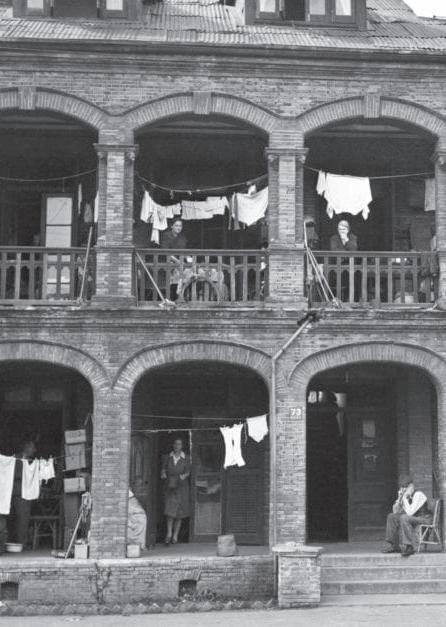

A moment captured during the installation of Orders of Empire.
Afew years ago, in my former neighborhood in Queens, I passed an ornamental column amid the sidewalk trash. Regret prompted me to backtrack and haul the plaster orphan home. It’s since moved with me to Chicago, where, bearing a pothos, it receives many compliments.
Columns, particularly of the classical order, have a powerful allure. They are elegant, evoke high art, and can feel beguiling, as I realized on that summer stroll. They can seem incongruous in our surroundings, particularly on a city sidewalk. Columns are really everywhere though: decorating banks, colleges, museums, and federal buildings throughout the country. This all might seem obvious, but artist Kelly Kristin Jones knows there’s something more insidious behind the ubiquity of columns. “They are symbols used by white people to reinforce power,” she said when we spoke in June. “It’s so ingrained that we’re not conscious of why they’re so heavily used throughout our built spaces.”
Jones has spent several years interrogating the prevalence of such markers in the U.S., focusing on public (and taxpayer-maintained) monuments to long-dead white men that have fueled national debate—and, in Chicago, a public arts reevaluation. For her ongoing work
In time and paradise, Jones documents herself and others while they hold up photographs
of the sky in front of local statues that depict controversial people. In the course of these performances, Jones does not identify the subjects of the statues for the viewer, which invites us to imagine the possibilities of who should be memorialized atop the pedestals. The resulting documentation makes it appear as though the original statues have been erased, echoing the darkroom technique of dodging.
While Jones was cooped up indoors last year, she began thinking about ideologies of whiteness that are baked into everyday domestic life. She bought ornamental columns from local sellers on Craigslist and Facebook, made of cheap materials such as plastic, wood, plaster, or metal. The growing stockpile of columns is the centerpiece of Jones’s show “We forgot the moon while holding up the sun” at Bridgeport’s 062 gallery in the Zhou B Art Center. The resulting piece, Orders of Empire, features dozens of columns spilling from a corner to evoke an ancient ruin. The exhibition, which also includes photography, works to untangle the pervasive legacies of white supremacy that haunt in plain sight; to show that a column is not just a column.

The crux of this systemic architectural sleight is the white and Right-wing obsession with antiquity. Rutgers professor Dr. Lyra D. Monteiro wrote that ancient Greeks and Ro-
mans “a rmed the ancient nobility and capacity for rule of the white race, while also o ering a model of righteous empire and civilized slave ownership.” Monteiro outlines this in her essay “Power Structures: White Columns, White Marble, White Supremacy,” which she posted on Medium in October 2020. Monteiro tells us that the so-called founding fathers “. . . set their heritage claims in stone,” and traces the incessant formation of white national identity from Thomas Je erson (whose plantation Monticello has become a byword for whitewashed histories of enslavement) to the farcical tradition of plantation weddings, and from the 2017 white supremacist rally in Charlottesville (which revolved around a Robert E. Lee statue) to Trump’s “Making Federal Buildings Beautiful Again” executive order. Neoclassical architecture, Monteiro writes, was and remains a way for white men to “[seed] the landscape with the signs of the European past—of European heritage—quite literally marking the territory of whiteness.”
Jones’s work seeks to avoid didacticism and invites us to excavate the calculated history of unbalanced power simply by making it immense and inescapable. She collects and calls attention to the bread crumbs of this history beyond the south, still largely the focus of today’s debates over monuments. Interestingly, her column sellers all live in predominantly white, western, and northern Chicago suburbs. They’re also all white women. “I realized that that was the work,” Jones said. “I’ve been thinking about the role white women have always and continue to play in upholding white supremacy.” The point is not to suggest that women are intentionally signaling white spaces but that “this agenda is at work, even if we are unaware or don’t want to acknowledge it.”
Echoing protestors’ righteous toppling of monuments that gained momentum last summer, Orders of Empire wrenches columns from their cozy camouflage. Literally upended, they are exposed as gimcrack—hollow props, not regal pedestals. In convening them, Jones creates what I’d called a counter-monument, a marker that simultaneously makes visible and deconstructs collective ideas of heritage. Over the exhibition’s course, the pile has grown, becoming more unwieldy as well as absurd in its utter futility.
Jones also visited predominantly white suburbs to create her photographs on view, driving to places such as River Forest, Riverside, Downers Grove, Elmhurst, and Wheaton. Over the past year, she’s trespassed into private yards to photograph public-facing markers
that are, again, curiously low-grade. The cheap busts of white men and faux Greco-Roman urns are more reminders that whiteness dominates. Jones uses Adobe Photoshop’s spot healing brush to render the documented markers unrecognizable, then prints and cuts the photos to the scale of the object’s silhouette. At night, she returns to the site, conceals the marker with the photo, and photographs it by moonlight. The resulting prints, richly tonal and mysterious, are small subversions. They capture a momentary redaction of power—filtered through time and commercialization—by attentive, almost healing gestures. Some are noticeably edited, like an image that shows the clear outline of a bust or another, the contours of an amphora. But the most e ective of Jones’s interventions are those that nearly blend with their surroundings, like happy glitches in the landscape.
Jones is aware that being a white woman has allowed her to do this work—so far, no one has called the police on her. Her race is one of the reasons I’d argue that she should be doing this work: white artists don’t feel the expectations that many artists of color do to make work about race, and infrequently examine whiteness without speaking for nonwhite communities.
And Jones’s work is ceaseless and ongoing. She is amassing a collection of vintage and tourist postcards depicting sites with historical monuments, more than 700 of which were displayed in Wish you were here , an installation she mounted earlier this year at the Lubeznik Center for the Arts in northwest Indiana. She digitally alters the postcards to remove controversial markers, reclaiming the tools of the very process used to mythologize them. Jones is also accumulating snapshots of white women posing with contested monuments, and the growing binder already points to an enduring process of patriotic identity building—one intrinsically tied to the United Daughters of the Confederacy’s funding of hundreds of Confederate statues.
In building and wrestling with these various material archives, Jones seems to be heeding artist Xaviera Simmons’s call for white artists: “Go further and work more rigorously to undo yourselves . . . do the cultural autopsy, name what whiteness is and the centuries of harm it has done . . . ” Jones names, interrogates, and implicates whiteness, better equipping us to work at dismantling it in our personal spaces. v
When a statue is more than a statue
Kelly Kristin Jones examines contested monuments with her art.






overstimulation will wither forthwith.
Chicago Loop since early 2020. Will lipstick survive a bus ride under a mask? I have done the research, and the answer is yes.
The state of the lobby is an amuse-bouche of the glitz and kitsch that await you this evening: chandeliers drip with blinding prisms, reproductions and imitations of Postimpressionist art blare. You can sit on a sequined slice of the moon and have your photo taken—a few writers in compliance with the suggested “festive” attire (for research purposes only) might not have been too cool for it this one time. We’re going back to the theater, and we’re breaking out our best beads.
If you didn’t bring your own tiara, you can buy one. If you need a beverage immediately, you can buy one of those, too (if you’re on a budget yet must imbibe, pack a flask. You didn’t hear that here). The immaculate restrooms operate with the same e ciency as the elevators: you may have to wait a minute but the line keeps moving. In the meantime, behold the novelty of other faces, three-dimensional and strange, or your own among them, in the myriad mirrors on the wall.
Once inside the tent, the lights are red, and the tables are close. Everything is shining— the art deco glass, the mirrors, the disco ball (why not?). Everyone gets their own little dish of hummus and olives. The salt is centering.
When the action begins, your eye will wander. Dancer Mickael Bajazet has you from the moment he strikes up the band—every impish expression compels with sweetness. But be-

But regardless of your perspective on compulsory audience participation, humiliation brings your fellow theatergoer into full relief—and who are we here for, if not each other? (On this day, Matt, who manages gyms. Alexa, actually a real person. Patrick, who sells rope. James, an engineer. James, a data analyst. Joyce, who graduated from Farragut High School in 1951. Whatever mnemonic devices The Caesar is using, they stick.) “We are here!” he shouts—and in the colored light of the specials, you can actually see what we’ve been thinking about all these months—fine droplets streaming through the air, the toxic haze we all exhale. Like it or not, tonight’s the night we find out if our vaccines really work.
The introduction of a bedazzled mummy case sets the tone for the rest of the night, Vegas in the midwest, with a relationship to authenticity like the Caesar salad has to the Roman Republic—tasty if you don’t think about it as anything beyond a pop culture legend of a love triangle with a sexy queen. For she is here with us, Cleopatra (Storm Marrero), with a big voice and a costume to match (designed by Zane Pihlstrom), often in duet with Cunio—together they are fearless, unstoppable, glittering like a planetarium.
Cleopatra and Caesar need their Mark Antony, here played by clown and codirector Joe De Paul who can only be described as inhabiting a zone between disarming and perturbing, an ordinary guy o the street until he isn’t.
The show begins before you enter the theater lobby on the 14th floor of the Cambria Hotel, before the costumed attendants greet you just past the revolving door at the northeast corner of Randolph and Dearborn and usher you into the elevator, before you step o or out of your preferred mode of transport and into the entropic eddies that
are the awkward traffic of humans and cars learning to move en masse again, where some shop and some shout and some gawp agape across the street from—yes—street performers on trumpets outside the Macy’s. Check the mirror before you go out, because the show begins with you, and this is the last time you’ll ever not be at the first show to open in the
RTEATRO ZINZANNIOpen run: Wed-Sat 7 PM, Sun noon, Cambria Hotel, 32 W. Randolph, 312- 488 - 0900, zinzanni.com/chicago, $ 69-$234 (includes a four-course meal).
fore you get too comfortable, a bit of slapstick starts up between a custodian (Oliver Parkinson) and a maid (Cassie Cutler). Take note: they are unusually lean and muscular. This is called foreshadowing.
“I missed the look of you—the smell of you—the group spooning,” croons The Caesar (Frank Ferrante), your host with a little too much of the most. The Caesar’s hair gleams. The Caesar perspires profusely. The Caesar is quick with improvised lines and quicker to demand applause. The Caesar commands hapless audience members to the stage. Introverts who have not already perished from general
The greatest treats of the evening are also its greatest feats—dance and acrobatics by Duo 19 (Parkinson and Cutler), Bajazet and Vita Radionova, and Lea Hinz—performed at such close range, you can see every supple muscle quiver and track the calculations of coordination. Impossible distillations of physics, ingenuity, and craft keep bodies hovering between flight and fall—exquisite illustrations of trust in humans and human invention, radiant, perilous, tilting extravagantly on the edge of folly, mastery of this moment. (Between the acts, these same performers bring you plates. They pepper your food. They pour your water. It’s not new but still needed: a reminder of the life of service that many artists lead.)
Yet perhaps its greatest pleasures refer to the sense of togetherness we can experience beyond the boundaries of the theater—the energy of others, a slow dance, a kiss on the cheek. Life is theater, theater is life. We are here.












REVIEW
It begins, as many wonderful things do, with the sea. Enter the outdoor space at Pilsen’s BRNDHAUS-PLZEN, and the squawk and swoop of real-life gulls merges with those of Sea Change, the latest o ering from the wildly creative minds behind Cabinet of Curiosity.
Throughout the roughly 70-minute production featuring music, puppetry, dance, and storytelling, directors Michael Cotey and Frank Maugeri’s seven-person cast evokes the vastness of the coastal oceans; places where worlds we know nothing of will continue long after we’re gone, just as they did long before we were here.
The script—penned by Lindsey Noel Whiting, Kasey Foster, Bethany Thomas, Liz Chidester, and Seth Bockley—deals with matters ranging from the patriarchal bullshit that sea sirens and mermaids have to put up with (Howard Pyle et al. left out a few things, it would seem) to the ever-tightening vise of
climate change. Each of the loosely connected scenes are embedded with a song or two, some haunting, some delightfully silly, all threaded together with an overarching, profoundly feminist sensibility.
The production was originally created as an indoor spectacle, but COVID-19 changed that.
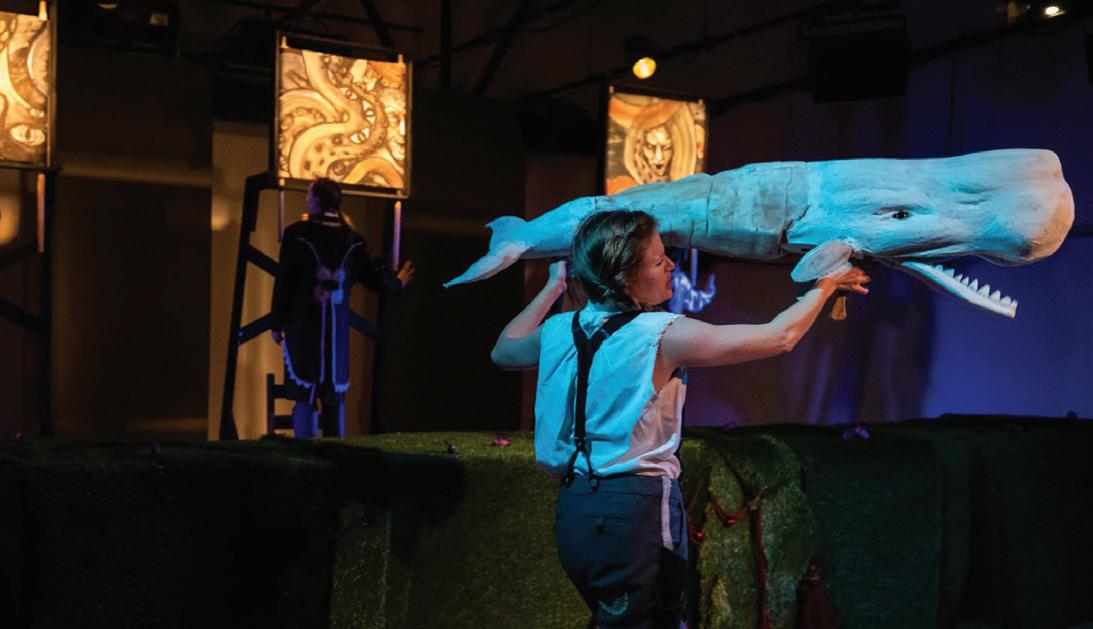
Opening night came with bonus drama as Maugeri and his team of vocalists/actors/ dancers/puppeteers scrambled to make their open-air space just a bit more watertight. As thunder clouds roiled overhead and mist escalated into rain, the crew scrambled to set up a waterproof space for the drum kit and the electric violin as well as a tent for the crowd gathering.
“I’m being punished for my sins,” Maugeri announced before delivering one of the most engaging curtain speeches I’ve heard in 30 years. But even with some of the sound and lighting tech compromised or altered opening
night, Sea Change was a magical experience, that threat of rain creating a sense of heightened community.
The cast (Kasey Foster, Sadie Rose Glaspey, Manae Hammond, Allison Grischow, Olivia Rose Comai, Sofia Balabanova-Gebreab, and Time Brickey) works with the elaborately vivid creations of puppet and object designers Ellie Terrell, Jillian Gryzlak, Jesse Mooney-Bullock, and Milam Smith, sharing the stage with underwater creatures as small as a seagull and as massive as a great blue whale.
Designer Shawn Ketchum Johnson’s set is essentially an ark fashioned from a series of (what appear to be) shipping containers. Ensemble members haul open the heavy doors throughout, revealing the ship’s inner workings or portholes that provide unexpected views of the deeps.
In Bockley’s The Lookout, we meet the man in the crow’s nest, a gent who loves his job
high on the mast, ever on the alert for whales, pirates, rocks. He’s supposed to be minding the boiler as well, but he’s not, despite the troubled queries of a stranded seagull, a bird who knows a boiler-about-to-blow when they hear it. The boiler issue is a recurring theme throughout and while it sounds like a metaphor with the subtlety of a clawhammer, it actually works; the point is made, the seagull sidekick is comic gold.
When a gigantic whale glides slowly into sight—increasing to seemingly impossible dimensions not entirely unlike that Christmas tree in The Nutcracker —it’s as thrilling as a whale watch off Cape Cod. Noel Whiting’s Whale Song is also as troubling, because more and more, these magnificent creatures are falling victim to warming seas and hunters.
The whale here has a great deal to say about current conditions in a scene that unscrolls like a moving comic book while cast members slowly crank a series of handles. We meet Dave, an ordinary man who puts himself in an extraordinary situation, in what turns out to be rather an anti-Moby Dick. The scene is an elegiac reminder of just how fleeting the life of a species is in the grand scheme of things.
In Thomas’s A Mermaid’s Tail (If There’s a God), we get a drolly tragic, utterly unromantic autobiography of sorts from a mermaid/sea siren. The puppetry is intricate: As the largerthan-human-sized mermaid takes a deep dive into the man-made mythos rules that dictate her life and death, she slowly, resignedly sheds her scales. In the end, all that’s left of her is seafoam. And maybe, that’s all that’s left for any of us when you get right down to it. There are worse ways to end up.
Foster’s alternately whimsical and chilling More (which includes music by Charlie Otto) stars the moon, as a troubled shark grapples with some pointedly human issues involving the brutality of supply and demand on planet Earth. The moon—who has seen more than a few species flame out—has some good advice. Whether the flesh-and-blood creatures below will heed it remains an open question.
On a more lighthearted note: Whatever you do, do not sleep on the jellyfish scene. They’ll almost make you believe you’re underwater, in the best possible way.
@CateySullivanR THE TEMPEST
Through 8/21: Thu-Sat 8 PM, Sun 7 PM, Austin Gardens, 157 Forest, Oak Park, 708 - 300 -9396, oakparkfestival.com, $ 35, $25 seniors, $15 students, 12 and under free.
 By KERRY REID
By KERRY REID
Choosing The Tempest as their first show to break the enforced theatrical silence of the past 16 months makes a lot of sense for Oak Park Festival Theatre. Shakespeare’s late romance celebrates the “rough magic” of finding redemption, love, and freedom after storms both literal and metaphorical have knocked the characters on their asses. We can relate, certainly.
But at least since Jonathan Miller’s acclaimed staging for Britain’s now-defunct Mermaid Theatre in 1970, there has been a tendency to see Prospero’s island as a metaphor for colonial exploitation. Banished from his own kingdom by the perfidy of a sibling, Prospero turns into a brooding tyrant to the “mooncalf” son of a witch, Caliban, whose mother previously controlled the land, and Ariel the sprite, who longs for freedom and hopes that doing just one more task for Prospero will bring it. Even his beloved daughter Miranda doesn’t always seem capable of breaking through the carapace of Prospero’s
resentments. And even regaining his “rightful” place in the social pecking order by play’s end doesn’t seem to give him much satisfaction.
Barbara Zahora’s staging for OPFT offers what appears to be at first more an environmental parable than a commentary on white supremacy and imperialism. In her opening-night preshow comments, Zahora referenced the world of the play as inspired by the Great Pacific Garbage Patch—that enormous floating mass of plastic and debris in the north Pacific. Ryan Fox’s set design, with its piles of boxes and plastic bags, backed by a rusted-out shipping container, certainly suggests a junkyard more than a tropical paradise.
But that’s inevitably o set by the o stage world of Austin Gardens, a verdant oasis in the middle of downtown Oak Park that OPFT has called home for decades. The remarkably pleasant temperatures and mosquito-dissuading breezes opening night stood in contrast to Prospero’s rough-hewn island of misfit toys.
It’s here where he summons the title storm
(which also could fit with the implied climate-change sub-theme) to bring ashore his treacherous sister Antonia (Jeannie A elder, handling the gender-reversed role with icy aplomb), Alonsa, the queen of Naples (Noelle Klyce, bringing mournful maternal warmth to another role originally envisioned as a man), and the latter’s son, Ferdinand (Austyn Williamson), who woos and wins Prospero’s forthright-if-flummoxed daughter, Miranda (Deanalis Resto). There’s also loyal Gonzalo (Belinda Bremner), who managed to slip Prospero’s book of spells to him before his banishment.
A sense of paradox and contrast is quite appropriate for this play, and Zahora’s production is at its best when it leans into it. Caliban (Matt Gall) is almost literally two-faced: one side blistered, angry, and as red-hot as the rage he bears for Kevin Theis’s acidic Prospero, the other smooth and placid, in keeping with the gentle dreamer who describes his native land (trash and all) as “full of noises, sounds and
sweet airs, that give delight and hurt not.” (Gall even clutches a grimy teddy bear during this naifish meditation.) Then again, if you squint hard at his eagerness to embrace the buffoonish drunkard Stephano (Orion Seth Lay-Sleeper) as his new “master,” you might be able to see an analogy to the darker side of American populism.
But for the most part, Zahora’s production doesn’t lean too heavily on the social and political metaphors. For me, the most successful element of both the play and this particular staging is the question of what it means to be a good father. Theis’s Prospero clearly adores Resto’s Miranda, but as Miller noted in his 1986 book on directing classics, Subsequent Performances, “Men in Shakespeare seem to have exorbitant expectations of the love that is to be obtained from women.” He sees her immediate attraction to Ferdinand, and recognizes that it’s a necessary step away from him and from the island where her emotional growth has been stunted. But as with Caliban and Ariel, Prospero doesn’t seem to fully grasp how to show love that isn’t couched in some sort of power play. Ferdinand can win his daughter’s hand, but only on Prospero’s terms. Or so he thinks.
That’s where Bernell Lassai’s Ariel comes in. More than just a magical helpmeet to his dominating master, he serves as a conscience, a sounding board, and, in one beautiful wordless interlude, a source of almost paternal solace as he embraces Prospero, understanding that the old man is losing his bearings even as he regains some semblance of his old world. It’s an earthier take on Ariel than I’ve usually seen, and one that works well in a world of debris both literal and emotional.
That’s probably not a bad way to think about this production overall. It’s a warm embrace, a welcome back to the communal world of theater, and a reminder of our past lives before they were upended. But it also hints that whatever lies next won’t be what we think it will. No matter how much we cast spells or aspersions, dream of revenge or restoration, or simply hope that love will be enough to carry us through whatever days are left, the psychic global debris remains, floating somewhere out there, calling to us.
Black Widow, the 24th (really) film in the Marvel Cinematic Universe, is set in the immediate a ermath of 2016’s Captain America: Civil War, with Scarlett Johansson reprising her role as Natasha Romanoff, the eponymous Black Widow, a highly trained former KGB assassin turned Avenger, who’s forced to reconnect with her painful past in order to stop an international conspiracy. Helmed by director Cate Shortland, the film takes us into Romanoff ’s past, raised as the child of Soviet secret agents, tasked with stealing American secrets in the heartland. Sent back to Russia and forced along with her adopted sister Yelena Belova (Florence Pugh) into the Black Widow program, Romanoff conducts a series of assassinations before breaking free and joining up with our team of heroes to save the world. Black Widow avoids the superhero storylines and takes a more human approach, instead tracking Romanoff as she reconnects with Yelena. But really, fans of this franchise are here for the action, and overall, the sequences are engaging without being overwhelming. The performances are entertaining enough, especially so in the scenes when the film becomes a family affair and Johansson and Pugh are joined by their spy parents Melina (Rachel Weisz) and Alexei (David Harbour). Shortland and writer Eric Pearson complete a deceptively difficult balancing act in creating a story that can stand alone if you can’t recall or haven’t seen all 23 previous films (not to mention an expanding number of television shows), while providing enough material to satisfy superfans and advance the seemingly never-ending narrative behemoth that is the MCU. —ADAM MULLINS-KHATIB 134 min. Streaming on Disney+ and in wide release in theaters
The Call is a middling homage-horror. Set in 1987, it’s dripping with the same nostalgia that propelled Stranger Things into popularity, although the movie is much more a tribute to the likes of Wes Craven than of Steven Spielberg. Following a group of small-town friends, as they try to survive the night in the home of a sinister couple, it starts slow but comes through in the
back half with some hearty scares, as the teens, played by Chester Rushing, Erin Sanders, Mike Manning, and Sloane Morgan Siegel, respectively, go up against genre power couple Lin Shaye and Tobin Bell (Jigsaw himself). The title refers to Edward Cranston’s (Bell) demand that the teens take turns dialing a number and staying on the line for one minute. If they succeed, he’ll pay them handsomely and forgive them for the torment they caused his now-deceased wife, Edith Cranston (Shaye). There’s a catch, of course, which provides the tension and terror as the phone trills. Whether or not the movie is worth picking up is your call, however. —BECCA JAMES 97 min. Shudder
The latest feature film from French filmmaking duo Alexandre Bustillo and Julien Maury looks at abuse through a unique higher power. Best friends Amélie, Bintou, and Morjana spend their summer days hanging out on roo ops, spray-painting murals at night, and telling urban legends. A er Amélie has a violent encounter with her ex-boyfriend, she summons the spirit of Aisha Kandisha—a succubus-like creature from Moroccan folklore that takes on the form of a beautiful young woman with hooves—to fight back. But when the feminine spirit won’t rest until every man, regardless of guilt or innocence, is killed, Amélie and her friends have to put a stop to it before their loved ones become the next targets. Kandisha takes the rape-revenge genre to exciting and complicated places: it’s full of visual scares and haunting music that could keep anyone up at night, sure, but the true terror lies in the emotional margins. Kandisha is a thorny exploration of the difference between justice and vengeance, especially when it comes to sexual violence, and who gets stuck in the crosshairs. —CODY CORRALL 85 min. Shudder
I saw a thread on Twitter recently about how some actresses have faces that, for some reason, do not look realistic for a period drama—saying Jessica Biel has a face that knows about text messaging. The Last Letter From Your Lover might make you wonder if Shailene Woodley suffers from the same condition. Netflix’s new
Get showtimes and see reviews of everything playing this week at chicagoreader.com/movies
romance casts Woodley as a 1960s woman involved in a secret affair with a journalist (Callum Turner) whom she meets when he writes a profile on her husband. Woodley is a talented actress, but something with the role just doesn’t suit her: her delivery feels half-baked and her character’s accent shi s inexplicably. Granted—she doesn’t have a ton to work with; the script is simple and predictable. There’s also a larger plot going on where Felicity Jones plays a journalist who finds letters that the couple wrote to each other and tries to reunite them, but this premise has been used so many times that this iteration doesn’t stand out much. The Last Letter from Your Lover may suffice for a cheesy girls night in, but it won’t be a memorable entry to the genre. —NOËLLE D. LILLEY 110 min. Netflix
Isabelle Huppert stars as an Arabic interpreter for the French police who becomes an unlikely drug dealer a er she intercedes in a major smuggling racket. Taking the goods for herself and using her insider knowledge to dodge the fuzz, she begins trafficking the drugs through a dopey duo who bequeath her with the moniker “Mama Weed.” Meanwhile her unusual new job—as well as her inherited disdain for cops—complicates her romantic relationship with the police chief. It’s tough to say how much of this genuinely works versus how much of it is elevated by Huppert’s superior talent and charisma; she could upraise even the most routine potboiler, which this insouciant caper o en approximates. In addition to Huppert’s performance, this is further distinguished by an understated ACAB vibe—the heroine’s relationship with the Chinese woman who owns her building (and who it’s suggested dabbles in the underworld herself) highlights the societal and economic reasons that drive people to criminal activity, and one comic motif finds Mama Weed not doing much to hide her nefarious activities from the everyday people she encounters on the lam. Based on the novel La Daronne by French author Hannelore Cayre and sturdily cowritten and directed by Jean-Paul Salomé, this is a compelling romp with a vaguely radical undercurrent. In French and Arabic with subtitles. —KATHLEEN SACHS 106 min. Music Box Theatre
Is there a stronger bond than the one between a man and his pig? Michael Sarnoski’s lush, Oregon-set debut feature argues on the contrary. Nicolas Cage stars as Rob, a scruffy recluse who, a er leaving the toxic and demanding restaurant industry some 15 years prior, now lives largely off the grid, foraging for truffles with his rusty-colored pig. Rob’s simple life is turned on its axis, though, when his prized pig is stolen from him. Rob goes on an emotional journey through the past he le behind with his buyer Amir (a solid Alex Wolff teetering between slimy showboat and father-induced inferiority complex) as his chauffeur. Pig is not a revenge

story, really—nor does it feel overly cynical outside of its depictions of the cutthroat mentality in the fine dining industry. Cage takes a more understated approach here, o en mumbling his words and much more somber than full of rage, though his rough, bloodstained exterior juxtaposed with high society speaks louder than words. Even through its various webs of tragedy, relentless ambition, and destruction for capital gain—Pig remarkably and overwhelmingly champions care and kindness.
—CODY CORRALL 92 min. AMC Theatres, Music Box Theatre, ShowPlace Icon TheatreFew people in the public eye have touched more lives on a personal level than Anthony Bourdain. The charismatic writer, chef, television personality, and consummate outsider was known for his no-bullshit approach to life and travel, and his ability to meet people where they are and share their stories while speaking truth to power. That won him kinship with world leaders like Barack Obama, rock stars, and, quite literally, the bartender or restaurateur down your street wherever you are on the globe. Roadrunner is a heartfelt and heartbreaking portrait of Bourdain through the eyes of his inner circle and loved ones, who are still grappling with his death three years a er he committed suicide in Alsace, France. Directed by Morgan Neville (best known for his compelling 2018 Mr. Rogers documentary Won’t You Be My Neighbor?), Roadrunner takes a look at Bourdain’s meteoric rise to fame in the early 2000s when he was in his mid-40s, and how the experiences he had as a result flavored his worldview and political consciousness, and compelled him to use his platform to shed light on marginalized communities and individuals. His family and friends describe him as a searcher and storyteller who was eternally conflicted: on one hand, he craved normalcy and love, especially a er the birth of his daughter in 2007. On the other, he battled an addictive streak that led him to pour himself 1,000 percent into everything he did, whether it was drugs (he successfully beat a heroin dependency in the 80s), work, travel, or his relationships, and could never be fully satisfied. “Life was a romantic idea, and reality was never going to live up to exactly how he pictured it. He was always going to set himself up for disappointment,” said his friend and longtime producer Helen Cho. Rather than try to definitively answer why Bourdain took his own life, Roadrunner presents a chicken-or-egg-type scenario: How o en does our inherent nature dictate our behavior, and how o en are our responses triggered by circumstance? Ultimately, the film shows how in death as in life, Bourdain can still help us open our hearts to other people’s struggles—and hopefully pay the lessons forward. —JAMIE
LUDWIG 118 min. AMC Theatres, Landmark’s Century Centre Cinema, Music Box Theatre v






















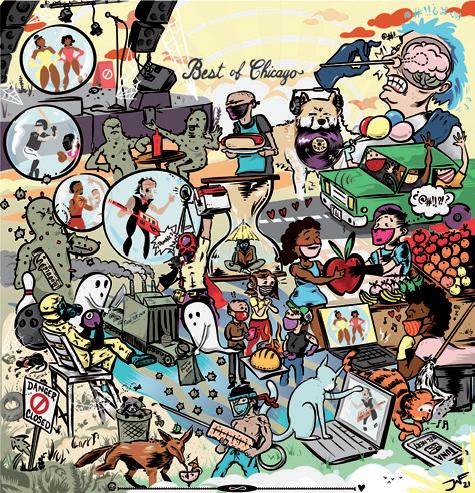










Scott Cortez and Melissa Arpin Duimstra have built a cult audience in their 30 years as a band—and new music and vinyl reissues are on the way.
 By NOAH BERLATSKY
By NOAH BERLATSKY
“When I first heard Isn’t Anything by MBV, that was probably 1989,” says Scott Cortez, the Chicago-based musician who’s half of Lovesliescrushing. “And I was like, ‘I know what that is! It’s this one patch on this one specific effect.’ I remember people freaking out—‘Is there something wrong with my tape? Is there something wrong with my CD?’ And I was like, ‘No, this is amazing! What’s wrong with you? You don’t like warbling guitars?’”
Cortez had already been playing with a rack-mounted effects unit called the Alesis Midiverb II, using patches 45 and 49—both are reverse-reverb settings, labeled Bloom 1
and Bloom 2. Their lush, ethereal sound came to define shoegaze, so that when Cortez heard My Bloody Valentine, he felt like he was looking in a wavery, blissed-out mirror.
Other shoegaze bands—Ride, Slowdive, Sigur Rós—took MBV’s innovations and ran with them, even soared with them. But Lovesliescrushing have always seemed to operate in a parallel universe, making dense, beatless sheets of sound so disorienting you can’t see your shoes—the band’s music is turned inward so completely that the only thing you can gaze at is the inside of your own skull.
Cortez and his collaborator, vocalist Melissa Arpin Duimstra, have been recording and performing as Lovesliescrushing for three decades now. They haven’t exactly found fame or fortune, and they haven’t maintained a steady release schedule. But in that time they’ve put out around a dozen albums, earning a reputation as shoegazer’s shoegazers, widely respected among those who love the genre (Tim Hecker is a vocal fan).
To make the most of that reputation, Cortez has started to reissue old recordings on vinyl via his own Wavertone label. His only such release so far has been Lovesliescrushing’s first album, Bloweyelashwish, in 2016. But it did so well that it won’t be the last: he pressed 300 copies on vinyl, all of which sold out at the preorder stage, and they’re now fetching hundreds of dollars on the secondary market. “I saw it at Reckless Records for $250. And then it was gone,” Cortez says. “The next day, I was like, well, it’s not there anymore.” He’s planning to release more material from Lovesliescrushing and from his noise-pop project, Astrobrite, in the coming years. Next up is a reissue of Lovesliescrushing’s second album, Xuvetyn , due on CD from Projekt Records in August and on vinyl in November.
Cortez is originally from Saginaw, Michigan, and Arpin Duimstra grew up in Grand Rapids. The two met after college in 1991 in East Lansing, where Arpin Duimstra had just started law school and Cortez was working in a vintage clothing store. They had a number of musical interests in common: MBV, the Cocteau Twins, the Smiths, Joy Division, Brian Eno, Terry Riley, Philip Glass. Arpin Duimstra played piano and French horn. Cortez had been in a couple cover bands in high school, but at that point he was experimenting with his guitar and a Tascam Portastudio 424 cassette four-track, trying to create his own sound and looking for a vocalist to help. But they didn’t initially see each other as musical collaborators.
“I was not a singer,” Arpin Duimstra says,
via Zoom from her Grand Rapids home. Cortez is sitting beside her on the couch, in front of one of her abstract paintings. “We were dating at the time,” he adds. “And I didn’t want to ask my girlfriend to sing. I didn’t want to bother her with it!”
After a number of vocalists had auditioned, though, Cortez still hadn’t found what he wanted. Arpin Duimstra saw he was depressed, and she volunteered to help him out.
“She knew exactly what it was, because she’d been listening to the music for a couple of months,” Cortez says. She told him to go away, went in the room with the four-track, and came out with the core of the first Lovesliescrushing recording—the song “Valerian (Her Voice Honeyed),” which would eventually appear on Xuvetyn.
Not everything they worked on together was quite that easy, of course. “The only time we ever had an argument was over music,” Arpin Duimstra says. “Because I sometimes have an idea, like, ‘I think I really want to go this direction.’ And you’d be like, ‘No, we have to do this! Slow this down, or take this out!’”
Despite the occasional conflict, the pair continued to record in their living room, mostly after midnight, throughout 1991 and 1992. They discovered that their approaches to art were very similar. “I would take poems or snippets of things that I’ve written and have a loose idea of where I wanted to go, a feel for a song. But then a lot of it was just very spontaneous,” Arpin Duimstra says. “My process as a painter is, oftentimes I’ll do a complete painting, and then I scrape it away, and then I do another layer and scrape it or manipulate it. And that’s very similar to how I did vocals.”
It’s also similar to how Cortez creates music. John Cage’s writing inspired him to a broad appreciation of how music could be a place where, as Cortez puts it, “You let anything happen. Noise and silence.” Some listeners have assumed Lovesliescrushing use synths or other electronic instruments, but all their recordings consist exclusively of guitar and voice, worked and reworked and processed and reprocessed. “Without drum machines or synths,” Cortez says, “it smeared and reduced the music to its most minimal, all semblance of rockism crushed out of it.”
The early track “Silver (Fairy Threaded),” for example, was initially fairly upbeat, clipping along at 200 BPM. “It sounded like a country song,” Cortez says in disgust. Then he slowed down the recording dramatically, stretching it out to more than nine minutes. Arpin Duimstra’s pure, heavenly tone turns into a drifting drone, and the guitar becomes a pulsing roar, half church bell and half boiler. “I
was like, there it is,” Cortez says. “That’s what it should be. It should be this weird.”
“Silver (Fairy Threaded)” ended up alongside “Valerian” on 1996’s Xuvetyn (pronounced “zoo-vah-TEEN,” the band tell me). Like most of the material on that album, those songs were among Lovesliescrushing’s first recordings in Michigan—and some went back even further, to Cortez’s solo experiments. They wouldn’t release that music for several years, but Cortez and Arpin Duimstra brought the unfinished tapes along with them when they decided, impulsively, to move.
“I’d lived in Michigan my whole life,” Arpin Duimstra says. “I just wanted to go someplace completely di erent.” In 1992 she abandoned law school, and she and Cortez got in her Toyota Tercel and headed for Santa Fe—which did not work out well. They couldn’t even find jobs in fast food, Arpin Duimstra says. Sometimes they had to get resourceful to stay fed: “We went to art openings and ate little cheese cubes.”
The couple quickly fled to Tucson, and in summer 1992 they began to record again, this time in a motel room without any airconditioning. Later that summer those Tucson tracks became their first self-released cassette, Bloweyelashwish. “It was what we were doing at the moment. It was like, we just made this right now,” says Cortez. “It’s fresh. Let’s just put this out.”
Cortez says he has just one copy of that cassette release still in his possession. But you can hear a bit of what it sounded like from the first cassette version of “Babys Breath” that’s included on the 2010 album Girl Echo Suns Veils (Projekt). The song starts with a chalk-on-blackboard whistle-screech before opening up into a massive ambient wall that blends Arpin Duimstra’s voice and the processed guitar into an almost indistinguishable shimmering assault. It’s harsh noise wall, but pretty.
Cortez wanted to send out the cassette as a demo, but he quickly realized it would be futile. “There were no labels to send stu to that would have appreciated us at all,” he says. The only one he knew that released ambient music was Projekt Records in Portland, Oregon. Label owner Sam Rosenthal saw Lovesliescrushing play live in Phoenix, augmented by additional musicians who allowed them to approximate the sound of their recordings. (When I ask how they managed to translate their music to the stage, Arpin Duimstra laughs. “That’s a very good question,” she says. The band have only played about seven shows in 30 years.)
Rosenthal wasn’t exactly won over. But an artist already on Projekt, Michael Plaster
of one-man goth-rock project Soul Whirling Somewhere, convinced him to reissue Bloweyelashwish in a new mix in 1993—but only as a cassette. Ryan Lum of dream-pop duo Love Spirals Downwards, another labelmate, had to lobby Rosenthal to put it out on CD.
When Bloweyelashwish came out on Projekt, it was essentially the second complete version of the second record by a band that had been recording intensively for more than two years. But listeners didn’t know the earlier Xuvetyn material existed, since it wasn’t yet released, and most hadn’t heard the first cassette of Bloweyelashwish . So the Projekt version of the album was received as an intimidatingly focused debut.
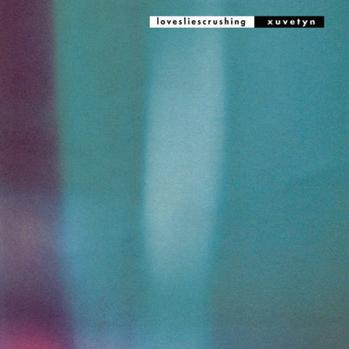
Bloweyelashwish takes shoegaze to an unassimilable extreme of noise, fully formed in its refusal to cohere. Cheap digital technology had yet to make home recording ubiquitous, and at the time Cortez and Arpin Duimstra were among a small group of musicians to attempt something so ambitious outside a studio; among other things, their debut is a


SATURDAY,AUGUST21 (1:30-10:00; open at 12:30)



continued from 33
pioneering work of bedroom pop. “It’s like looking at an artist’s sketchbook,” Cortez says of his approach. On the track “Burst,” you feel like you’re actually inside Cortez’s guitar, every note an ocean of feedback, with Arpin Duimstra singing somewhere outside, her severed bits of melody floating past as you drown.
In 1993, the same year Projekt put out Bloweyelashwish, Cortez and Arpin Duimstra had a child. They eventually decided to move back to Michigan to be closer to family. Right before they left in 1995, Cortez finally took a week to mix down the early recordings they’d made together before they’d come to Tucson. When Xuvetyn came out in 1996, it seemed like a second album—longer, more experimental, more fractured—rather than what it was, an exuberant chronicle of a new duo finding all their odd sounds together.
By the time the material on Xuvetyn finally saw the light, Arpin Duimstra and Cortez were no longer living together. Cortez had been working on his other band, Astrobrite, for a few years; he moved to Toledo in 1997, and then settled in Chicago, where he still lives, in 1998.

In the late 90s, it wasn’t easy for musicians to collaborate on tracks remotely. Cortez and Arpin Duimstra stayed in close touch, but making new Lovesliescrushing recordings was a challenge they couldn’t yet meet. That didn’t stop the band from releasing new material, though: during their time together, they’d amassed a massive backlog of songs and snippets, and over the next decade Cortez kept working and reworking them. Scottish label Sonic Syrup advanced him money to buy an iMac, and he used it to put together Glissceule on that label and Voirshn for Projekt, both in 2002. Both albums (whose combined titles are an anagram of “Lovesliescrushing”) put the group’s older sound into a smoother slipcase. The Voirshn track “Glixen,” for example, opens with a blast of glitchy blips that are more electronica than electronica—even though it’s all still just guitar.
By contrast, the amazing 2007 album Chorus dispenses with guitar altogether: it’s made up entirely of old Lovesliescrushing vocal samples processed and arranged into new compositions. The result touches on Björk and Enya before heading for no place on earth. Cortez creates rumbling bottom end and odd scratches and clicks—he’s turned Arpin Duimstra’s voice into a cascade of thrumming and static.
After more than a decade and half a dozen releases (including Crwth , a reworking of Chorus ), Arpin Duimstra and Cortez finally
got together in 2010 to make their first new recordings since their years living together. At Arpin Duimstra’s suggestion, they recorded Ghost Colored Halo (which came out on Projekt in 2013) by setting up in her basement and improvising live for four hours. “It sounds the most like us,” Cortez says. What’s most striking about the final recording is that it uses no overdubs but still closely resembles the obsessively worked and reworked tracks from the duo’s previous output—though it’s perhaps less delicate, with more visceral development in its tides of noise.
On 2012’s Glinter (This Quiet Army), the duo took advantage of advances in technology to work together remotely. Cortez recorded the music and sent Arpin Duimstra the tracks so she could add vocals. On its three 20-plusminute tracks, the duo lean all the way into ambient Sigur Rós filmic breadth.
In 2014 Arpin Duimstra went back to medical school, and that was the end of new recordings for a while. But Lovesliescrushing remains active, and Cortez’s vinyl reissues aren’t the only project the duo have in the works. Arpin Duimstra has been seeking out classical musicians to rerecord Lovesliescrushing material in orchestral form—a natural context for the music, Cortez says, since he’s long been influenced by minimalist classical composition.


Cortez has also been working on more Astrobrite material, and after the Xuvetyn reissue he’s planning on releasing a longer version of Ghost Colored Halo, with extra tracks that weren’t on the original. Arpin Duimstra is just finishing her residency, so Lovesliescrushing hope to start recording new material together again. “We’re entering a new potential era where it’ll be more feasible for me to do some in-person collaborating,” she says.
There have been a lot of new eras for Lovesliescrushing since they started in 1991, of course, and Cortez and Arpin Duimstra know that they’ll never be a pop phenomenon like My Bloody Valentine or Oasis. But for those who love their music, nothing is quite like it: the more-than-flirtations with noise and ambience, the determination to turn every hook into a yawning void, the painterly approach to songs as sedimented layers.
“What makes me happy is when I hear people who still find something that they connect to, even in the recordings from 30 years ago,” Cortez says. “We made something beautiful.” With any luck, they’ll be making those odd, loud, beautiful somethings for the next three decades too. v @nberlat






NORDISTA FREEZE, 8/11: VARIOUS DISTRACTIONS (FREE!), 8/14: ELIZABETH MOEN, 8/18: FLESH PANTHERS, 8/19 - 8/20: CLOUD NOTHINGS, 8/27 - 8/29: BULLY, 9/4: SCORCHED TUNDRA PRESENTS IN THE COMPANY OF SERPENTS, 9/11: PITCHFORK AFTERSHOW WITH DEHD, 9/12: PITCHFORK AFTERSHOW WITH YVES TUMOR, 9/10: PITCHFORK AFTERSHOW WITH BARTEES STRANGE (FREE!), 9/14 - 9/15: THURSTON MOORE, 9/16: TORRES, 9/17: NOUVELLE VAGUE, 9/18: ALGIERS, 9/19: COMBO CHIMBITA, 9/21: HOLY WAVE, 10/2: FAT TONY + CADENCE WEAPON











BOOK EXCERPT
The new book Punks in Peoria: Making a Scene in the American Heartland takes us back to central Illinois in the 1970s.
By LEOR GALILtheir contempt for the mainstream—among them Bloody Mess & the Skabs and my personal favorite, Constant Vomit. On September 5, Peoria’s Casa de Arte celebrates the book with a daylong outdoor concert called the Punks in Peoria Fest.
The deeply researched Punks in Peoria describes the growth of a scene in a central Illinois town that was anything but a sanctuary for subversives. In the following excerpt, Wright and Barrett show how the seeds of punk first got planted in Peoria. This passage begins with concert promoters Bill Love and Jay Goldberg, who were also owners of a local chain of stores called Co-Op Tapes and Records.
Across the river and ten miles south of Peoria, the hometown of Bill Love and Jay Goldberg was an unlikely hotbed of musical activity. Despite having a population less than a third the size of its sister city, Pekin had its own record stores, head shops, co eehouses, folk singers, and rock bands, signaling the inroads of the sixties counterculture in a stronghold of conservativism. An outsized number of area musicians found their roots in Pekin, from the early days of rock and roll to the punk era and beyond. During the 1970s, Pekin hosted performances by the likes of Kiss, Blue Oyster Cult, the Runaways, Rush, and Journey (with a then-unknown Tom Petty opening). Perhaps more significantly, Pekin was home to the Golden Voice Recording Company—the finest recording studio in Illinois outside of Chicago.
presented a unique opportunity to musicians from central Illinois and beyond: high-quality, professional recordings at a ordable prices. Just about every Peoria-area band of note recorded there. Among them was Pekin’s answer to the Beatles and one of the Midwest’s most successful regional acts of the seventies: the Jets. Riding a wave of hype fostered by a local radio station, the band drew throngs of screaming fans to their early Peoria and Pekin shows, not unlike what the Beatles themselves had done a decade earlier, albeit on a smaller scale. Though stylistically more power-pop than proto-punk, the group may rightly be considered provincial forerunners of the punk mindset and attitude in central Illinois.
In early 1974, the Jets broke up over some members’ obsession with David Bowie; out of the ashes came the Peoria area’s first glam band: the Jetz. For singer-guitarist Graham Walker, Bowie represented the next logical extension of rock and roll in the post-Beatles era, both musically and culturally—and hinted at the shape of punk to come: “We’d all gone to Chicago and gotten glitter/glam clothes. I dyed my hair orange and shaved my eyebrows off [as Bowie had famously done]. We were just teenagers, running around Peoria and Pekin. . . . To walk down Main Street in Peoria with no eyebrows, hair dyed bright orange, and a glitter shirt on in the seventies . . . people wanted to kill us! You couldn’t be any further out. No one understood what we were doing— it was like we were from outer space.”
Popular books about punk history tend to focus on the best-known bands from scenes in metropolitan centers, including London, New York, Los Angeles, and Washington, D.C. But punk also proliferated thanks to outcasts living in towns their big-city peers couldn’t find on a map—they too might hear something about themselves reflected in a strange, confrontational sound.
Jonathan Wright and Dawson Barrett’s new book, Punks in Peoria: Making a Scene in the American Heartland , helps demonstrate just how widespread punk was in its early years.

Published last month through the University of Illinois Press, Punks in Peoria comes with a soundtrack compilation released by Chicago archival label Alona’s Dream, which includes songs by bands whose names alone express
Surrounded by cornfields on the south end of town, Golden Voice is best known for helping Dan Fogelberg and REO Speedwagon get their start in the music industry. Styx and Head East recorded there, and one of the music industry’s most successful engineers launched his career at the studio. “The reason Nirvana’s album Nevermind sounds the way it does is in part due to Golden Voice’s influence on Andy Wallace,” notes Chris Gilbert, a Pekin native responsible for reissuing scores of nearly forgotten Golden Voice recordings on his own Alona’s Dream Records. “Teenagers will still be listening to Nirvana in twenty years, maybe longer, and Golden Voice played a role in that.”
During the 1960s and ’70s, Golden Voice
On Friday, May 24, 1974, Walker and his Jets/Jetz bandmate Gregg Clemons drove to Co-Op Records to pick up Bowie’s brand-new Diamond Dogs LP. “We bought the record at noon, and by 12:30 it was on our turntable,” he recalls. “We had our guitars with us and were playing along. The song that stood out was ‘Rebel Rebel.’ By 2:00 or 2:30, we were having our first run-through with it.” The band played it out that very night—a seminal moment Walker later described as “Peoria’s introduction to punk.”
The Jetz, however, lasted less than a year. Toward the end of the decade, a revived power-pop incarnation of the Jets (including Walker) released a single on Minneapolis’s Twin/Tone Records, a key independent label of the burgeoning post-punk underground. The band even had a number-one hit in Min-
neapolis (where a young Prince Rogers Nelson reportedly attended the record release party) and once opened for the Ramones, further tying the group to the emergence of punk rock.
For sixteen-year-old Douglas McCombs, who grew up in Peoria and Pekin, the crucial “aha” moment arrived with Devo’s 1978 performance on Saturday Night Live . “Before that I was barely interested in music,” recalls the cofounder of the experimental rock band Tortoise. “The next two years were occupied with trying to find a context for how Devo even existed, connecting dots and filling in gaps”:
I had been obsessed with skateboarding since around ’72, but had not made any connection to rock n’ roll. When I discovered Devo, I started to notice that [skateboarders] Jay Adams and Tony Alva were no longer wearing Ted Nugent t-shirts in the magazines and their hair was shorter. Interesting development. I was able to eventually figure out that there were a couple of other people in my town who were interested in the same things I was.
We would scour the cutout bins at Co-Op Records in Pekin and Peoria for anything that looked weird, and without any information at all we discovered Television, Pere Ubu, Wire, X, the Cramps, the Stranglers, the Buzzcocks, etc. We got some dud records, too.
We would go to this gay bar in Peoria because they never carded us and they played good records. I learned about Iggy Pop and Lou Reed from there (didn’t know anything about the Stooges or Velvets until later) as well as Wax Trax in Chicago. We would go on buying trips to Chicago for records and skateboard parts.
For sixteen-year-old Jon Ginoli, punk was something exotic and intangible, existing only within the pages of magazines like Circus, Hit Parader, and Creem. “We’d heard about punk rock . . . but we had no idea what it sounded like!” explains the former Peorian. “It was all very secondhand—none of that was on the radio here.”
“In Peoria, it seemed like the world was happening somewhere else,” he adds. “There really wasn’t much to do except buy records.” So when the Ramones’ debut album hit Ginoli’s ears in the spring of 1976, it arrived as a revelation—as did “Anarchy in the U.K.,” the Sex Pistols’ debut single, later that fall. “I managed to order a copy from a record store in New York,” he explains. “I remember listen-
ing to it once, going ‘Hmmm . . . ’; listening to it twice, going ‘Interesting . . . ’; and then the third listen . . . I was like, ‘Oh my god, this is the greatest thing I’ve ever heard!’”
The mark the Ramones left on Ginoli proved indelible. Fifteen years later and a world away in San Francisco, he would stake his claim as the founder and frontman of Pansy Division—“the first all-gay rock band that any of us had ever known of.” Pansy Division’s in-your-face approach to queer sexuality, quite radical for its time, could scarcely have been envisioned by Ginoli’s younger self, an alienated teen growing up on the culturally repressive Illinois prairie. It was forged there nonetheless via punk rock: a ticket for him to embrace his outsiderness. “I wasn’t out yet and I was really uncertain of my sexuality,” Ginoli explains. “I was very frustrated. And punk rock is very good for channeling those frustrations.”
But beyond a few LPs in the racks at CoOp, punk rock might well have not existed in Peoria. Aside from that lone MC5 show, the Bowie-isms of the Jetz, and a 1979 visit from British pub rockers Eddie and the Hot Rods, there is little trace of anything remotely “punk” playing Peoria in the seventies. Allages shows, a staple of the DIY punk scene, were unheard of.
“If you wanted to see a rock show you went to a bar, and I certainly wasn’t able to do that,” Ginoli notes. But he was able to buy records— and that wasn’t the only aspect of the punk movement that inspired him. “I read that people were putting out zines . . . and I was able to mail-order some of them. So I thought, ‘I’ll do a zine.’”
In 1977, during his junior year at Richwoods High School, Ginoli created Hoopla , Peoria’s first punk rock fanzine, its sixteen xeroxed pages crammed full of typewritten missives of punk culture. Yet few Peorians knew or cared; it was distributed almost entirely through mail order. “Trouser Press had a section where you could place short ads, so I would put ads for Hoopla in there and people would mailorder it,” Ginoli explains. “It was sort of like having pen pals. Because apart from a couple of people, I really couldn’t find people in Peoria who related to it.” v
From Punks in Peoria: Making a Scene in the American Heartland by Jonathan Wright and Dawson Barrett. Used with permission by the University of Illinois Press. Copyright 2021 by the Board of Trustees of the University of Illinois.
Recommended and notable shows, releases, and critics’ insights for the week of July 22

Bitchin Bajas 8:30 PM, Constellation, 3111 N. Western, $20, $15 in advance. 18+
WYNONNA JUDD’S VOICE IS like chugging diet pop. Her raw, forceful alto sometimes burns a little going down, but the addictive sweetness keeps you coming back for more. Judd has been performing since she was a teenager in the Bay Area in the late 70s, singing occasional backup vocals with her mother, Naomi Judd, for a local country band called the Cowpokes. In 1979, Wynonna and Naomi moved to Nashville and immersed themselves in the music scene, and after signing to RCA as the Judds in 1983 they found international fame. The duo toured constantly for years, and by the end of the decade they’d become one of the most popular singing groups in country music. The Judds retired their act in 1991 so Naomi could concentrate on some ongoing health concerns, and the following year Wynonna launched a solo career with a broader stylistic range and began crossing over to pop audiences. She’s long been a fan of doing covers—her latest EP, 2020’s Recollections (Anti-), features renditions of songs by the likes of Nina Simone, John Prine, and Slim Harpo—and the set lists for these shows will feature plenty of her favorite blues-rock and country-rock classics. Wynonna and her husband and bandmate, Cactus Moser (they met in the 80s, when his band Highway 101 shared a bill with the Judds on tour), will also play original material they composed while locked down together during the pandemic. These shows are the closest most of us can get to hanging out with these two musicians at home, listening in as they swap leads and share stories. —SALEM
For the past decade, local trio Bitchin Bajas have exemplified the virtues of patience and versatility. All three members play synthesizers, Cooper Crain and Daniel Quinlivan play organ, and Rob Frye plays woodwinds and percussion. They create plush, pulsing instrumentals with melodies that evolve at such a leisurely pace that you might not notice the changes as they occur—though you’ll definitely feel like you’ve been taken somewhere by the time the tune ends. As flexible as Bitchin Bajas are on their own, they’re also malleable collaborators. They’ve created a suitably aquatic soundtrack for Olivia Wyatt’s 2015 documentary, Sailing a Sinking Sea ; melded into the spiritual trance vibe of Natural Information Society; transformed themselves into an AACM-inspired jazz group on Frye’s recent solo LP, Exoplanet (Astral Spirits); and nailed the plastic pop sound of disco-era Blondie while backing singer Haley Fohr in her Jackie Lynn project. The Bajas haven’t released a full album of new music since 2017, but they’ve put their pandemic time to good use by recording new material, which is due to be released as a full-length in 2022. Your best chance to hear some of the music before then will be at this concert, their first since fall 2019. While the Bajas will play monthly concerts at the Hungry Brain from August till November, those will be specially themed shows, permitting the group to shape-shift yet again. —BILL
Drama See also Sat 7/31. Ric Wilson opens. 8 PM, Lincoln Hall, 2424 N. Lincoln, sold out. 18+
We’ll never know what might have been for any of us had 2020 turned out a little less soul crushing. But it feels extra bittersweet to imagine the possibilities for Chicago duo Drama, who released their debut album, Dance Without Me (Ghostly International), just before lockdown. Since joining forces in 2014, vocalist Via Rosa and producer Na’el have captured Chicago’s hearts. The sleek, controlled fusions of R&B, dance, and pop on their first release, the 2016 EP Gallows, sounded less like the work of newcomers than like a long-established group looking back on their journey—especially given the reflective quality of Rosa’s teardrop voice. Dance Without Me builds on that energy with dreamy, hypnotic songs about relationships and lost love that feel simultaneously intimate and larger than life. The group’s ace songwriting and production make practically every track feel like it could stand alone as a single. The slow-grooving “Years” describes being there for someone who’s done you wrong, even knowing they’ll do it again, and its anthemic chorus could suit a blockbuster romance. But despite the album’s frequent tangles with heartbreak, it doesn’t sink to groveling—the jubilant, club-ready “Hold On” expresses self-love in the face of rejection. “How
could somebody let go of somebody this fine?” Rosa sings. “They must not know what they like.” Pop music often feels plastic and disposable, but the songs on Dance Without Me seem timeless—and now that Drama can perform live again, they seem poised to convert legions of new fans, whether playing to clubgoers at Lincoln Hall or to festival crowds at Lollapalooza.
—JAMIE LUDWIGLimp Bizkit See also Sat 7/31. Spiritbox opens. 11 PM, Metro, 3730 N. Clark, sold out. 18+
At the beginning of the pandemic, I became mildly obsessed with a video of Limp Bizkit playing a Moscow venue in February 2020. I wasn’t drawn to the performance so much as to the sight of front man Fred Durst, who’d been an emblem of white male millennials’ bottomless teenage angst at the turn of the century—like a nu-metal Santa Claus, he wore a gray-and-white beard radiating from his chin. Nothing else has quite crystallized for me how much time has passed since Limp Bizkit could compete with blockbuster boy bands and sell albums by the millions. As Durst barked lyrics about the indescribable anger specific to youth, he looked like an authority figure out to ruin a teenager’s day—except that he was wearing what appeared to be an oversize bluejean jumpsuit. From a distance it looked a little like pajamas, which did more than Limp Bizkit’s most infantile outbursts to underline the unintentional goofiness running through their rap-rock. When it comes time to explain pop-music phenomena to future generations, Limp Bizkit provide one of the more confounding challenges. Among the late-90s nu-metal acts to emerge following the pioneering work of KoRn, Limp Bizkit weren’t the most novel (De ones), the most charismatic (Incubus), or the most worldly (System of a Down). They haven’t left nearly the imprint on pop culture as Linkin Park, and their guttural grooves may be the
only popular product of that era that sounds dumber than Kid Rock. But wasn’t that part of the point? Limp Bizkit’s focus on polishing up lowest-commondenominator aggro rock gave them their own lane, where few others did so well—and that, I suppose, is something. When the Jacksonville group issued their breakthrough (and “best”) album, 1999’s Significant Other, most mainstream “alternative rock” was about as daring as white bread, and their sludgy mix of funk, metal, and hip-hop could at least make parents blush. At their height, Limp Bizkit savvily retooled their grimy sound into something catchy that could commingle with lighter radio rock, and Durst relentlessly exploited pop music’s tolerance of puerile lyrics: never forget that in their first big single (“Nookie”), he rhymes the title with “cookie.” (It works . . . for Limp Bizkit.) Their omnipresence now far behind them, Limp Bizkit have followed an odd path over the past decade, yielding one forgettable album (2011’s Gold Cobra), a brief flirtation with Cash Money Records (which begat a Lil Wayne collaboration, 2013’s “Ready to Go”), and rumors of a forthcoming sixth album, Stampede of the Disco Elephants . Given the inevitable fan attrition over the years, Limp Bizkit’s apparently robust legacy is baffling, as is their prominent spot on the Lollapalooza lineup—and that’s perhaps the nicest thing I can say about a group led by a famous Florida man known for his red baseball cap. —LEOR
GALILWynonNa Judd & Cactus Moser See Pick of the Week at le . 8 PM, SPACE, 1245 Chicago, Evanston, $35-$50. b
Drama See Tue 7/27. Lollapalooza day three featuring Marc Rebillet, Iann Dior, Cavetown,
Drama: Na’el and Via Rosa COURTESY THE ARTIST
Tate McRae, Drama, Bia, Michigander, Laundry Day, Glove, and others. Noon (Drama perform at 4 PM), Grant Park, 337 E. Randolph, single-day tickets $140, $130 in advance. b
Wynonna Judd & Cactus Moser See Pick of the Week at le . 8 PM, SPACE, 1245 Chicago, Evanston, $35-$50. b
Limp Bizkit See Thu 7/29. Lollapalooza day three featuring Journey, Limp Bizkit, Trippie Redd, Trevor Daniel, Jessia, and others. 1 PM (Limp Bizkit perform at 6:30 PM), Grant Park, 337 E. Randolph, single-day tickets $140, $130 in advance. b

Modest Mouse See also Sun 8/1. Sir Chloe opens. 11 PM, Vic Theatre, 3145 N. Sheffield, sold out. 18+
Modest Mouse front man Isaac Brock can perform a breezy, carefree song in a way that suggests you should be concerned for his well-being. And his recent public comments haven’t exactly quieted those worries; in interviews for the band’s new seventh album, The Golden Casket (Epic/Sony), Brock has dabbled in worrisome tinfoil-hat theories (he made references to gang stalking, voice-to-skull technology, silent-war conspiracies, and UFOs in his conversation with Uproxx). I don’t want to psychoanalyze Brock based on edited Q&As, though, because it’s a wonder that Modest Mouse’s new music—made during the dreadfulness of the pandemic—sounds more cheerful than their usual strained optimism. Brock and company gussy up their alternately clamorous and soothing indie rock with electronic flourishes, accentuating its familiar charms with digital blips and curlicues. Modest Mouse’s hard-earned triumphalism gilds the brightest passages on The Golden Casket —the gusty, almost symphonic chorus of “The Sun Hasn’t Le ” shines with irrepressible joy. Those moments make it easier to get past the album’s odder bits, such as Brock’s line about “hashtagging, photo bragging” on “Wooden Soldiers”—its awkwardness bothers me like a popcorn kernel stuck between my molars.
—LEOR GALILModest Mouse See Sat 7/31. Lollapalooza day four featuring Foo Fighters, Modest Mouse, Young Thug, Princess Nokia, Sir Chloe, and others. 12:45 PM (Modest Mouse perform at 6 PM), Grant Park, 337 E. Randolph, single-day tickets $140, $130 in advance. b
G Herbo, 25
Machine Entertainment Group/Republic gherbo.com
Chicago rapper Herbert Wright III, better known as G Herbo, has become the kind of public figure whose smallest social media movement is fodder for the content mill. When Herb’s girlfriend, Taina Williams, recently blocked him on Instagram, the nonevent inspired blog posts at Complex, HotNewHipHop, and Bossip. Thankfully, whatever strains and pressures come with this level of celebrity don’t seem to have impacted Herb’s music. On his latest album, 25 (Machine Entertainment Group/Republic), he’s still doing what launched him to fame in the first place: dispensing vivid, complex verses about growing up in a neighborhood beset by gun violence that also express deep empathy for survivors, victims, and bystanders. His lived experience gives him the perspective to do that with a great deal more care than outsiders who use Chicago shooting statistics to defend the status quo while neglecting neighborhoods in need. (He addresses the harm done to communities of color by inequities in tangible resources on “Demands.”) One of Herb’s gi s is his ability to open up a world in just a few seconds. I’ve been thinking a lot about two solemn lines from an interlude on “Cold World”: “I ain’t know the world was cold when saw a murder at nine / Still thought I was fine, no wonder I play with cap guns all the time.” He reflects on his own trauma gingerly while implying his gratitude for the support network he’s built to provide a better life for his children. And he does it with his love for Chicago on his sleeve: you can hear it not just in the brazen drill beats that power much of his music but also in the hiccuping percussion on “Cold World,” which anyone who’s felt the bass rattle their rib cage at a footwork battle knows intimately. —LEOR
GALILSince Leela James put out her debut album, 2005’s A Change Is Gonna Come , the soul siren has released a steady stream of music, exploring new stylistic elements while staying remarkably focused. In a press bio from 2010, she said, “My sound today may be different than where I was five years ago, but my core is always the same.” More than a decade later, that still rings true. On the new See Me (BMG), the production by Rex Rideout and Jairus “JMo” Mozee, which features lots of electronic samples, might be the most experimental yet on a Leela James record. The opener, “Break My Soul,” includes a rap by Mumu Fresh, and on
continued from 39
the down-tempo “Trying to Get By,” James sings against ominous guitars about the seeming impossibility of making it from day to day, with layers of overdubbed vocals crooning in assent. She never lets the production dominate, though, and remains in the center of the action at all times—on the title track, a reflective ballad, she makes demands of an errant lover rather than pleading for a change or caving in and accepting bad behavior. Nearly two decades into her career, See Me shows that James is still making vital work.
—JAMES PORTERSelf-released jyroscope.bandcamp.com/album/happy-medium
On their new EP, Happy Medium, everyman Chicago rap group Jyroscope reflect on navigating middle age in what remains of the middle class, while the production from fellow local Montana Macks evokes the halcyon hip-hop sounds of 90s crate diggers such as Pete Rock and DJ Premier. IB Fokuz and Collasoul Structure rap about balancing their passion for music with family responsibilities—and with day jobs that will actually pay the bills. “War Going

On” bounces over dramatic piano chords reminiscent of UGK’s “One Day,” while Collasoul compares grappling with self-doubt to scrimmaging in an unfamiliar position; he croons the hook in an easy midwestern accent that sounds like Open Mike Eagle. Over the humming trumpet and descending vibraphone of “Auto-Pilot,” Fokuz muses that the tool bag he carries to work weighs a ton, as he rushes to pick his children up from day care; it’s as though Nas had saved the beats from Illmatic to rap over in his 30s. Despite the fatigue of the daily grind, the two rappers consistently find peace, or at least relief, with their wives, their families, and their music—and
that feeling is heightened by Macks’s smooth sample choices. Building on the sound of last year’s Rich Jones collaboration How Do You Sleep at Night , Macks proves himself an inspired collaborator for Jyroscope: he’s able to look at the past without leaning into nostalgia, and he’s relaxed without crossing the line into sluggishness. “Work” includes a James Baldwin sample (from a 1965 debate with William F. Buckley Jr.) about working under a whip, an homage to a great Black American intellectual that recontextualizes the rappers’ verses as illustrations of his point: that the American Dream survives by exploiting Black people’s labor. At just 15 minutes, the EP is too brief to fully develop that idea, but it’s refreshing and rewarding, like a drink after work with a friend you’ve missed. —JACK RIEDY
kingwoman.bandcamp.com/album/celestial-blues
When you can’t outrun your past, one option is to face it with your own poetics. That’s the approach King Woman front woman Kris Esfandiari takes when confronting the Biblical archetypes branded on her psyche while coming of age in a Charismatic Christian family that practiced speaking in tongues and at-home exorcisms. On Celestial Blues, the follow-up to King Woman’s 2017 debut album, Created in the Image of Suffering, Esfandiari and her bandmates weave tales of doom, woe, and resurrection with gilded threads of metal and shoegaze. But Celestial Blues is far less vehement and dirgelike than its predecessor, in keeping with Esfandiari’s established knack for reinventing herself. The prolific vocalist has spent the past few years cycling through artistic identities, including the breakcore endeavor NGHTCRWLR, the doomgaze solo project Miserable, and the bleak R&B duo Sugar High. Celestial Blues documents Esfandiari’s final sever-
ing of her religious ties, but its theme of redefinition and reckoning doesn’t always extend to the music— that is, King Woman don’t completely abandon the formula that made them one of heavy music’s most celebrated newcomers half a decade ago. Joseph Raygoza’s drumming is still brick thick and brutish; Peter Arendorf’s riffs still fill each track like a flood of godly proportions; and Esfandiari’s vocals still carry an air of melodrama. The band’s creative renewal is most apparent on lead single “Morning Star,” which backtracks Lucifer’s fall from grace through the lens of Esfandiari’s own incredulity
(“The next thing I knew / I was falling fast / Lightning hit my wings / Heard thunder crack”). “Boghz” showcases the range of Esfandiari’s elastic voice, which oscillates among syncopated sprechgesang, thunderous barks, and breathy lulls. Themes of resurrection weave throughout “Coil” (“Five wounds you rape me / But I resurrect”) and “Golgotha”
(“The snake eats its tail / We return again / To this hell”), foreshadowing Esfandiari’s personal metamorphosis. Celestial Blues closes with “Paradise Lost,” a feather-light canticle based on John Milton’s epic poem, which Esfandiari received as a gi while plotting the album’s creative direction. Her vocals are so mumbled they’re nearly indecipherable, a siren song almost buried beneath plucky guitar and cymbal thrums. The mythologies retold by Celestial Blues have roots in trauma, but King Woman still startle with moments of nonplussed beauty, leaving you somewhere between exorcism and ecstasy. —SHANNON
NICO SHREIBAKDj Manny, Signals in my head
Planet Mu
djmanny1.bandcamp.com/album/signals-in-myhead
Manuel Gaines, who performs as DJ Manny, was ten years old when he first heard footwork music at
a party. Before long, the Chicago-born, Brooklynbased producer met two titans of the genre, DJ Spinn and the late DJ Rashad, with whom he eventually collaborated on a handful of tracks. Manny has multiple releases under his belt, but the new Signals in My Head (Planet Mu) is the first to be specifically focused on R&B and centered on love. That means some of these cuts have a so er edge than the jagged, raw music on his 2017 Teklife release Greenlight . Opener “Never Was Ah Hoe,” for example, combines hand drums, a shi ing beat, a melancholy vocal sample, and a so synth pad to create a spacious, intimate atmosphere. The sort of love DJ Manny aims to capture is true to life: messy, complex, and rooted in vulnerability. He works economically to capture its multifaceted nature. On “Wants My Body,” he fl ips the 1983 Class Action version of disco scorcher “Weekend,” zooming in on a single line: “Maybe I’ll fi nd someone, somebody who wants my body, baby.” The original song sounds eager and expectant, but DJ Manny uses a stuttering footwork beat to reveal an underlying anxiety in the staccato-sung lyrics. “Good Love” does even more with less: vocal samples constantly reverberate as synths ring out like sirens, and then a drum ’n’ bass beat anchors everything to inject an uneasy urgency. On “At First Site” DJ Manny doesn’t need words at all, conjuring up wistful longing with icy piano keys and a wonky synth melody. Best of all is the title track, which thrives on the interplay between layered synths and an evolving beat. It’s at once scattered and contented, like someone working through personal issues in order to wholly commit to a relationship. The capacity of DJ Manny’s songs to evoke such stark, specific images and moods is a testament to his cra : throughout Signals in My Head , you never doubt that he knows what he’s doing.
 —JOSHUA MINSOO KIM
—JOSHUA MINSOO KIM
Self-released marksolotroff.bandcamp.com/album/noteverybody-makes-it
Chicago sound wizard Mark Solotroff has been wielding his powerful electronic grimoire since the mid-80s as the leader of Intrinsic Action, Bloodyminded, and Anatomy of Habit. He’s also collaborated with a who’s who of industrial and metal artists, including the Atlas Moth, Indian, Locrian, Plague


Bringer, Wrekmeister Harmonies, Brutal Truth, and the Body. Then there are his side projects: in the past couple years, he’s remastered the extensive body of lo-fi synth music he released under the name Super Eight Loop, put out an album with dark-synth trio Nightmares, and revived his MilanChicago postindustrial collective Ensemble Sacrés Garçons, who put out their first album in 25 years. Solotroff brings the sum of his experience to bear on the albums he puts out under his own name, which reflect an artistic discipline that makes each record a distinct work with its own specific inten-
tions. His new release, Not Everybody Makes It , is somber and deliberately restrained, meant to be played at a volume that allows the ambient sounds of the listener’s home to slip through (unlike some of his other work, which is definitely meant to be heard overwhelmingly loud). With its six songs, which run about ten minutes each, Solotroff shapes sound into bite-size meditations that thread the needle between representing anxiety and soothing it. Much of his work is confrontational and violent, but he’s also a master of the elegiac (such as in Anatomy of Habit), and that’s on full display throughout Not Everybody Makes It . Like much of the music I’ve heard from the past year and a half, its emotional perimeter has been shaped in part by solitude, grief, and worry. The opening track, “Charged Matter (The Problem From the Inside),” lays down the thesis and the challenge: to ground oneself and accept a new reality, to sit with the present moment and feel the sorrow for what has been lost. Solotroff o en focuses on the relationship between the body and consciousness, and the windlike sweep and nagging drone of “Attention to Flesh (Compel Yourself)” make it sound like music for a spiritual workout with a ghostly personal trainer who isn’t going to cut you any slack. Solotroff recorded and mixed the album himself in April and May 2021, and Collin Jordan mastered it at the Boiler Room in May, as vaccines were being distributed en masse and Chicago began to slowly open up. A sense of hope permeates some of the tracks, such as “Return to Pleasure (Body Into Voice),” which invokes a cautious sense of relief that can only come a er a difficult ordeal. Not Everybody Makes It is a beautiful, subtle record that will reward repeated listenings.
—MONICA KENDRICKTorres, Thirstier Merge torrestorrestorres.bandcamp.com
Brooklyn singer-songwriter McKenzie Scott, aka Torres, is a master of insular, languid indie pop. But after making it through lockdown and finding inspiration in her partner, visual artist Jenna Gribbon, Scott is in an expansive mood. Her new album, Thirstier (Merge), graced with a glam cockrock cover painted by Gribbon, features a big, snarling, exuberant arena sound courtesy producer (and Garbage drummer) Bruce Vig. Fans may miss the unhurried melancholy elegance of Scott’s powerful 2017 album Three Futures, but there’s no denying the Liz Phair-flavored crunch and cheerful guitar solo of album opener “Are You Sleepwalking?” Even better is “Don’t Go Puttin Wishes in My Head,” whose surging wall of raunch frames its frank, starry- eyed lyrics: “If you don’t want me believing that you’re never gonna leave me, darlin’ / Don’t go putting wishes in my head.” The song’s video features Scott and Gribbon in happy domestic canoodling—cooking root vegetables, boogying while brushing their teeth together, and cuddling in bed. “Hug From a Dinosaur” mixes straightforward love-song lyrics with cosmic goofiness (“Truth is ancient and eternal and surreal as a hug from a dinosaur”), accompanied by psychedelic swirls and a hook you couldn’t get out of your head with a backhoe. COVID-19 and Trump are both still wreaking havoc on our society, and there’s certainly no shortage of reasons to despair. But it’s precisely because misery hovers so close that Thirstier is such a welcome celebration of love, joy, and rawk.
 —NOAH BERLATSKY v
—NOAH BERLATSKY v
CHICAGOANS OF NOTE
“Once I started playing piano . . . I felt like I had complete control over something for once, and it allowed me to be a more confident version of myself.”
As told to LEOR GALIL
Producer and songwriter Justice Hill, 29, got his start in the Chicago scene in the mid-2010s playing keyboards as a sideman. He also makes soulful hybrid pop under his own name, and in April he released his debut full-length album, Room With a View.

Imoved to this small town in Michigan when I was ten. My mom got married, so I moved to this 4,000-person town. I was struggling to fit in; I wanted to swim, I wanted to be a scientist, and I never really found my stride.
Once I started playing piano—I would just play at school—I was like, “Wow, this is awesome.” It grew into something I couldn’t stop doing. I would skip lunch, go to the practice room, and play. In the summer, I would have my mom drop me off at the school while she went to work so I could just practice the piano all day. The music teacher would let me in. I just needed to get better, and I just loved improving—it just became my sole thing.
I felt like I had complete control over something for once, and it allowed me to be a more
MARCUS GREENconfident version of myself. I just got addicted to that feeling.
I had teachers here and there, but there was never one point where someone took me under their wing. My choir teacher in high school, we kind of talked about what it would look like going forward if I actually chose to do music. She was like, “You know, it’s gonna be really tough.” But she helped me prepare my piece for Berklee College of Music. Once I decided to do that, I had a few people in my life help me.
I went to Berklee for two and a half years. I dropped out and I stayed in Boston for about two more years, just using the facilities. There was a teacher there who I really liked, my arrangement teacher. He taught me, “Going to music school’s not like any other school. It’s not like you leave and now you’re an engineer. Or you go to school for business and now you have a business degree. You’re a musician when you go to school there, and you’re a musician when you leave, no matter what. You go there to teach yourself how to get better.”
I would just practice every other day, like, eight hours a day, until I got where my peers were. In my small town of Allegan, I was very good, but all of a sudden I was really low. To my credit, no one really showed me jazz and stu , but my first week at Berklee College of Music, I asked someone—in front of a lot of people— who Miles Davis was. And that did not go over very well. They were like, “Who the fuck are you?” I was like, “I’m Justice.” And then, here I am, a month and a half later, listening to John Coltrane and having my mind blown. I always felt like I had something to prove when I was in college, so I’d practice a lot.
My aunt, who was my best friend my whole life, passed away suddenly in 2014. I went into a pretty deep state of depression dealing with the grief, and I wanted to be closer to my family. My grandmother lives in New Bu alo, Michigan. I’m from Michigan—I grew up there. So Chicago is a place I could do music. I had one really good friend who lived here. I wanted to be somewhere I could still pursue my dreams but be closer to my family, so I chose Chicago, and I’m really glad I did. I’ve lived here for six years now, and I love it.
Breaking into the music scene was really tough for me. I really struggled to find someone to take me seriously. I immediately got a job bartending, and I’d go out and be like this
gangly, loud, goofy guy that says he can play piano. So it took me a while to really find someone, and then one night at the Promontory I met my most frequent collaborator, Eshé All Day Hues, who’s actually on two of the songs on my album. Eshé was looking for a keyboardist and just gave me a chance. We ended up becoming best friends. We recorded an album the next month, and that was the first person that started introducing me to other players in town. The band Eshé had at the time is now pretty much my band: my drummer Jalen [Little], [guitarist] Rob Campbell, and a lot of lesser-known people in the city who are such amazing players.
That took me to jams at Moe’s Tavern. I used to go there for jams every week. I eventually started playing for this burlesque show at the Drifter. I got all these weird, fun gigs. There was this one gig we played, where I got to play—I say “got to,” but it was almost “have to”—“We Got the Funk” for an hour straight. It was nuts. We had a 20-piece band, so it was big. It was at Moe’s. The band went onto the carpeted floor, everyone’s drinking dollar beers. It was a good time.
There’s two iterations of Room With a View Some of these songs I started writing maybe four or five years ago; some of them I did just during quarantine. Maybe two years ago, I had a version of the album that I was pretty happy with, and it would always be something where I was like, “No, this isn’t working.” Or, “This one song doesn’t fit here.” About a year ago, I decided to scrap it all and start from scratch, so I rewrote half the songs. I’ve been working on it for three and a half, four years, but this version of the album took me about eight months.
I sent the files to be mastered at 10 AM, January 6. I tweeted, “Greatest day of my life, I just finished my album.” And then the insurrection happened four hours later. I was like, “That didn’t last very long.” [ Editor’s note: The relevant tweet still online reads, “Just finished mixing the album.”]
The day the album came out, I felt a sense of accomplishment I never felt before. I just really wanted to create a body of work that moved me and moved others. I feel like I’ve completed that goal in some way, and that feels good. It’s unreal. v
If you asked the Reader sta to raise their hands if they’d like to be Karen Hawkins when they “grow up,” you’d be looking at an awful lot of hands. Since she joined the Reader as digital managing editor in the fall of 2018, Karen has soared to the top of the masthead as co-publisher with Tracy Baim and co-editor in chief with Sujay Kumar. As if that wasn’t enough to keep her busy, she’s also the “chief rebelle” at Rebellious Magazine for Women, the intersectional feminist media organization she founded in 2012, and the cohost of two podcasts. Born in Chicago, the Homewood-Flossmoor High School graduate studied news-editorial journalism at University of Illinois Urbana-Champaign before earning her Master’s degree in magazine publishing at Medill. Karen held editorial positions at the Associated Press and Windy City Times before coming to the Reader—and she says her 16-year-old self would have given that move her stamp of approval.



“I’ve dreamed of working at the Reader since I was a high school wannabe journalist sneaking into the city to pick up copies. It’s absolutely an honor to get to be here leading this team of wonderful weirdos,” she says. Karen’s dedication to her craft and building a more equitable journalism industry has brought her accolades from her peers and readers alike: In 2018 she won the Jeanne Córdova Award from NLGJA: The Association of LBGTQ Journalists, and in May 2021 Public Narrative honored her with a Studs Terkel Community Media Award. A Cancer with an a nity for nature, Karen’s favorite places in the city include the Chicago Botanic Garden, the Shedd Aquarium, and Promontory Point. After years living downtown with her partner, photographer extraordinaire Samantha Bailey, she currently lives on the city’s northwest side with her cats Hala and Hyacinth, just a stone’s throw away from some of her favorite retailers (Women & Children First and Early to Bed) and gluten-free restaurants (Wheat’s End and Defloured).
Twitter/IG: @chiefrebelle
Lisa Solomon Mann Senior Account ExecutiveIf anyone on the Reader crew is known for their cann-do attitude, it’s senior account executive Lisa Solomon Mann—she’s also our resident cannabis specialist. The Indianapolis native came to the media industry after earning her Bachelor’s degree in mathematical economics at Tulane University and completing her graduate studies in clinical psychology at Illinois School of Professional Psychology. Lisa initially joined the Reader when it was owned by the Sun-Times in November 2017. We were sad to see her leave the following summer, but our frowns flipped upside down when she returned to the newly independent paper in February 2019. “It is great to be a part of a team of kind, smart, interesting, caring, honest, and fun people,” she says. “The Reader has been my go-to source for all things Chicago for 30 years. Working here, I get to peek behind the curtain to see the people that create the amazing content.” Lisa enjoys studying cannabis science, sustainable cultivation practices, and learning how the plant can help people of all ages—and sharing that information with others. At work, she’s channeled that enthusiasm into developing partnerships between the Reader and local cannabis businesses and advocates. She cohosts the Cannabis Conversations segment on The Ben Joravsky Show, and in the early days of Chicago’s COVID-19 lockdown, she masterminded our cannabis activity book, Stoned: The Chicago Reader 420 Companion for Coloring, Cooking, and Creating. Lisa has plenty of interests outside of cannabis too; she loves visiting her three kids who live in New York and New Orleans, surfing, reading books on spirituality (a favorite is Many Lives, Many Masters by Dr. Brian Weiss), dining out, watching live music, and walking through Chicago’s many neighborhoods and outdoor spaces including Green City Market and the Riverwalk.
@lisasolom
Jamie Ludwig was born with a passion for music; by age six she figured out how to request songs at her local radio station and transform the airwaves into mixtapes via her Fisher-Price tape recorder. She’d already spent years working in various facets of the industry by the time she was in grad school in Chicago and landed an internship in advertising at a locally based music and culture magazine. Though she’d never harbored journalistic ambitions, her career trajectory shifted when she accepted an editorial gig at that publication and discovered she liked talking to strangers and collaborating with writers almost as much as she loved concerts, guitars, and records. Jamie was well-versed in indie mags when the Reader hired her as an associate editor in 2017, but she’d never worked in a newspaper setting, and she was stoked for the opportunity to shine a light on Chicago’s dynamic music landscape while learning from some of the best community media professionals in the country. Despite Jamie’s sonic obsessions, she’s hardly a onetrick pony: A Sagittarius and poli-sci nerd who hates being bored, she’s expanded her writing career into culture and business journalism, copywriting, technology, and book editing, and she’s brought some of those skills to the paper with projects such as the “Best of the Reader” book series (and our “Meet the Reader” sta bios). Along with work and music, Jamie enjoys—in no particular order—drinking co ee, petting dogs, watching documentaries, studying skincare and nutrition, reading almost any book in front of her, and spending ample time with family and friends. Her favorite spots in the city include the lakefront, the Chicago Cultural Center, the Alfred Caldwell Lily Pool, and practically every independent music venue.
@unlistenmusic

As we look forward to our 50th Anniversary on October 1st we celebrate the staff of the Reader who make the paper possible.
Masonic Wave, Tombstone Eyes, Post Child 8/4, 8:30 PM, Empty Bottle
John Mayer 4/28/2022, 7:30 PM, United Center b
Erin McDougald Quartet 8/12, 7:30 PM, Epiphany Center for the Arts
Mecca Monday featuring Bernard Crump 8/2, 7 PM, the Promontory b
Misterwives, Frances Forever 12/3, 8 PM, Thalia Hall b moe. 10/21-10/23, 8 PM, Thalia Hall, 17+
Moneybagg Yo 10/15, 7:30 PM, Riviera Theatre b
Monolink 9/25, 11 PM, Concord Music Hall, 18+
Jason Mraz 8/11, 7:30 PM, Huntington Bank Pavilion b
Neo Reunion 2021 featuring DJ Jeff Moyer, DJ Glenn Russell, DJ Suzanne Shelton, DJ Rob Kokot/Razer X, DJ Bill Saveley, DJ Scary Lady Sarah 8/7, 8 PM, Metro, 18+
Above & Beyond 9/18, 7 PM, Huntington Bank Pavilion b
AJR 6/3/2022, 7:30 PM, Hollywood Casino Amphitheatre, Tinley Park b
Alice Cooper, Ace Frehley
9/24, 7:30 PM, Huntington Bank Pavilion b
Eric Benét 8/2-8/3, 7 PM, City Winery b
Bobbleheads 7/30, 10:30 PM, Montrose Saloon F
BoDeans 7/30, 8 PM, North Shore Center for the Performing Arts, Skokie b
Anne & Mark Burnell 7/29, 7:30 PM, Epiphany Center for the Arts
Burr Oak, Max Subar, Morinda 8/7, 8:30 PM, Schubas, 18+
Bvax (DJ set) 8/26, 9 PM, Punch House F
Javier Camarena & Ángel
Rodríguez 10/7, 7:30 PM, Harris Theater b
Marques Carroll Quintet 7/29, 8 PM, Fulton Street Collective b
Chamber Music Society of Lincoln Center 10/29, 7:30 PM, Harris Theater b
Circuitmom presents Drama:
Zero Gravity featuring Suri 8/8, 9 PM, Aragon Ballroom
Circuitmom presents Mystic
Jungle featuring Micky Friedmann, Mohammad V 8/7, 9 PM, Aragon Ballroom
Lucy Dacus 10/10, 8 PM, Thalia Hall, 17+
Dead Licks, Dead Bolts, Moe’s n Co 8/6, 9 PM, Schubas
Cole DeGenova 7/29, 9 PM, Tack Room F
Delta Rae, Frances Cone 11/30, 7 PM, Thalia Hall b
Diamondback 7/30, 8 PM, Montrose Saloon F
Dizgo, Philia 7/30, 8 PM, the
Point
Reilly Downes 7/29, 6 PM, Montrose Saloon F
Dream Version, Emily Jane
Powers, Deep Fake 8/5, 8 PM, Schubas, 18+
Emily Blue, Superknova, Carlile, Thair 8/28, 8 PM, Lincoln Hall, 18+

DJ Eves 7/31, 9 PM, Punch House F
Extraordinary Popular Delusions 8/2 and 8/9, 8 PM, Beat Kitchen F
Fat Night, Jake Sherman 8/12, 8 PM, Lincoln Hall, 18+
Flogging Molly, Violent Femmes, Me First & the Gimme Gimmes, Thick 9/14, 7 PM, Aragon Ballroom, 17+
Freestyle Forever presents Mixtape Edition III featuring Stevie B, DJ Funk, Samantha, D’zyre, Mark Milan 8/28, 9 PM, Concord Music Hall
Christian French, Sarah Barrios 9/21, 7 PM, Bottom Lounge b
Furball: Market Days Chicago featuring DJ Ralphie Rosario 8/6, 10:30 PM, Metro
Ghost-Note, Sungazer 9/15, 7 PM, City Winery b
Jeff Gibbs Quartet with Cherise Coaches, Denzel
Lavell 7/29, 8 PM, the Prom-
ontory
Kim Gordon 9/10, 10 PM, Thalia Hall, 17+
Greta Van Fleet, Trombone Shorty & Orleans Avenue, Ronnie Baker Brooks 9/3, 6:30 PM, Huntington Bank Pavilion b
Gyrate featuring Mamicana 7/31, 8 PM, the Point
Halcyon Chorus: The Experimental Sound Studio’s annual fundraiser featuring Roscoe Mitchell, Natural Information Society, Junius Paul, Ben
LaMar Gay 8/14, 4 PM, Ex-
perimental Sound Studio b
Cellus Hamilton, Chris Lee, 8/2, 8 PM, Subterranean, 17+
Honey Dijon, Lady D, Lori Branch 7/31, 10 PM, Smart Bar
Hop Along, Varsity, Slow Mass
9/11, 10 PM, Metro, 18+
Houndmouth 12/17-12/18, 8 PM,
Thalia Hall, 17+
Hoyle Brothers 7/30, 5:30 PM, Empty Bottle F
Nathalie Joachim & Spektral Quartet 10/5, 6 PM, Harris Theater b
Lynne Jordan & the Shivers
7/30, 8 PM, City Winery b
Journey 7/29, 9 PM, Aragon Ballroom, 17+
JR JR 8/14, 9 PM, Lincoln Hall, 18+
Juanes 10/15, 8 PM, Rosemont Theatre, Rosemont b
Juliani Ensemble 8/15, 3 PM, Epiphany Center for the Arts
Rick King’s Royal Hustle 8/6, 7:30 PM, Epiphany Center for the Arts
Pokey LaFarge 11/4, 8 PM, Thalia Hall, 17+
Lala Lala, Kara Jackson 10/8, 8 PM, Thalia Hall, 17+
Lany, Keshi 10/16, 7 PM, Aragon Ballroom b
Led Zeppelin 2 9/11, 8:30 PM, House of Blues, 17+
Leja Hazer 7/30, 9 PM, Punch
House F
Lingua Ignota 11/8, 8 PM, Thalia Hall, 17+
Lloyd Banks 8/21, 8 PM, House of Blues b
Low-reen & Jim Harpdog
Hellen 7/30, 6 PM, Montrose
Saloon F
Chris Madsen & Lee Rothenberg 9/24, 5 PM, Schweikher House, Schaumburg b
Mako Sica, Plastic Crimewave Syndicate, Jordan Reyes 8/5, 8:30 PM, Empty Bottle
Raul Malo 7/29, 7 PM, City Winery b
Never miss a show again. Sign up for the newsletter at chicagoreader. com/early
Spencer Brown 9/10, 11 PM, Concord Music Hall, 18+
Erthe St. James 8/14, 7:30 PM, Epiphany Center for the Arts
Mavis Staples 11/19, 8 PM, Thalia Hall, 17+ Team Music Trivia fundraiser for Scott Morrow 8/4, 6 PM, GMan Tavern
Thievery Corporation, Dessa 9/30, 8 PM, Park West, 18+
3 Doors Down, Seether 8/5, 8 PM, Hollywood Casino Amphitheatre, Tinley Park b
311, Iration, Iya Terra 9/10, 6:30 PM, Huntington Bank Pavilion b
Nexus Trio 8/19, 7:30 PM, Epiphany Center for the Arts
Aoife O’Donovan 10/21, 8 PM, Maurer Hall, Old Town School of Folk Music b
Orchard Lounge 7/30, 10 PM, Smart Bar
Steven Page 9/23, 8 PM, Maurer Hall, Old Town School of Folk Music b
Madeleine Peyroux 9/26, 7 PM, Maurer Hall, Old Town School of Folk Music b
Phora 9/9, 7:30 PM, House of Blues b
Quinn XCII, Chelsea Cutler, Tai Verdes 9/11, 7 PM, Huntington Bank Pavilion b
Randall Pike 7/31, 7 PM, Montrose Saloon F
Reggae Gold dance party 7/29, 10 PM; 8/5, 10 PM; 8/12, 10 PM, Subterranean Rise Against, Descendents, Menzingers 8/28, 7 PM, Huntington Bank Pavilion b Rival Sons, Dorothy 10/28, 8 PM, Riviera Theatre, 18+ Roosevelt, Bilderbuch 12/6, 8 PM, Thalia Hall, 17+ RT’s 8/22, 7 PM, SPACE, Evanston b
Shakey Graves 12/28-12/29, 8 PM, Thalia Hall, 17+ Shannon & the Clams 10/26, 8:30 PM, Thalia Hall, 17+ Michael Shannon, Jason Narducy, and friends perform Zuma 8/19, 8 PM, SPACE, Evanston b
Skillet 9/12, 6 PM, House of Blues b
Skyzoo, Philmore Greene, Rashid Hadee 8/12, 9 PM, the Promontory Slander 7/30, 10 PM, Aragon Ballroom, 18+ Smithereens with Marshall Crenshaw 7/31, 8 PM, City Winery b
Special Interest, HIDE, Ariel Zetina, Miss Twink USA 9/11, 10 PM, Smart Bar
Turnstile 9/9, 7:30 PM, Metro b
Uma Bloo 8/4, 6 PM, Tack Room F b
V Is for Villains, Bellhead, Code Name: Phoenix 8/28, 7:30 PM, Bottom Lounge, 17+ Walk the Moon 10/27, 7:30 PM, the Vic b
Nick Waterhouse, McKinley James 8/24, 8 PM, City Winery b
Seth Weaver Jazz Duo 7/29, 4 PM, the Point F
Wild Feathers 10/24, 8 PM, Thalia Hall, 17+
Withering Soul, Morta Skuld, Dismalimerence 9/24, 8 PM, Cobra Lounge
Courtney Marie Andrews, Twain 9/29, 7 PM, Szold Hall, Old Town School of Folk Music, opener added b
Ólafur Arnalds 10/27, 7:30 PM, Art Institute of Chicago, Rubloff Auditorium, canceled
Bloodman, Coyote Man, Werewolves at Hour 30, Ugly Lovers 8/6, 7:30 PM, Bottom Lounge, lineup changed, 17+
Cam, Alayne May 7/29, 11 PM, Schubas, opener added, 18+ De ones 5/27/2022, 7 PM, Huntington Bank Pavilion, rescheduled b
Lee DeWyze, D’Arcy 8/20, 8 PM, SPACE, Evanston, opener added b
Noga Erez, McKinley Dixon 10/13, 8 PM, Thalia Hall, opener added, 17+
Minnesota, Ternion Sound, Vctre 8/6, 8 PM, Concord Music Hall, lineup updated, 18+ John Moreland, Minor Moon 8/12, 8 PM, Thalia Hall, opener added, 17+ v
IN THE WEE HOURS of Sunday, June 20, music journalist (and Reader contributor) Scott Morrow was struck in the back by a stray bullet in Humboldt Park when an unknown assailant opened fire on a nearby car following a traffic altercation. Morrow was taken by ambulance to Mount Sinai Hospital, and according to sister Susie Rowley, he lost his spleen and one kidney, as well as suffering damage to his stomach, abdomen, and pancreas. Rowley has set up a GoFundMe to help defray the cost of Morrow’s recovery, which will be arduous. On Wednesday, August 4, the folks who run Team Music Trivia night at GMan Tavern will host a fundraiser for Morrow, and four-person teams can register for $40. For details, contact Mark Rose at markrosemusic@gmail.com.
A er Chicago postpunks Da split in the early 80s, founding members Lorna Donley and David Thomas enlisted guitarist Joe Haynes and drummer Mike Ebersohl (later replaced by Andy Wahl) to form the Veil . The band drew on 60s garage rock and 70s glam and power pop, but they broke up in 1989 before releasing anything. Local label Dim Dim Dark Records has dropped Time Stands Still, a ten-song set that includes tracks from a Veil demo and from a shelved EP produced in 1988 by Shoes guitarist Jeff Murphy. Fans of Concrete Blonde, the Pretenders, and T. Rex will love the swagger of “Offa My Blox” and “Gunpowder Mouth.” Time Stands Still is out digitally via Bandcamp, and a “Lovecra Lilac” vinyl LP arrives August 21.
On Friday, July 23, Chicago rapper and producer SolarFive (of beat-making collective OnGaud) will drop the album selfmedicated . Judging from the early singles—especially the husky rapping and hard-hitting verses on “GaudBBody”— he’s going for a dusty, invigorating underground hip-hop sound. The album will come out via Filthē Analects , the label behind Defcee’s great collab with August Fanon, We Dressed the City With Our Names —J.R. NELSON AND LEOR GALIL
Got a tip? Tweet @Gossip_Wolf or e-mail gossipwolf@chicagoreader.com.


her mouth on the condition that your best friend gets to keep coming in her mouth). And the presence of an inertbordering-houseplant best friend (did he have nothing to say to you?) with the equally inert wife (did she have no reaction to being rejected by you?) don’t make your question seem any more credible.
times your best friend gets to come in her mouth—then you should think about sharing that information with your wife. It could be the start of something big—it could be the start of an invigorating sexual adventure—or it could be the beginning of the end.
But seeing as the end seems inevitable anyway . . . why not go down swinging?

Q : My wife got drunk at a vacation house we rented with a bunch of friends and cheated on me with my best friend in the hot tub. They didn’t have sex but they did other things. I wasn’t there but there were eight other people in the hot tub and the jets were on so no one else saw what was going on “under the water.” My wife told me about it a erward and I was hurt but also kind of excited. She proposed we “even the score” by asking my friend and his wife to have a foursome. They agreed but the experience was miserable. My wife and my friend were very into each other and my friend’s
wife was willing but I was having a hard time enjoying myself with a woman I had no interest in while my wife did things for my best friend that she would never do for me. She let him come in her mouth, which is something she never lets me do, and she did it right in front of me. Now she says she will do that for me but only if she can keep doing it for him. This seems deeply unfair. We have kids and I don’t want to get divorced but I’m concerned that I’m going to keep getting hurt if I stay. What can I do? I need
—HELP OVERCOMING
TERRIBLE WORRIES ABOUT THIS ENTIRE RELATIONSHIP
A : Hm. I’m not convinced events went down as described, HOTWATER, or that your wife went down as described—hell, I’m not convinced your wife exists. There are just too many “unwilling cuckold fantasy” tropes in your letter, HOTWATER, from your wife cheating on you in the most humiliating way possible (with your best friend and in front of other friends), to your wife doing things for another man that she won’t do for you (and doing those things in front of you), to the sexual blackmail your wife is now subjecting you to (she’ll allow you to come in
But on the off, off, off chance there is a wife, there was a vacation house, and something happened in a hot tub . . . If you can’t make a credible threat of divorce, HOTWATER, then you’re fucked. Your wife wants to dictate terms and set conditions—conditions like you’ll only get X from her (X = coming in her mouth) if she gets to do X with someone else—and if her behavior at that vacation house are any indication, HOTWATER, she’s gonna X around with other guys whether you like it not. You can tell her she’s not allowed to do anything like that ever again—you can insist on strict monogamy— but having seen what she’s capable of, under and over the water, will you ever feel comfortable letting your wife out of your sight again? Will you ever be able to leave her alone with your best friend Groot again?
If the thought of your wife cheating turned you on, HOTWATER, you might be able to make this work. And perhaps it does turn you on. You said you were excited when your wife first confessed what she’d done in that hot tub with your best friend, but things went south during the foursome you had to “even the score.” Maybe you don’t want the score to be even? If the thought of a “deeply unfair” one-sided open relationship turns you on—if the thought of getting to come in your wife’s mouth, say, one time for every ten
Q : I spent two years with a man I thought I would marry. Then he lost his job in Italy, where we lived, and COVID19 made it impossible for him to find another job, so he returned to his home country. I would have done the same if I were in his place. I spent the last five years getting my degree and I’m a woman who is working in my field, and I wouldn’t give that up to follow a man to another country. But his decision to go nevertheless broke my heart. Two months later he changed his mind and wants a future with me in Italy. We decided to meet in August and in the last three weeks we have exchanged so many messages of love. Then, classically, I met someone else. I explained my situation to him—that I’m going on holiday with my ex and that we are talking about getting back together—and he appreciated my honesty and said that enjoying the moment is more important to him than thinking about the future. A week later we slept together. The problem is that I’m still in love with my ex and I want him to return to Italy and be my boyfriend again. But I can’t erase my feelings for this new man. This is a difficult situation and it’s hard to talk about it, even with my friends. Do you have any suggestions?
A : You and your ex-boyfriend are still exes, which means you’re free to do whatever/
whoever you like. Same for your ex, MESS, and for all you know he has dated and/ or fucked another girl or girls and those experiences helped him realize you were the one he wanted. If he’s the one you want—and if you, like most people, are only allowed to have one—then you’ll have to end things with Mr. Enjoying The Moment when your ex returns or isn’t your ex anymore, MESS, whichever comes first. That’s assuming Mr. Moment is still in your life at that point. Mr. Moment could wind up exiting your life just as quickly as he entered it, e.g., he could ghost on you tomorrow, or you could discover something about him next week that dries you up. But even if you ultimately have to end things with Mr. Moment because you’re getting back together with your ex—if you have to end things with Mr. Moment for that reason and no other— you don’t have to erase your feelings. You can be sad about that ending and happy about picking things back up with your ex at the same time.
And just a little heads up: “Have you been seeing anyone else?” is a question exes often ask each other when they’re thinking about getting back together. You can and should answer that question truthfully, of course, but you don’t have to go into detail. “I briefly dated someone” is an honest answer and enough of an answer. Omitting the part about how you crushed hard on the other guy isn’t dishonest, MESS, it’s considerate. I mean, if it turns out your ex dated someone else that he really, really liked while he was in his home country, would you want him to tell you that? v
Send letters to mail@ savagelove.net. Download the Savage Lovecast at savagelovecast.com. @fakedansavage









































It’s a well-known fact that for many older Americans, the home is their single biggest asset, often accounting for more than 45% of their total net worth. And with interest rates still near all-time lows while home values remain high, this combination creates the perfect dynamic for getting the most out of your built-up equity. But, many aren’t taking advantage of this unprecedented period. According to new statistics from the mortgage industry, senior homeowners in the U.S. are now sitting on more than 8.05 trillion dollars* of unused home equity. Not only are people living longer than ever before, but there is also greater uncertainty in the economy. With home prices back up again, ignoring this “hidden wealth” may prove to be short sighted when looking for the best longterm outcome.
property taxes, homeowner’s insurance and, if required, their HOA fees.
Today, HECM loans are simply an e ective way for homeowners 62 and older to get the extra cash they need to enjoy retirement.
Although today’s HECM loans have been improved to provide even greater nancial protection for homeowners, there are still many misconceptions.
For example, a lot of people mistakenly believe the home must be paid o in full in order to qualify for a HECM loan, which is not the case. In fact, one key advantage of a HECM is that the proceeds will rst be used to pay o any existing liens on the property, which frees up cash ow, a huge blessing for seniors living on a xed income. Unfortunately, many senior homeowners who might be better o with a HECM loan don’t
The cash from a HECM loan can be used for almost any purpose. Other common uses include making home improvements, paying off medical bills or helping other family members. Some people simply need the extra cash for everyday expenses while others are now using it as a safety net for financial emergencies.
If you’re a homeowner age 62 or older, you owe it to yourself to learn more so that you can make the best decision - for your financial future.
All things considered, it’s not surprising that more than a million homeowners have already used a government-insured Home Equity Conversion Mortgage (HECM) loan to turn their home equity into extra cash for retirement.
It’s a fact: no monthly mortgage payments are required with a government-insured HECM loan; however the borrowers are still responsible for paying for the maintenance of their home,
even bother to get more information because of rumors they’ve heard.
In fact, a recent survey by American Advisors Group (AAG), the nation’s number one HECM lender, found that over 98% of their clients are satis ed with their loans. While these special loans are not for everyone, they can be a real lifesaver for senior homeowners - especially in times like these.





More than 50,000 copies will be available at nearly 1,200 locations across the city and suburbs.




Aug. 5, 2021

Aug. 19, 2021
Sept. 2, 2021

Sept. 16, 2021
Sept. 30, 2021

Oct. 14, 2021
Oct. 28, 2021
Nov. 11, 2021

Nov. 25, 2021
Dec. 9, 2021

Dec. 23, 2021
Year of Chicago Music + Food Issue
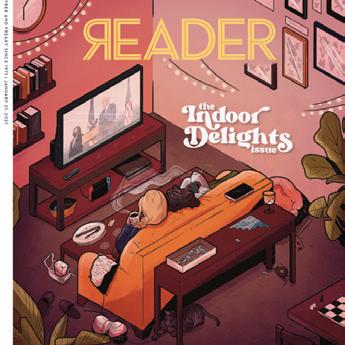
Music Issue: Festival Guide + Windy City Times Insert
Fall Arts Preview


Cannabis Special Section
50th Anniversary Issue 1
50th Anniversary Issue 2
Cannabis Special Section
Nonprofit Issue
Drinks Issue + WCT Insert
Year in Review










Book Club members receive an additional 10% off at the following stores:
The Book Cellar | 4736 N. Lincoln 60625 773-293-2665 | bookcellarinc.com
Bookie’s | 10324 S. Western 60643 312-890-3860 | bookiesbookstores.com
Bucket O’Blood Books and Records | 3182 N. Elston 60618 312-890-3860 | bucketoblood.com
The Dial Bookshop | 410 S. Michigan, 2nd Floor 60605 dialbookshop.com
Madison Street Books | 1127 W. Madison 60607 312-929-4140 | madstreetbooks.com
Pilsen Community Books | 1102 W. 18th St. 60608 312-478-9434 | pilsencommunitybooks.com
Roscoe Books | 2142 W. Roscoe 60618 773-857-2676 | roscoebooks.com
Semicolon | 515 N. Halsted 60642 312-877-5170 | semicolonchi.com
Seminary Co-Op Bookstore | 5751 S. Woodlawn 60637 773-752-4381 | semcoop.com

We’re continuing the conversation! Watch for the next Reader Cannabis Conversations on August 5, 2021


Space is limited. Reserve your spot now. For more information, contact ads@chicagoreader.com

Volumes Bookcafe | 1474 N. Milwaukee 60622 773-697-8066 | volumesbooks.com
Women & Children First | 5233 N. Clark 60640 773-769-9299 | womenandchildrenfirst.com

This yearlong partnership with independent bookstores is supported by the Poetry Foundation.



Mikki Kendall
Hood Feminism: Notes From the Women That a Movement Forgot
Author Talk: Oct. 22, 2020
Sonali Dev Recipe for Persuasion
Author Talk: Nov. 19, 2020
Riva Lehrer Golem Girl
Author Talk: Dec. 17, 2020
Emil Ferris
My Favorite Thing Is Monsters
Author Talk: Jan. 28, 2021
Eve Ewing
1919
Author Talk: Feb. 25, 2021
Nnedi Okorafor Remote Control
Author Talk: Mar. 25, 2021
Natalie Moore
The South Side
Author Talk: Apr. 22, 2021
Rebecca Makkai
The Great Believers
Author Talk: May 26, 2021
Fatimah Asghar
If They Come for Us
Author Talk: June 24, 2021
Presented by:
Learn
Kayla Ancrum
Darling
Author Talk: July 22, 2021
Jessica Hopper
The First Collection of Criticism by a Living Female Rock Critic
Author Talk: Aug. 26, 2021
Precious Brady-Davis
I Have Always Been Me: A Memoir
Author Talk: Sep. 23, 2021
Book Club membership includes:
Exclusive access to conversations between Authors and the Reader Discounts to your favorite independent bookstores



A curated monthly newsletter A members-only discussion forum






Special offers from Reader partners
Jessica Hopper is a music critic, producer, and author based in Chicago. In a career spanning more than 20 years, Hopper has earned acclaim as a provocative, fearless music journalist.
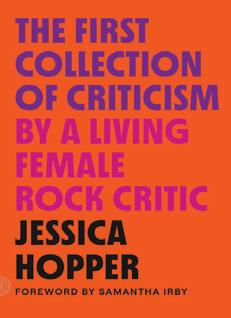
She has written for GQ, Rolling Stone, The New York Times Magazine, The Guardian, Elle, and Bookforum. She is a long-time contributor to the Chicago Reader, and she was also a columnist for the Village Voice, Chicago Tribune, and Punk Planet, as well as the music consultant for This American Life for eight years. Her first book, The Girls Guide To Rocking (Workman, 2009), was named a Notable Book for Young Readers by the American Library Association.
She is the author of The First Collection of Criticism By A Living Female Rock Critic and the 2018 music memoir Night Moves. She was formerly the editorial director at MTV News, and senior editor at Pitchfork and Rookie. Her essays have appeared in Best Music Writing for 2004, 2005, 2007, 2010, and 2011. She is series editor of The American Music Series at the University of Texas Press. In 2019, Hopper served as host and executive producer for KCRW’s popular music history podcast, Lost Notes. Her forthcoming books, No God But Herself: How Women Changed Music in 1975 (Fall 2022) and a revised and expanded second edition of The First Collection (2021), are both due from MCD/Farrar, Straus and Giroux.

Leor Galil serves as the Reader’s music writer. He began freelancing for the Reader in 2010, and joined the staff in 2012. In 2017, Reader readers voted him the third best pizza in Chicago. Smash Mouth is a fan of his work.
Presented by:

Northwestern Memorial Healthcare seeks Senior Systems Engineer for Chicago, IL location to provide technical guidance & support for computing systems & systems integration.
Bachelor’s in Comp Sci/ Electronics Eng/related field +7yrs exp req’d. Requires 7yrs w/Messaging & collaboration platform admin (incl design & implement); Admin & troubleshoot of Office365, Azure AD & ADConnect; AD FS; multi domain management; managing hybrid messaging & collaboration systems; managing multiple versions of Exchange server. Exp must incl: implement SSO w/MFA & conditional access policies; migration to Exchange Online. Requires rotating 24 hr on call availability. Background check & drug test req’d. Apply online: https:// jobs.smartrecruiters. com/NorthwesternMedicine/743999760352900 -senior-systems-engineer. Requisition ID: REF20955B EOE
Shampoo Assistant
ADMINISTRATIVE SALES & MARKETING
FOOD & DRINK
SPAS & SALONS
BIKE JOBS
GENERAL REAL ESTATE RENTALS FOR SALE
NON-RESIDENTIAL ROOMATES
GOODS SERVICES
HEALTH & WELLNESS INSTRUCTION
MUSIC & ARTS
NOTICES
MESSAGES
LEGAL NOTICES
ADULT SERVICES
General Flower Shop Help Wanted
Previous Experience Preferred, send resumes to info lasalle owers com 312-787-3680
Havensight Consulting Group is seeking a Sr. Consultant in Chicago, IL. Lead the solution design team and manage design process. onfigure S to design, develop and test client business requirements in SAP ABAP objects. Must live within normal commuting distance of Chicago and can work from home 2 days a week. Travel required up to 75% of time. Send resume via email to jobs@ havensightconsulting. com.
Medline Industries, Inc. has multi open’gs in Mundelein, IL for:
A) Developer Analysts III (ABAP) to dv’lp quality tchn’cal solut’ns using ABAP code, design’g, testing, implm’tg, maint’ng & supprt’g apps SW. On-call sup’rt for critical issues dur’g non-work’g hrs. Apply at: medline.taleo.net/careersection md confidential jobapply.ftl?lang=en&job=INF0100BB
B) Business Systems Analyst III (Sales Compensation) to collab w/ biz stakeholders to modernize Sales Comp MGMT. Apply at: medline. taleo.net/careersection/ md_confidential/jobapply.ftl?lang=en&job=INF0100B6
Upscale Multi-Cultural salon in the South Loop seeking shampoo assistants - outstanding opportunity to learn from top stylists. Flexible hours may include Tuesday - Saturday. Seeking hard workers with excellent customer service skills. Please send your resume, including hours of availability, to info@ vancleefhair.com
Financial Analyst
Quantitative research. Master’s in mathematical finance or rel +2yr exp. resume: RoboSig Inc 141 W Jackson Blvd #300A Chicago IL 60604
Groupon, Inc. is seeking a ERP Application Developer | Software Engineer in Chicago, IL w/the following responsibilities: Perform the dev of scripts and build integrations across the systems Apply at www. grouponcareers.com by searching keyword R25236
Private Driver/chauffeur
Required
We are Looking for a dri er chau eur re uired to transport our clients from their hotel to tourist attraction places To & fro. There is up to 50 hours a week available depending on candidates availability. if you are interested Contact us for more information Or send your Cv to insidesalepubs@gmail.com
Thoughtworks seeks Lead Infrastructure Consultant (Professional Services) to work in Chicago, IL & various unanticipated U.S. locations to lead the design, planning and execution of complex technical implementations for Infrastructure projects. Must have Bachelor’s in Computer Science, Computer or Electrical Engineering, Information Systems, or related field. Must have yrs e p in ob o ered, Consultant, Infrastructure Engineer, Developer, or related IT position. Must have at least 24 mos. exp (1) Automating infrastructure in at least one of the primary cloud providers (AWS, GCP, or Azure). Must have at least 12 mos. exp. (1) Playing a leading role in the design, planning and execution of complex technical implementations for Infrastructure as Code; (2) Setting up key delivery infrastructure across the entire lifecycle of software, including Continuous Delivery pipelines and Observability tooling for production operations; (3) Coaching and mentoring junior developers in all aspects of software developing, including Agile development methodologies; (4) Working on projects with distributed teams, including coordinating across countries and time zones.
Willingness to travel at least 80% across U.S. Send resume to ijobs@ thoughtworks.com w/ Job ID LICPS072021.
Masa Milling, Inc. seeks a Project Engineer. Mail resume 1703 Wolf Industrial Drive, Greenville, IL.
Veblenist, LLC. seeks an Accountant. Mail resume 1229 N. North Branch St, Ste 121, Chicago, IL.
C) Sr. Software Tester for QA test case dvlp & test’g. Apply at: medline. taleo.net/careersection/ md_confidential/jobapply.ftl?lang=en&job=INF0100B9
D) IS – Network Core Support Manager to oversee daily ops plan’g, maint’nce, sup’rt & trbleshoot’g for Datacenter & Campus Network & Telcom sys. Apply at: medline.taleo.net/careersection md confidential jobapply.ftl?lang=en&job=INF0100BA
No trvl; no telcomm for positions A thru D.
E) Director of Engineering to mange Eng Dept functions & imprv ops productivity. 20% Dom & Int’l trvl; no telcom. Apply at: medline. taleo.net/careersection/md_confidential/ jobapply.ftl?lang=en&job=ENG0100C9
(Waukegan, IL) Yaskawa America, Inc. seeks Software Engineer C w/ Bach or for deg equiv in EE, CE/EE; 2 mnths exp in ob o ered eng intern ship or wrk exp in SW devp or wrkng w/ variable freq drives, incl C or C++ prog lang & embedded SW design prin; design of contin & discrete time linear control syst; and circuit anal & ability to competently operate basic lab equip. Apply to HR, 2121 Norman Drive South, Waukegan, IL 60085.
StoneX Group Inc. seeks a Senior Developer (Job Code 524105) in Chicago, IL to engage in software development for financial ser ices web applications and to query underlying data sources with SQL server as a backend database. Mail resume referencing Job Code Job Code 524105 to Rosemary Carlson, StoneX Group Inc., 1251 NW Briarcliff Parkway, Suite 800, Kansas City, MO 64116. EOE.
Sr Software Engineer (Foot Locker Corporate Services, Inc.) (Chicago, IL): Resp for understandg biz inquiries for medium to high complexity analytics & to dvlop innovative analytic solutns aligning both data sci team & biz clients on approach. Will work w/ the product owner, dvlp user stories to define resrch plan using agile methodology. Reqs a Bachelor’s degree or foreign equiv in Comp Sci, or closely reltd field e s yrs of exp as a Sftwr Engnr or Dvlpr workg w/ lge scale biz apps. Exp must incl: Coding & designing lge scale Java/J2EE internet apps; Creatg RESTful API’s in a microsvcs envnmt; Handg release ops using Jenkins; Creating object orientated designs & Java/J2EE web srvcs using design patterns, Spring MVC; Workg in all phases of the Sftwr Dvlpmt Life Cycle (SDLC) according to Agile methodologies, incl Sprint/ Scrum; Assisting w/ srce code mgmt for dvlpd apps & dvlpg java-based solutns utilizg NoSQL databases; Workg on Java based apps utilizg relatnl databases such as Oracle. Send res via e-mail to jobkeeper@footlocker. com, subject line must provide Code SSEIL3918, or by mail to Foot Locker Corporate Services, Inc., Attn: M. Grund, Global Mobility Specialist, Code SSEIL3918, 330 W 34th St, NY, NY 10001.
Senior Systems Architect (Chicago, Illinois)
Defining, planning, & monitoring application support activities. Troubleshooting, performance/ETL job monitoring & resolution. Software installation & configuration, recommendation for error resolutions & root cause analysis. Manage the day-to-day operations of the IT group. MS in S, T, or related field or foreign equivalent. Will accept BS + 5 yrs rltd IT exp in lieu of educational reqs. Frequent travel & relocation may be required. Resumes: Platinum Consulting Services, 2425 W. Lawrence Ave, Chicago, IL 60625; EOE
SAP/TM CONSULTING MANAGER
Novigo, Inc. has multiple degreed/exp SAP/TM Consulting Manager positions available in Chicago, IL and various unanticipated locations throughout USA. Trvl Req’d 50%. 100% telecommuting permissible. To apply, send resume to Novigo at: recruitment@ novigo.com and reference the Ref#5373197. EEO.
Software Engineer(s): Collaborate w/stakeholders to understanding end users’ expectations. Document agenda, meeting minutes, ow charts, data ow, system architecture + create algorithms based on ow charts as part of creating solution to meet requirements. May require to travel/ telecommute. Mail CV to A. McGinty, RedMane Technology LLC, 8614 W Catalpa Ave, Ste. 1001, Chicago, IL 60656. Reference job code D703800076. E.O.E.
Underground Technology Team (UTT) Sales Representative (West Chicago, IL): Responsible for ensuring maximum market expansion by providing technical service advice for the MAPEI UTT product line. Mail CV/Cov ltr. to: Giuliana Lumia, Job Code G6687-00035, MAPEI Corporation, 530 Industrial Drive, West Chicago, IL, 60185. EOE.
International Equity Analyst (Chicago, Illinois) Research foreign companies naly e financial statements, assets, & accounting practices. Draft reports financial mod els. Examine economic market trends & earning prospects. Ensure compliance regulations are met. Occasional travel & fluency in Japanese required. MS in Business, Commerce, Finance, or related or foreign eq.
Resume: Anthropocene Capital Management, LLC, 515 N. State St, Ste 300, Chicago, IL, 60654; EOE
Director of Financial Consulting Electronic Knowledge Interchange Company Chicago, IL
Lead consultants in identifying, analyzing and qualifying the financial benefits to technology solutions for small to medium sized businesses. Lead the consultants in the analysis of both finan cial and technical client data. Execute site visits in order to conduct client interviews and gather and review client documentation. Must have a Masters Degree in Business Administration or a related field. Must have one (1) year of experience as a Business Analyst or Operations Research Analyst. Must include experience with operational modeling and data analysis, requirement analysis using simulation models, and budget and income statement forecast analysis. If qualified, please e-mail your resume to us at lgriffin eki consulting com. Please reference Job: DFC0621.
TransUnion, LLC seeks Managers for Chicago, IL location to supervise & manage sw developer positions. Master’s in Comp Sci/Comp Eng/related field 2yrs e p or ach elor’s in Comp Sci/Comp Eng/related field +5yrs exp req’d. Req’d skills: Full systems life cycle dev; data conversion & integration to Ab Initio; data analyses, data validation, & data quality assurance; ETL Design & Dev; Unit testing; Integration & System testing; UAT support; Hive Sqoop; Spark; C; SQL/PLSQL; Python; Bash; R studio; Agile; Oracle 10g; DB2; MySQL; Teradata; Unix; Linux; Shell Scripting; Abinitio; Tableau; Shiny; Dremio. 20% telecommuting permitted. Send resume to: A. Goodpasture, REF: HMR, 555 W Adams, Chicago, IL 60661
Senior Software Developer Electronic Knowledge Interchange Company
Chicago, IL
Participate actively in the complete software development lifecycle, including performance analysis, design, development, and testing. Engineering of RESTful web services & APIs using Spring Boot (Spring MVC) and deployed as micro-services. Design and develop Java Restful web service that communicates with the Oracle database in the back-end and returns Json format data using Spring, Jersey Restful, JAX-RS, JPA. Requires a Masters Degree in Computer Science, Electrical Engineering, or a related field. Must have one (1) year of experience as a Software Developer. Must also have one (1) year of experience with Spring Boot, Microservices, Spring Integration, Pivotal loud f ualified, please e-mail your resume to us at lgriffin eki consulting com. Please reference Job: SSD0721.
DRW Holdings LLC has openings in Chicago, IL for the following positions: Quantitative Researchers (Position ID QR/IL/W031) to conduct quantitative analysis across multiple asset classes. Sr Database Engineer (Position ID DE/IL/A032) to govern / manage data storage and data used for research and analysis by Agriculture Trading team globally. Mail resume to DRW Holdings LLC, 540 W. Madison St. #2500, Chicago, IL 60661, Attn: M. MOODY. Must ref. Position ID when applying for position to ensure consideration for the proper position. EOE.
Hyatt Corporation seeks a Property Systems (Opera) Support Engineer in Chicago, IL to provide third level technical support and customer service on Opera Property Management System (“PMS”) to our Hyatt hotels. BS & 5yrs or No degree & 8yrs. To apply, submit cover letter and resume to: Hyatt Corporation, Attn: Araseli Rivera, 150 N Riverside Plaza, Floor 14, Chicago, IL 60606
Vail Systems, Inc. seeks Sr. Software Engineer (Chicago, IL) to develop next generation enterprise communications solutions designed for SaaS/Cloud, traditional premise-based, & hybrid architectures. Telecommuting permitted. Submit resume to hr@ vailsys.com & reference Job # PB3304050.
Sinai Medical Group seeks Psychiatrist for Holy Cross Hospital (Chicago, IL): Conduct mental health medical exams & prescribe, direct or administer psychotherapeutic treatments or meds. Reqs. med. degree, IL physician lic. & 3 yrs of residency training in psychiatry. Mail CV to F. Copeland, HR, 1500 S airfield e, hicago, 60608.
(Itasca, IL) Fellowes, Inc. seeks Senior Oracle EBS Functional Analyst w/ Bach or for deg equiv in Info Tech, Mngnt Tech, S, Eng or rld d yrs e p in ob o ered or e p w/ Oracle Finan Modules (General Ledger, A/P & A/R) & ORACLE EBS or ERP R12, incl SQL; Order Mngnt; Fusion Financial Cloud; wkng w/in a retail, manuf or distrib environ; & wkng w/ global clients. Apply to: HR, 1789 Norwood Avenue, Itasca, IL 60143
(Lincolnshire, IL) Nexus Pharmaceuticals Inc. seeks Lead Scientist, Formulation Development w/ PhD in Pharmaceutics, Polymer Chem, Biochem Eng or rltd fld yrs e p in ob o ered or w/ sci prin & concepts. Also acceptable MS or for deg equiv in Pharmaceutics, Polymer Chem, Biochem Eng or rltd d yrs e p in ob offered or w/ sci prin & concepts. Must have 5 yrs formulation devp exp in generic pharm ind; 5 yrs in FDA regul guidnce, ICH guidelnes & reqs of ANDA submissions; 2 yrs in patents, pharmacokinetics & biopharmaceutics; & 5 yrs in pharm dosage forms incl controlled release drug deliv; & 5 yrs in good manuf pract. Apply to HR, 400 Knightsbridge Pkwy, Lincolnshire, IL 60069
The Northern Trust Company seeks a Specialist, Applications to manage a Transformation unit or division to deliver large-sale transformational initiatives. Manage a group working to increase Agile acumen, develop and enhance intellectual property, and standardize processes to achieve the greatest business value. Drive initiatives involving tool and technology change, adoption of agile methods, and project delivery operation model change. Participate in developing a division strategic plan and setting goals and priorities based on the direction set for the unit. Make staffing decisions, manage expenses, and conduct the salary review process for the division. Coach the team on developing a culture of continuous learning and improvement. Position requires a Bachelor’s degree in Computer Science, Engineering, Information Systems, or a directly related STEM field, followed by 10 years of progressively responsible experience in IT project delivery, including programming analysis and systems design, within the Financial Services industry. Experience must include a minimum of: 5 years of experience with software development lifecycle, including planning, development, quality assurance, change management, and release management; 5 years of experience carrying out complex change initiatives involving multiple disciplines; 5 years of experience with Agile frameworks and methodologies including Scrum, Kanban, XP, and SAFe; 5 years of experience with Agile Lifecycle Management tools; and 5 years of experience with Java, J2EE, Ant, CI/CD, J2EE design patterns, JAXWS, JAXB, JMS, JSON, Maven, MQ Series/ Kafka, MS SQL/Oracle, PL/SQL, REST, Spring, Spring Boot, Tomcat, and WebLogic. Job location: Chicago, IL. To apply, please visit https://careers.northerntrust.com and enter job requisition number 21069 when prompted. Alternatively, please send your resume, cover letter, and a copy of the ad to: S. Schachter, 50 S. LaSalle St., Chicago, IL 60603.
The Northern Trust Company seeks a Fixed Income Portfolio Manager to develop and monitor bond portfolios for a variety of individual
and institutional clients and funds. Implement portfolio strategy through security selection, sector allocation, and duration decisions in relation to the portfolio performance index and current fixed income policy. Guide small and medium size bond portfolio assets for fiduciary and agency accounts, high net worth individuals, pension accounts, and common funds to achieve superior performance. Advise clients in developing investment objectives and guidelines in consideration of risk tolerance, tax liabilities, and income needs. Develop portfolio structure based on economic variables in conjunction with the investment objectives of clients. Prepare analyses of bond portfolios for existing and potential clients in furtherance of company’s business. Position requires a Bachelor’s degree or its equivalent in Business Administration, Finance, Economics, or a related field, and 3 years of experience conducting analysis or management of fixed income investments. Experience must include a minimum of:
3 years of experience with financial markets, including portfolio management and trading;
2 years of experience planning and implementing portfolio structure and strategy based on market conditions and economic factors;
2 years of experience implementing investment strategies with regard to specific trades;



2 years of experience with applying statistical and quantitative methods in analyzing financial data;
2 years of experience using Micro and Mainframe computer applications to manage portfolios/ funds and to generate reports;
2 years of experience with financial and market data analysis using Aladdin Explore, Bloomberg, Bloomberg PORT Optimizer, BQNT, BQuant, Excel VBA, Portfolio Construction and Portfolio Risk Tools, and Yieldbook; and
2 years of experience with trading tools including Aladdin OMS, Bloomberg, Market Axess, and Trade Web. Any suitable combination of education, training, or experience is acceptable.
Job location: Chicago, IL. To apply, please visit https://careers.northerntrust.com and enter job requisition number 21068 when prompted. Alternatively, please send your resume, cover letter, and a copy of the ad to:
S. Mohan 50 S. LaSalle St., Chicago, IL60603
The Northern Trust Company seeks a Senior Consultant, Applications to design, build, and test software applications and solutions. Define technical system requirements for complex data processing and software development projects. Collaborate with cross-functional users to analyze business needs, create prototypes, and develop user-friendly software applications. Test and maintain computer programs, including designing, coding, and debugging. Conduct feasibility studies and design system requirements for complex data processing projects. Perform strategic planning and long-range direction for technology usage and enhancements across the business units. Position requires a Bachelor’s degree in Computer Science, Engineering, Information Systems, or a related STEM field, followed by 5 years of progressively responsible experience with software design, development, testing, and implementation. Experience must include a minimum of: 5 years of experience with coding and debugging software applications; 5 years of experience with capturing business requirements and transforming requirements into technical specifications in the financial services industry; 5 year of experience with conducting feasibility studies for complex data processing projects and preparing project phase reports; 5 years of experience with AngularJS, Ajax, CSS, CVS, DB2, Git, HTML, Integration Testing, Java, JavaScript, JBoss, Jenkins/Bamboo, J2EE, JQuery, JSP, object oriented software design and development, Oracle, ReactJs, SDLC, Spring, Unit Testing, Websphere, and XML; and 3 years of experience working on a cloud based microservices architecture with an emphasis on test driven development, continuous integration, continuous delivery, automation, and DevOps. Job location: Chicago, IL. To apply, please visit https://careers.northerntrust.com and enter job requisition number 21067 when prompted. Alternatively, please send your resume, cover letter, and a copy of the ad to: M. Pikul 50 S LaSalle St., Chicago, IL 60603
Have you had an unwanted sexual experience since age 18? you tell someone in your life about it who is also willing to participate?
Women ages 18+ who have someone else in their life they told about their experience also willing to participate will be paid to complete a confidential online research survey for the Women’s Dyadic Support Study. Contact Dr. Sarah Ullman of the University of Illinois at Chicago, Criminology, Law, & Justice Department at ForWomen@ uic.edu, 312-996-5508. Protocol #2021-0019.
Armitage & California, Rehabbed 3Bedroom Apartment Second floor, New Bathroom New Stove New Refrigerator New Granite Countertop on Cabinets Hardwood Floors Throughout Laundry on premises, Separate Utilities, $200 Non-Refundable movein fee per person, No Security deposit, No Pets, Rent $1,600 Per month For Information 773-470-8298
Bucktown : 1922 N Wilmot, 4 RMS, 2BR, Blk from “Blue Line L”. Modern kitchen & bath. Hardwood floors. Free Laundry. $1300 + security . Avail 5/1. No Pets. Call (773) 317-3389
CLEANING SERVICES

CHESTNUT ORGANIZING AND CLEANING SERVICES: especially for people who need an organizing service because of depression, elderly, physical or mental challenges or other causes for your home’s clutter, disorganization, dysfunction, etc. We can organize for the downsizing of your current possessions to more easily move into a smaller home. With your help, we can help to organize your move. We can organize and clean for the deceased in lieu of having the bereaved needing to do the preparation to sell or rent the deceased’s home. We are absolutely not judgmental; we’ve seen and done “worse” than your job assignment. With your help, can we please help you? Chestnut Cleaning Service: 312-332-5575. www.ChestnutCleaning. com
WANT TO ADD A LISTING TO OUR CLASSIFIEDS?
Email details to classified-ads@chicagoreader.com





ebrate the 50th anniversary of the Chicago Reader, we’d love to hear from you! Did you date around, or meet a partner/lover/friend through Reader Matches, Personals, or Missed Connections? If you’re willing to share your story, contact tallen@ chicagoreader.com or @itstarynallen on Twitter.
















235 pages / perfect bound / 5.5” x 8.5” size
Available in paperback and PDF download
Ben Joravsky’s Greatest Hits is a collection of profiles and features handpicked by Ben from his 40 years of writing for the Reader. Each article offers a distinctive portrait of an activist, politician, writer, or sports personality who has left an indelible imprint on Chicago.




chicagoreader.com/store





Caring for students today, tomorrow, together.*

Now Hiring School Bus Drivers in Maywood, IL!


We are proud to offer: $18.25-$21.75/HR Starting Wage*, $2,500-$3,000 Sign-On Bonus*, Paid CDL Training & More!


You’re Invited! Join us Monday through Friday from 8:00 am to 1:00 pm at 1207 S. Greenwood Ave. There will be the opportunity to complete an online application and an on-site interview!

Questions? 708-345-5502 1207 S. Greenwood Ave., Maywood, Illinois, 60153 No experience necessary! We train!
Apply Online Today! workatfirst.com or text your ZIP code to “BUSES” (28737) & opt-in to receive a direct link to apply at the location!
Equal Opportunity Employer
*Conditions


